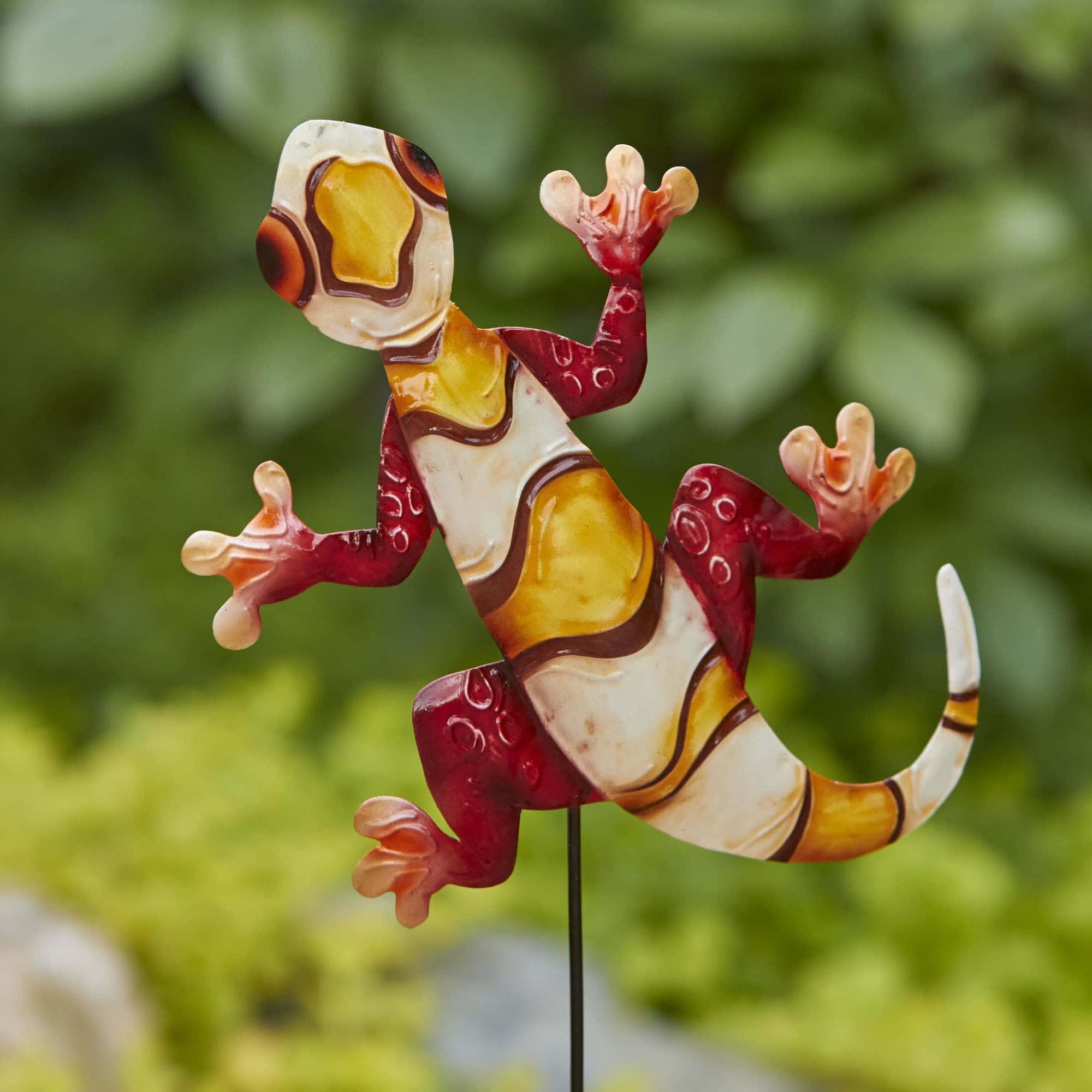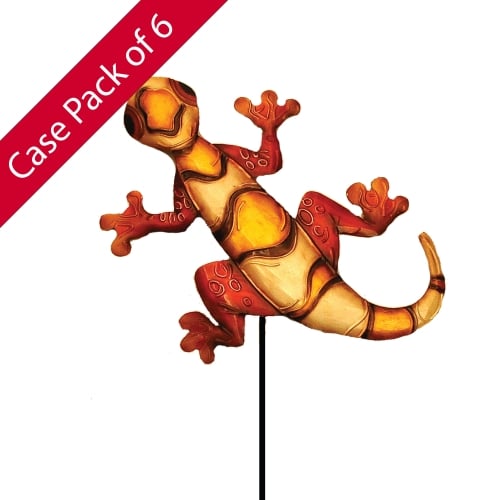-
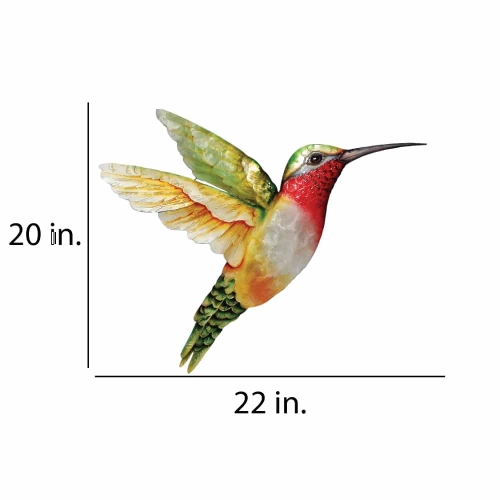
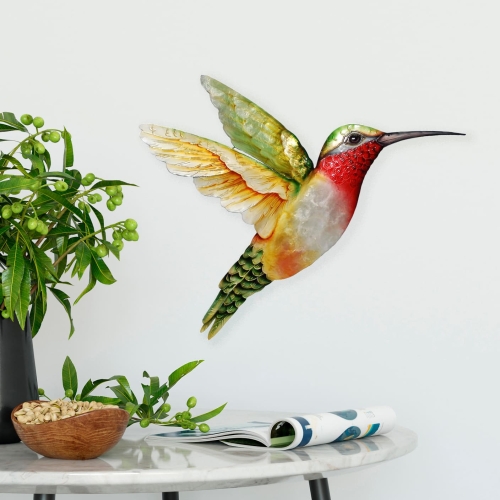 This hummingbird is inspired by many different species. The artist captures the colors and grace of a hummingbird in mid-flight. Its chest is adorned with capiz shell, which is then hand-painted to the magnificent colors seen in many species. This hummingbird brings a sense of purpose as it flies from flower to flower. The basic frame of the hummingbird is created using tin, which is powder coated with a black finish. The frame is reinforced using tin wire along the inner edge. Capiz is an oyster shell and the primary purpose of the oyster is as a source of food. However, the by-product, the shell, can be used for decoration. Due to it being a natural material, the natural colors of the capiz come through as tans and browns underneath the paint. The shell is then painted the bold colors you see. The entire front facing piece is carefully hand-painted keeping in mind the reflective qualities in the color of hummingbirds.
This hummingbird is inspired by many different species. The artist captures the colors and grace of a hummingbird in mid-flight. Its chest is adorned with capiz shell, which is then hand-painted to the magnificent colors seen in many species. This hummingbird brings a sense of purpose as it flies from flower to flower. The basic frame of the hummingbird is created using tin, which is powder coated with a black finish. The frame is reinforced using tin wire along the inner edge. Capiz is an oyster shell and the primary purpose of the oyster is as a source of food. However, the by-product, the shell, can be used for decoration. Due to it being a natural material, the natural colors of the capiz come through as tans and browns underneath the paint. The shell is then painted the bold colors you see. The entire front facing piece is carefully hand-painted keeping in mind the reflective qualities in the color of hummingbirds. -
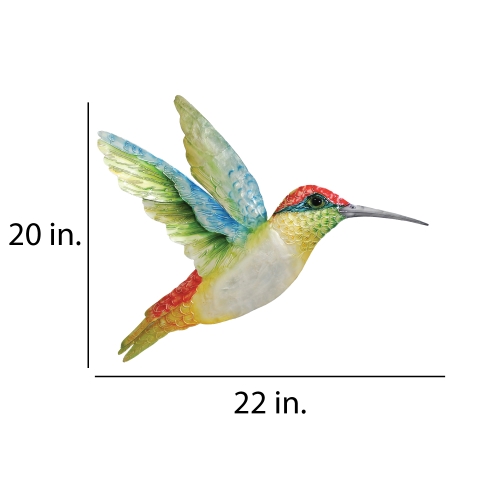
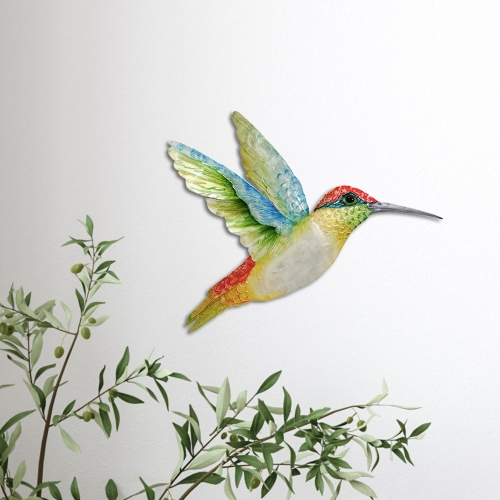 To some, sighting a hummingbird signals that challenging times are over and healing can begin. To others, these tiny fliers are an inspiring sign of hope and good luck. Hummingbirds also can have a mystical significance and mean the spirit of a loved one is near. The artist captures the colors and grace of a hummingbird in mid-flight. Its chest is adorned with capiz shell, which is then hand-painted to the magnificent colors seen in many species. This hummingbird brings a sense of purpose as it flies from flower to flower. The basic frame of the hummingbird is created using tin, which is powder-coated with a black finish and makes this piece safe to use outdoors. The edges of the frame are reinforced using thicker tin wire. The front of this piece is adorned in areas with capiz shell, an oyster native to the Philippines, before being hand-painted and sealed with a water-based sealant. The primary purpose of this oyster to provide a source of food, however, the shell is a sustainable by-product that can be used for decoration. The capiz shell subtly replicates the reflective qualities of hummingbirds in nature. The entire piece is lightweight and has an eyelet in the back allowing it to be hung using a finishing nail, command strip, or a push pin. Due to it being a natural material, the organic colors of capiz come through as tans and browns underneath the paint.
To some, sighting a hummingbird signals that challenging times are over and healing can begin. To others, these tiny fliers are an inspiring sign of hope and good luck. Hummingbirds also can have a mystical significance and mean the spirit of a loved one is near. The artist captures the colors and grace of a hummingbird in mid-flight. Its chest is adorned with capiz shell, which is then hand-painted to the magnificent colors seen in many species. This hummingbird brings a sense of purpose as it flies from flower to flower. The basic frame of the hummingbird is created using tin, which is powder-coated with a black finish and makes this piece safe to use outdoors. The edges of the frame are reinforced using thicker tin wire. The front of this piece is adorned in areas with capiz shell, an oyster native to the Philippines, before being hand-painted and sealed with a water-based sealant. The primary purpose of this oyster to provide a source of food, however, the shell is a sustainable by-product that can be used for decoration. The capiz shell subtly replicates the reflective qualities of hummingbirds in nature. The entire piece is lightweight and has an eyelet in the back allowing it to be hung using a finishing nail, command strip, or a push pin. Due to it being a natural material, the organic colors of capiz come through as tans and browns underneath the paint. -
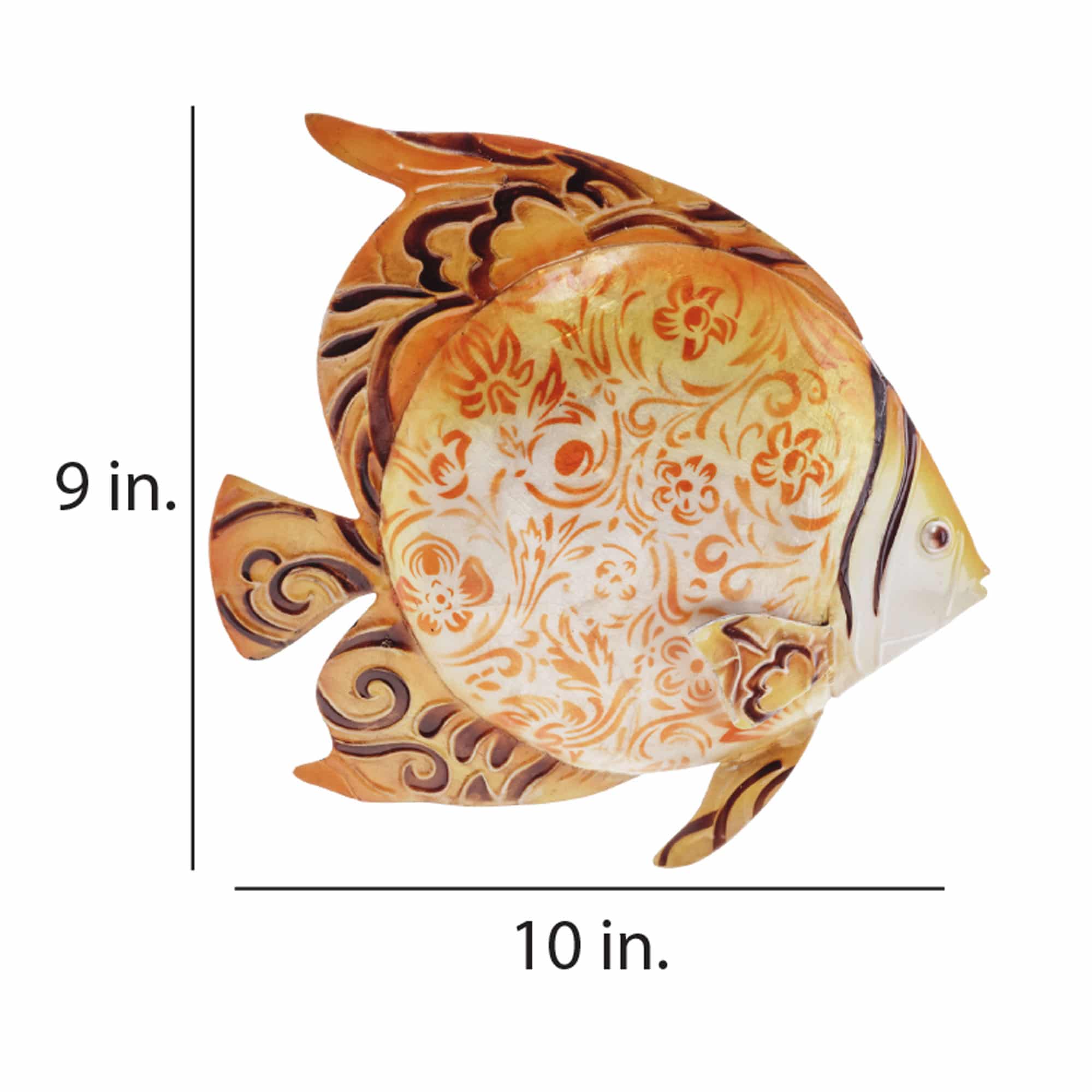
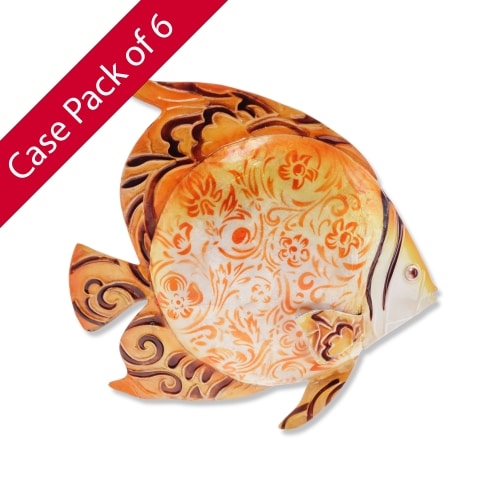 Case of 6 It's big. It's round and it's called an Opah. It looks like a goldfish that seriously outgrew its bowl. The Opah's bright orange is represented in this piece. Instead of spots, the artist took license and painted intricate floral patterns on top of capiz shells. The artist continues by pressing patterns into the tin both in the fins and the face of this magnificent fish. The basic frame of the wall fish is created using tin, which is powder coated as a black finish. The frame is reinforced using wrought iron wire along the inner edge. Capiz is an oyster shell and the primary purpose of the oyster is as a source of food. However, the by-product, the shell, can be used for decoration. Due to it being a natural material, the natural colors of the capiz can come through as tans and browns underneath the paint.
Case of 6 It's big. It's round and it's called an Opah. It looks like a goldfish that seriously outgrew its bowl. The Opah's bright orange is represented in this piece. Instead of spots, the artist took license and painted intricate floral patterns on top of capiz shells. The artist continues by pressing patterns into the tin both in the fins and the face of this magnificent fish. The basic frame of the wall fish is created using tin, which is powder coated as a black finish. The frame is reinforced using wrought iron wire along the inner edge. Capiz is an oyster shell and the primary purpose of the oyster is as a source of food. However, the by-product, the shell, can be used for decoration. Due to it being a natural material, the natural colors of the capiz can come through as tans and browns underneath the paint. -
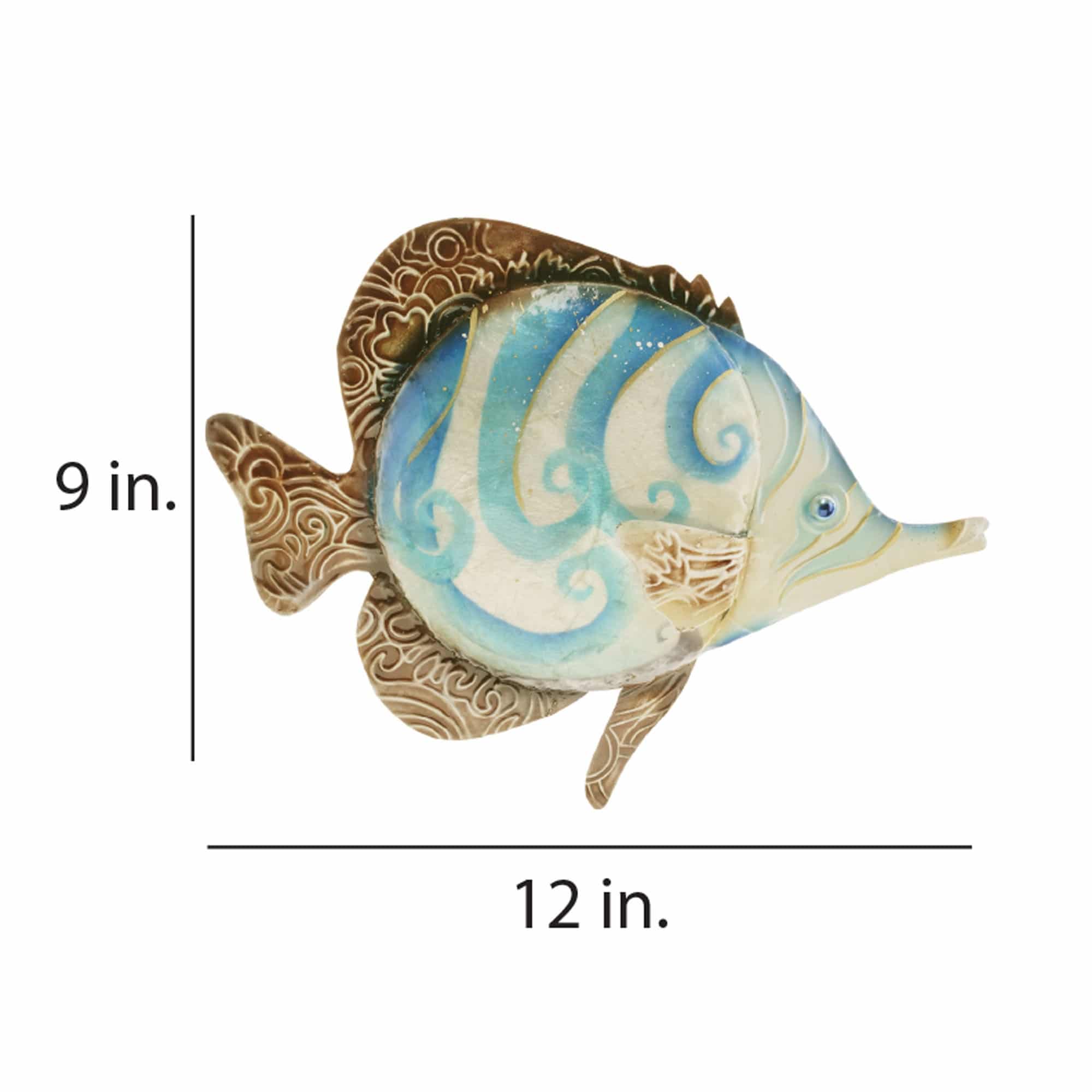
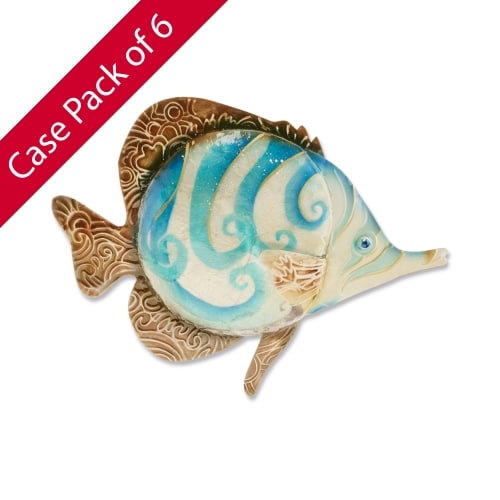 Case of 6 This fish was inspired by the Copperband Butterfly Fish. Though the name is a mouthful, the artist did capture the strips, colors, broad fins, and the beak that this fish is known for. The blue and pearl swirls contrast with its deeper bronze fins. Those fins are further enhanced with a swirled design, creating a very complex piece. The results is a piece rich in design and color. The basic frame of the wall fish is created using tin, which is powder coated as a black finish. The frame is reinforced using wrought iron wire along the inner edge. Capiz is an oyster shell and the primary purpose of the oyster is as a source of food. However, the by-product, the shell, can be used for decoration. Due to it being a natural material, the natural colors of the capiz can come through as tans and browns underneath the paint.
Case of 6 This fish was inspired by the Copperband Butterfly Fish. Though the name is a mouthful, the artist did capture the strips, colors, broad fins, and the beak that this fish is known for. The blue and pearl swirls contrast with its deeper bronze fins. Those fins are further enhanced with a swirled design, creating a very complex piece. The results is a piece rich in design and color. The basic frame of the wall fish is created using tin, which is powder coated as a black finish. The frame is reinforced using wrought iron wire along the inner edge. Capiz is an oyster shell and the primary purpose of the oyster is as a source of food. However, the by-product, the shell, can be used for decoration. Due to it being a natural material, the natural colors of the capiz can come through as tans and browns underneath the paint. -
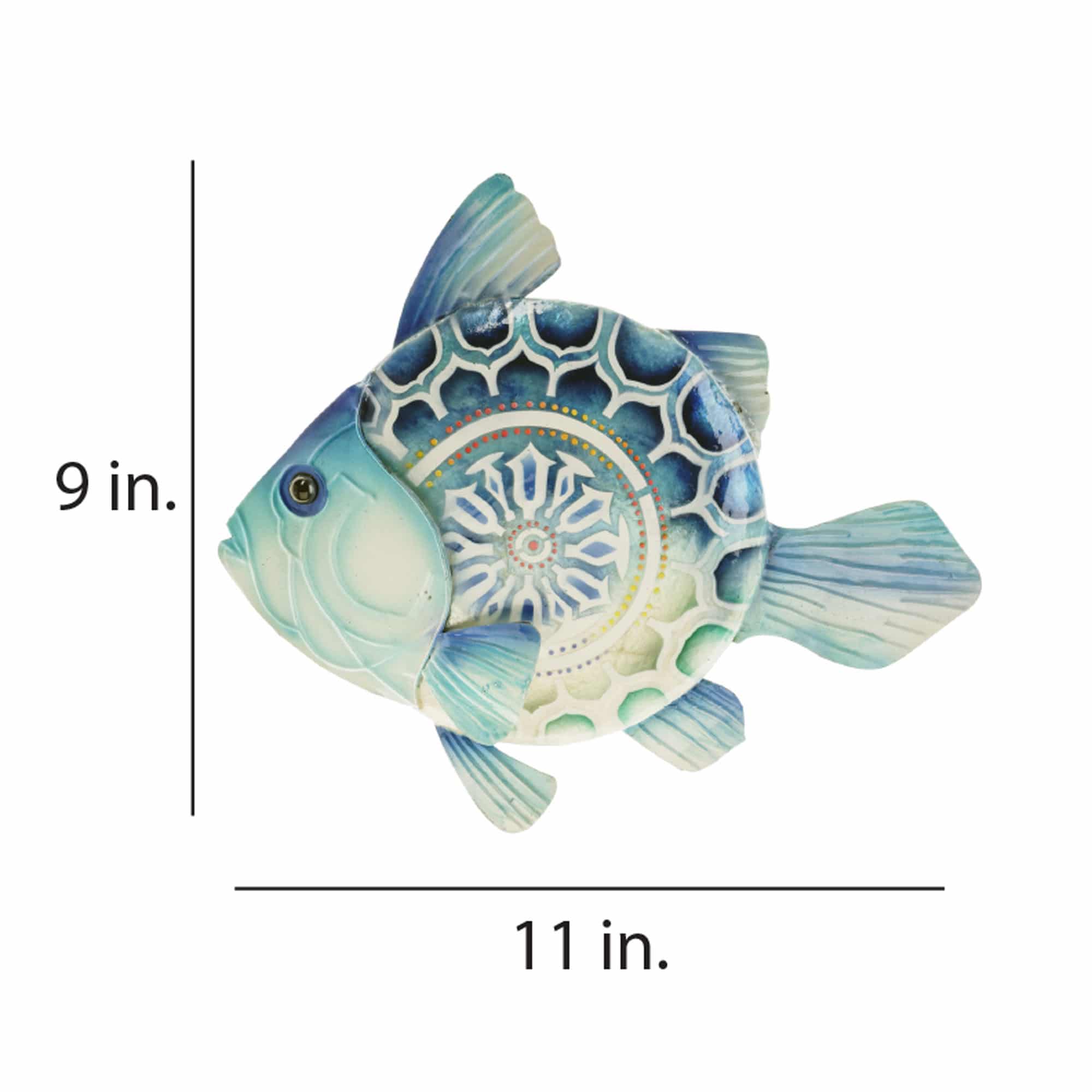
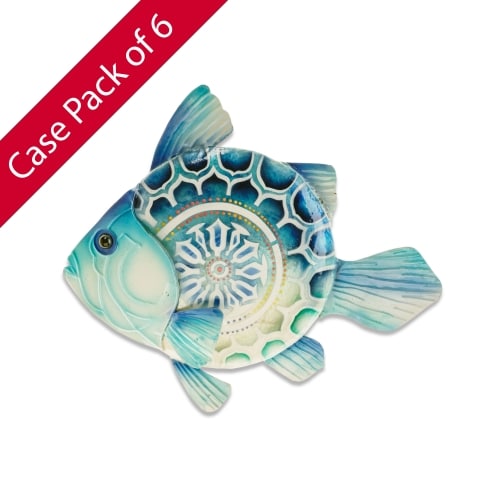 Case of 6 This fish is an artist's interpretation of the blue sea bass. The rich blue tones are common not only on the fish, but also the water within which it resides. The spiky fines and the scaly skin are also captured by the artist. The center of the fish is most interesting as it is adorned with capiz shell, which is hand-painted in wavy lines, representing the movement of the ocean as well as the fish. This piece will bring in color and design to your space and a smile to your face. The basic frame of the wall fish is created using tin, which is powder coated as a black finish. The frame is reinforced using wrought iron wire along the inner edge. Capiz is an oyster shell and the primary purpose of the oyster is as a source of food. However, the by-product, the shell, can be used for decoration. Due to it being a natural material, the natural colors of the capiz can come through as tans and browns underneath the paint.
Case of 6 This fish is an artist's interpretation of the blue sea bass. The rich blue tones are common not only on the fish, but also the water within which it resides. The spiky fines and the scaly skin are also captured by the artist. The center of the fish is most interesting as it is adorned with capiz shell, which is hand-painted in wavy lines, representing the movement of the ocean as well as the fish. This piece will bring in color and design to your space and a smile to your face. The basic frame of the wall fish is created using tin, which is powder coated as a black finish. The frame is reinforced using wrought iron wire along the inner edge. Capiz is an oyster shell and the primary purpose of the oyster is as a source of food. However, the by-product, the shell, can be used for decoration. Due to it being a natural material, the natural colors of the capiz can come through as tans and browns underneath the paint. -
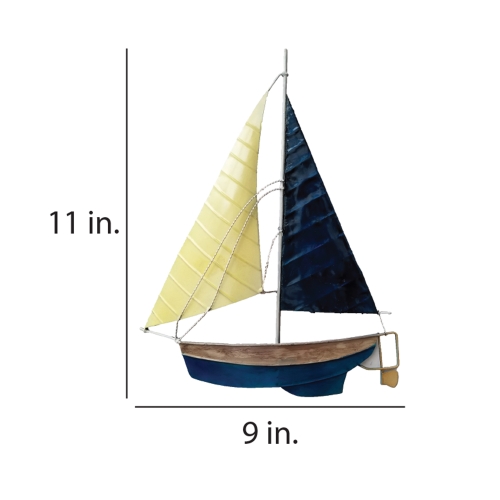
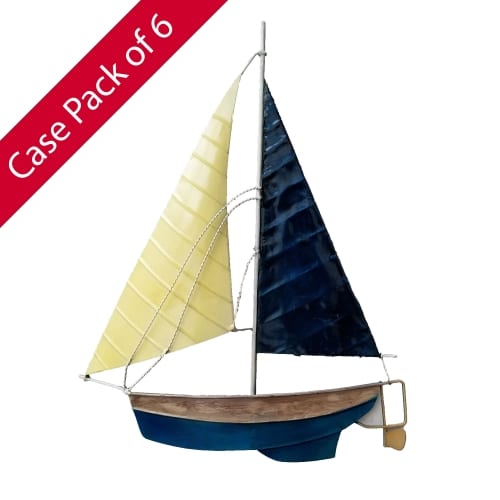 Case of 6 The sailboat is a common and familiar scene at most beaches. The Yellow Blue and Gray Sailboat Wall Decor brings home the well-known features of this iconic boat. The spinnaker is fully inflated and pops away from the wall with the rope tangling on the side. The headsail, usually the more colorful, is adorned with capiz shell which gives it a shine as it reflects the sunlight. The artist enhances the authenticity of the hull by painting it with a distressed finish, showing a well loved and traveled vessel. The basic frame of the wall sailboat is created using wrought iron, which is powder coated in a black finish. The frame is reinforced using wrought iron wire inner edge or outer edge. Capiz is an oyster shell and the primary purpose of the oyster is as a source of food. However, the by-product, the shell, can be used for decoration. Due to it being a natural material, the natural colors of the capiz can come through as tans and browns underneath the paint. The final step is to hand-paint the sailboat, giving this piece a rustic finish and feel.
Case of 6 The sailboat is a common and familiar scene at most beaches. The Yellow Blue and Gray Sailboat Wall Decor brings home the well-known features of this iconic boat. The spinnaker is fully inflated and pops away from the wall with the rope tangling on the side. The headsail, usually the more colorful, is adorned with capiz shell which gives it a shine as it reflects the sunlight. The artist enhances the authenticity of the hull by painting it with a distressed finish, showing a well loved and traveled vessel. The basic frame of the wall sailboat is created using wrought iron, which is powder coated in a black finish. The frame is reinforced using wrought iron wire inner edge or outer edge. Capiz is an oyster shell and the primary purpose of the oyster is as a source of food. However, the by-product, the shell, can be used for decoration. Due to it being a natural material, the natural colors of the capiz can come through as tans and browns underneath the paint. The final step is to hand-paint the sailboat, giving this piece a rustic finish and feel. -
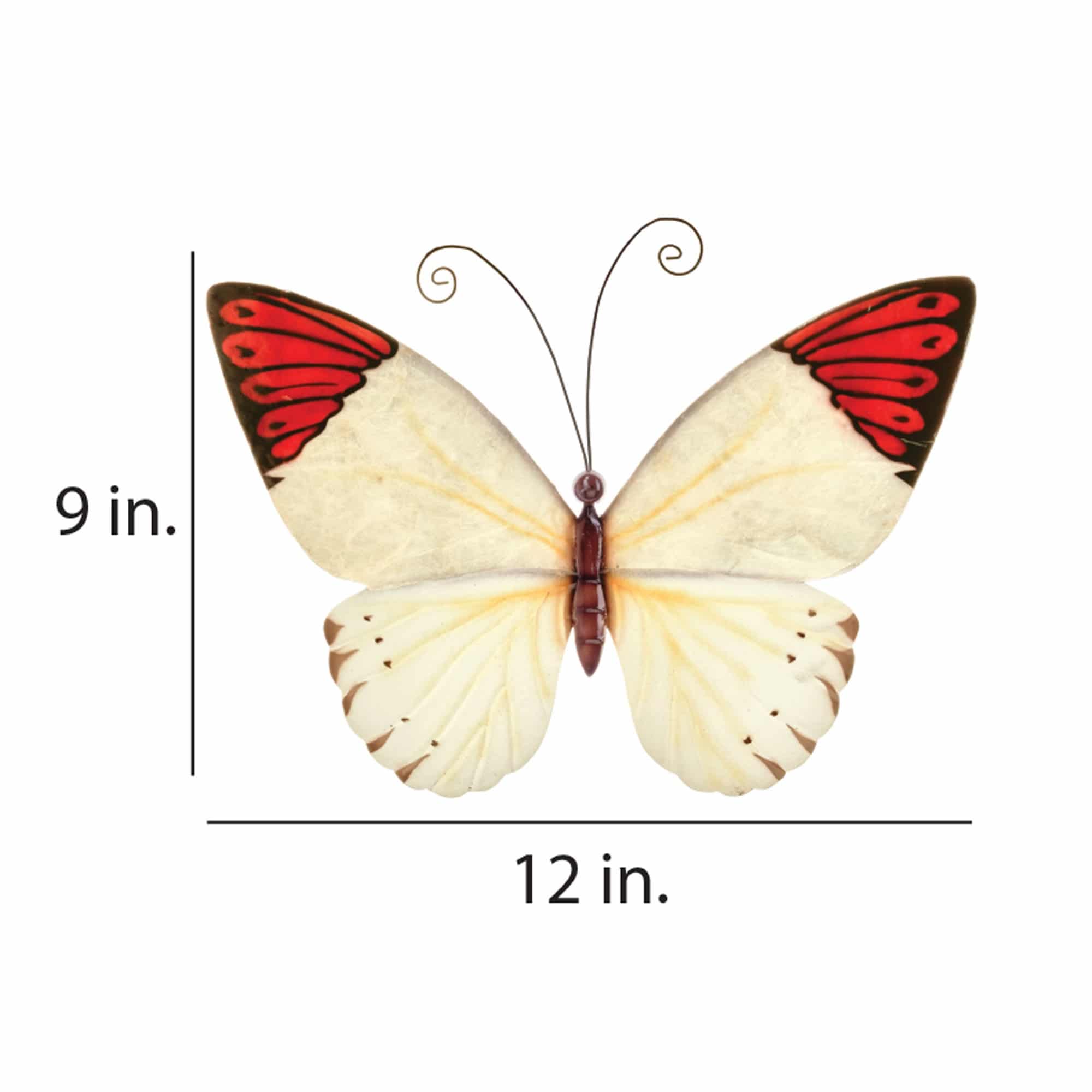
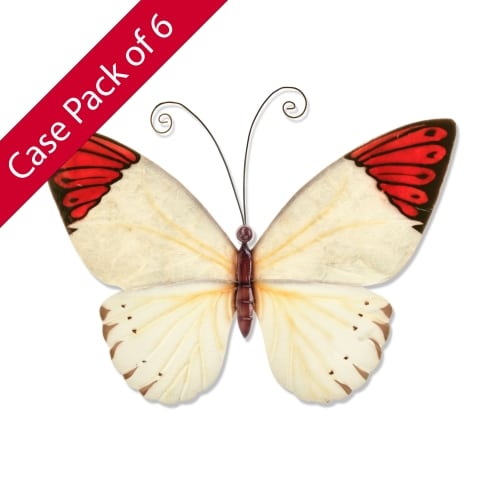 Case of 6 Starting with a base color of pearl white, the artist uses different techniques and splashes of color to craft a distinctive piece. The upper wings are created using capiz oyster shell, left natural to bring in different natural hues. The red base color is accented using brown feathering patterns. The lower portion of the wing is made of tin, textured to highlight the lines that stem from the body of the butterfly. The basic frame of the butterfly is created using tin, which is powder-coated with a black finish and makes this piece safe to use outdoors. The edges of the frame are reinforced using thicker tin wire. The front of this piece is adorned in areas with capiz shell, an oyster native to the Philippines, before being hand-painted and sealed with a water-based sealant. The primary purpose of this oyster to provide a source of food, however, the shell is a sustainable by-product that can be used for decoration. The capiz shell subtly replicates the reflective qualities of butterflies in nature. The entire piece is lightweight and has an eyelet in the back allowing it to be hung using a finishing nail, command strip, or a push pin. Due to it being a natural material, the organic colors of capiz come through as tans and browns underneath the paint.
Case of 6 Starting with a base color of pearl white, the artist uses different techniques and splashes of color to craft a distinctive piece. The upper wings are created using capiz oyster shell, left natural to bring in different natural hues. The red base color is accented using brown feathering patterns. The lower portion of the wing is made of tin, textured to highlight the lines that stem from the body of the butterfly. The basic frame of the butterfly is created using tin, which is powder-coated with a black finish and makes this piece safe to use outdoors. The edges of the frame are reinforced using thicker tin wire. The front of this piece is adorned in areas with capiz shell, an oyster native to the Philippines, before being hand-painted and sealed with a water-based sealant. The primary purpose of this oyster to provide a source of food, however, the shell is a sustainable by-product that can be used for decoration. The capiz shell subtly replicates the reflective qualities of butterflies in nature. The entire piece is lightweight and has an eyelet in the back allowing it to be hung using a finishing nail, command strip, or a push pin. Due to it being a natural material, the organic colors of capiz come through as tans and browns underneath the paint. -
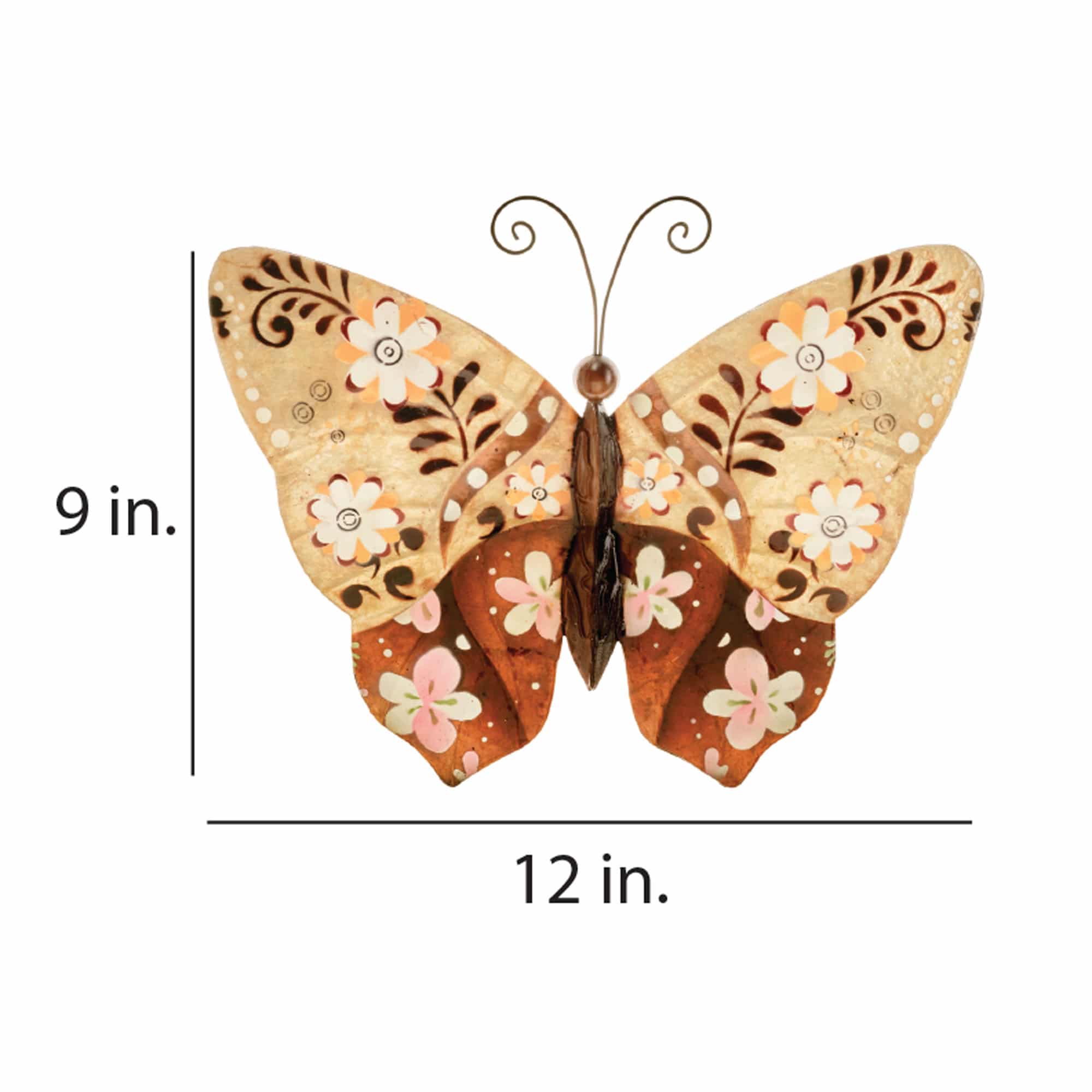
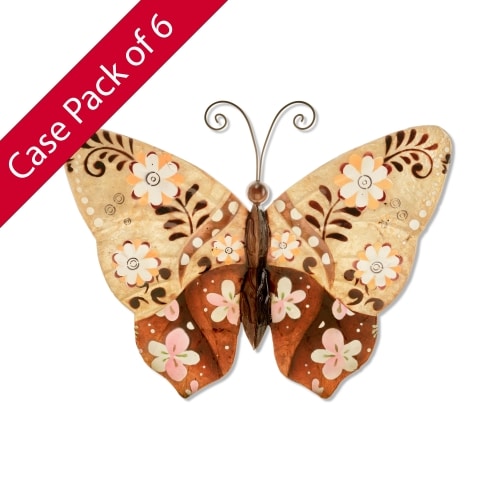 Case of 6
Case of 6With its warm earth and cream tones, this butterfly features whimsical flowers with sophisticated patterns. Calming and soothing, the understated elegance enhances its surroundings with the beauty of pattern and texture.
The basic frame of the butterfly is created using tin, which is powder-coated with a black finish and makes this piece safe to use outdoors. The edges of the frame are reinforced using thicker tin wire. The front of this piece is adorned in areas with capiz shell, an oyster native to the Philippines, before being hand-painted and sealed with a water-based sealant. The primary purpose of this oyster to provide a source of food, however, the shell is a sustainable by-product that can be used for decoration. The capiz shell subtly replicates the reflective qualities of butterflies in nature. The entire piece is lightweight and has an eyelet in the back allowing it to be hung using a finishing nail, command strip, or a push pin. Due to it being a natural material, the organic colors of capiz come through as tans and browns underneath the paint.
-
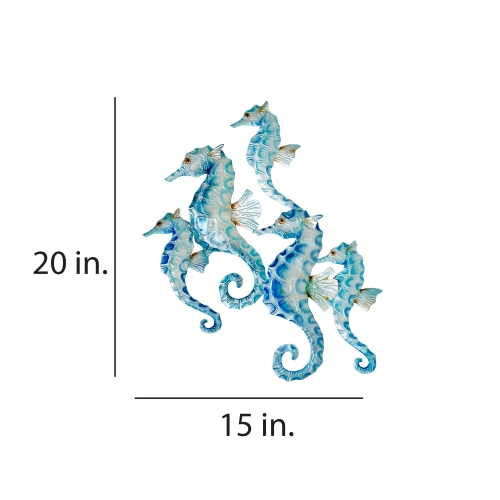
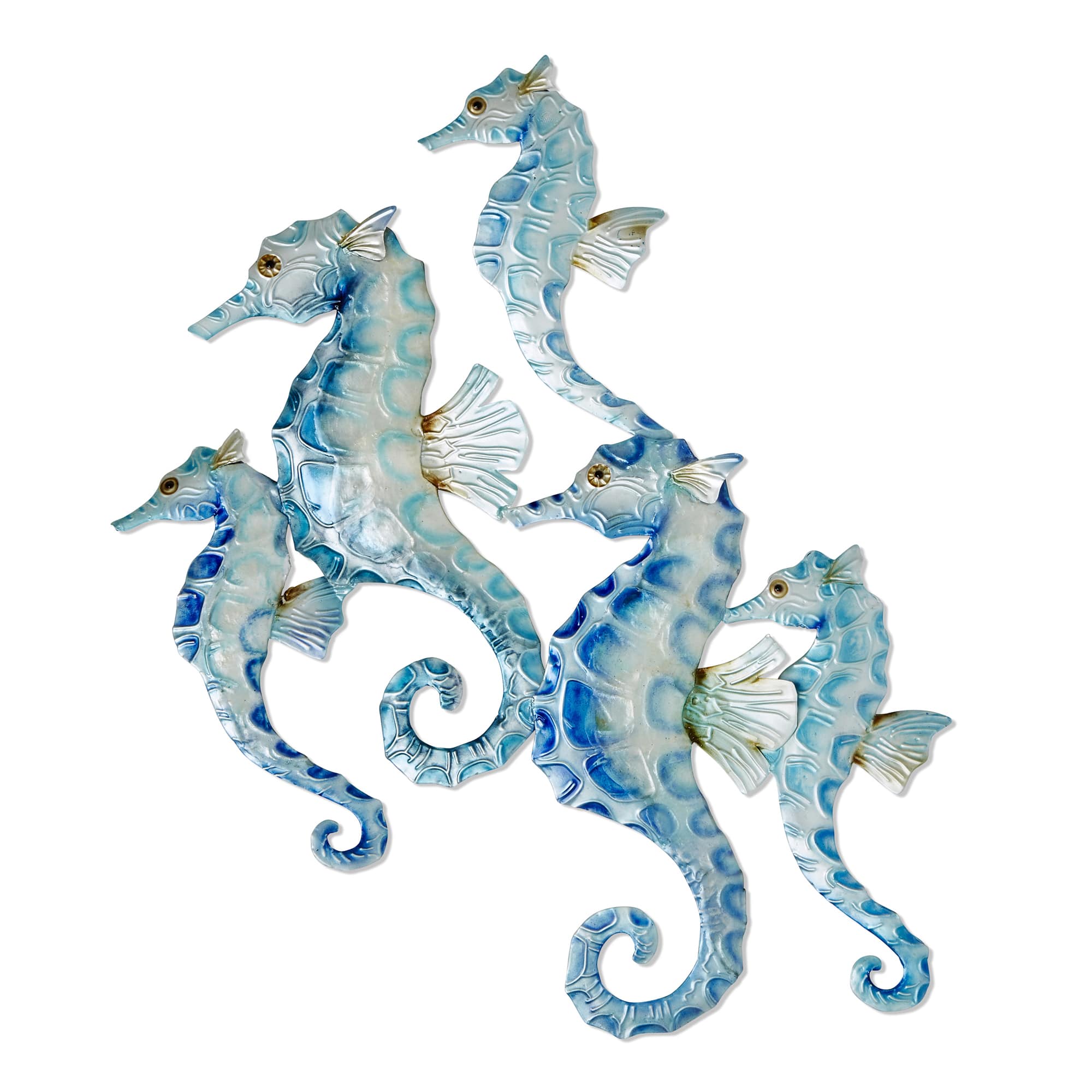 The seahorse has captured the minds and imaginations of people across all cultures for thousands of years. Seen as a symbol of good luck, strength and safety, this unique and beautiful animal is as charming as it is mysterious. The artist captures the beauty of the seahorse with a raised fine, high shine, hand-painted finish, and elegant mother of pearl on their chest and forefront. The basic frame of the wall seahorses is created using tin, which is powder coated as a black finish. Capiz is an oyster shell and the primary purpose of the oyster is as a source of food. However, the by-product, the shell, can be used for decoration. Due to it being a natural material, the natural colors of the capiz can come through as tans and browns.
The seahorse has captured the minds and imaginations of people across all cultures for thousands of years. Seen as a symbol of good luck, strength and safety, this unique and beautiful animal is as charming as it is mysterious. The artist captures the beauty of the seahorse with a raised fine, high shine, hand-painted finish, and elegant mother of pearl on their chest and forefront. The basic frame of the wall seahorses is created using tin, which is powder coated as a black finish. Capiz is an oyster shell and the primary purpose of the oyster is as a source of food. However, the by-product, the shell, can be used for decoration. Due to it being a natural material, the natural colors of the capiz can come through as tans and browns. -
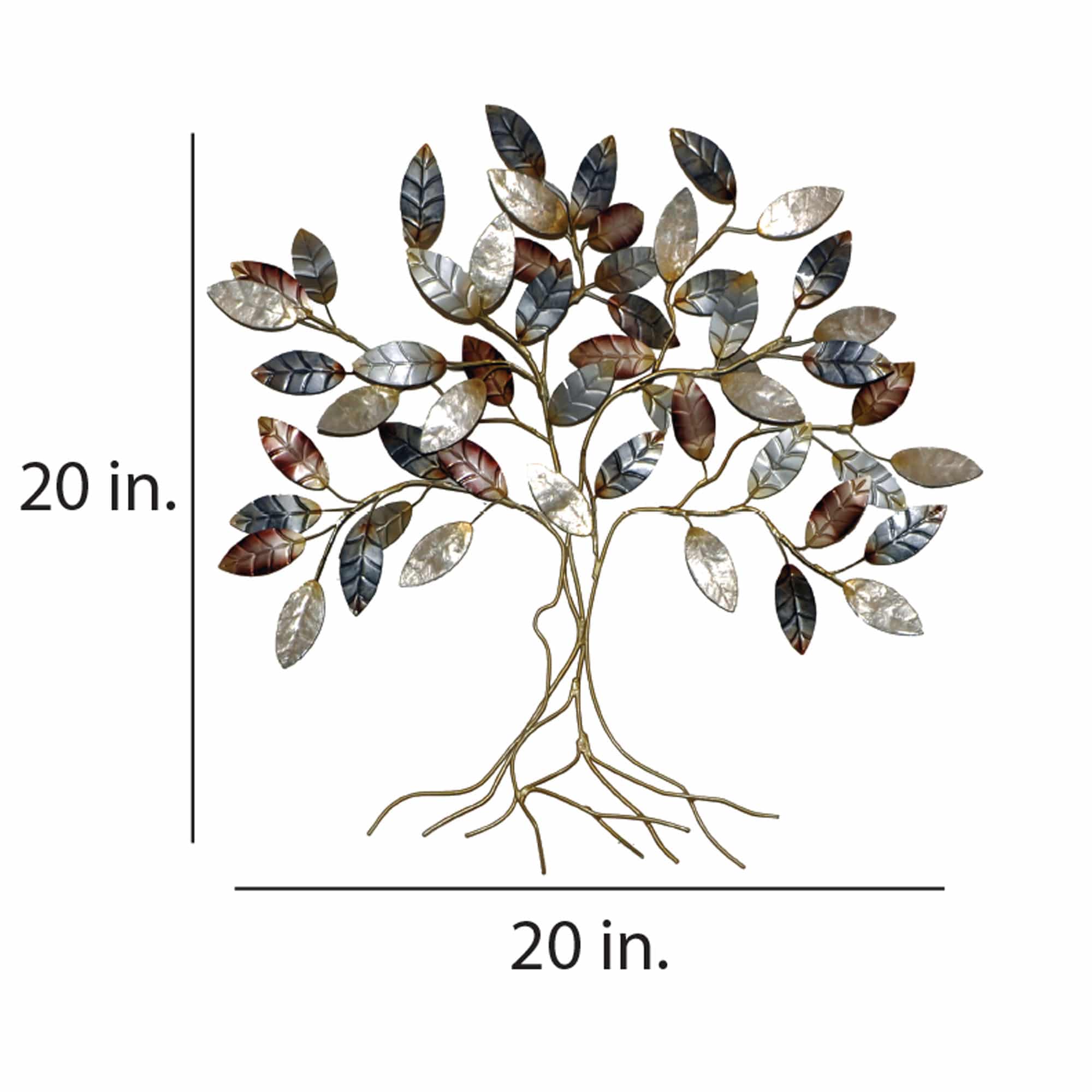
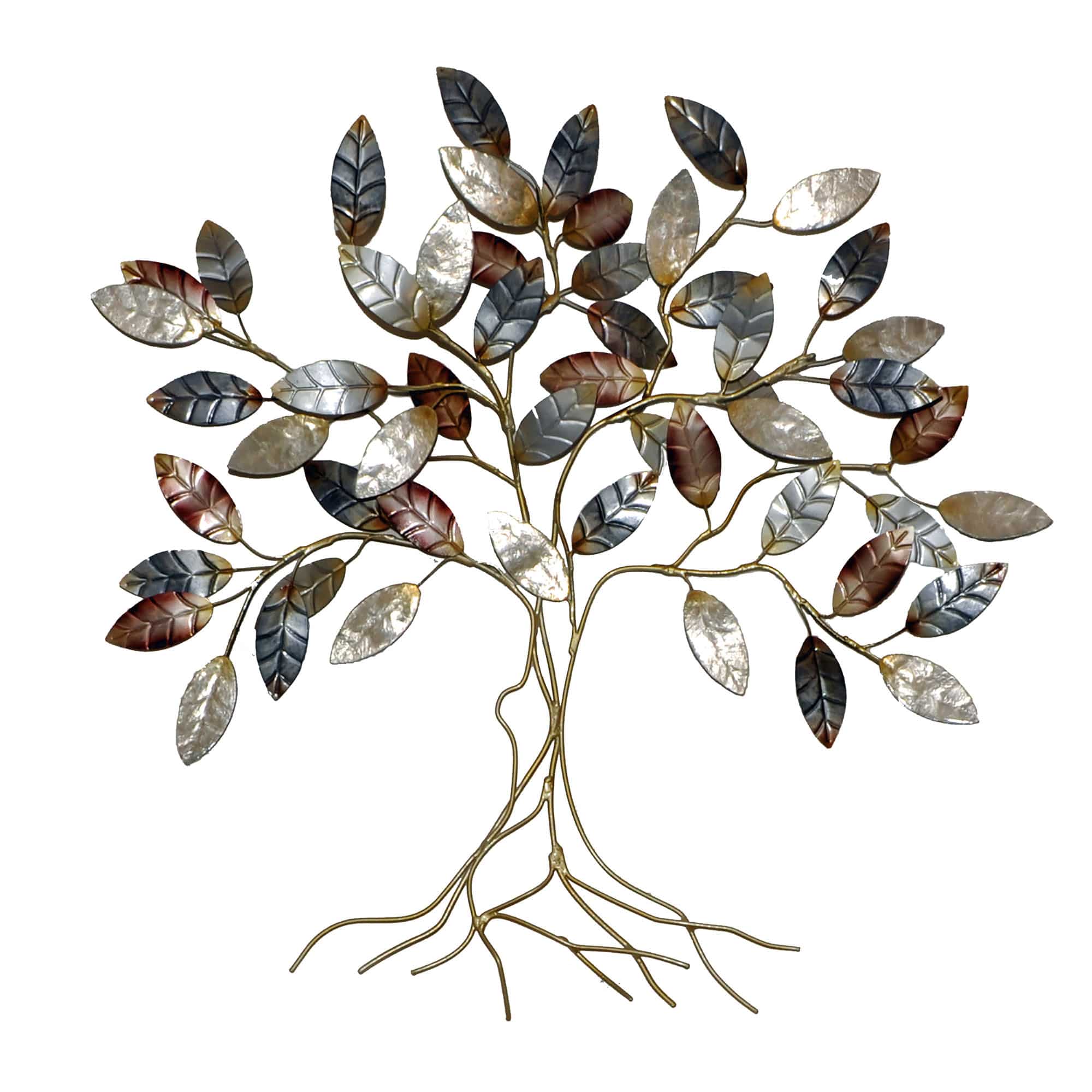 Trees have a special place in cultures around the world and through the ages. The definition of the beauty and utility of trees are clear, be it from the strong roots, the thick trunk, or the lush canopy. The artisan, in this case, used capiz to accentuate the bright leaves and used wired to stress the strength of the trunk and roots. Instead of using traditional colors, the artisan used a color palette that is unique but just as alluring and complementary. The basic frame of the framed of the tree is created using wrought iron, which is powder coated with a black finish. Capiz is an oyster shell and the primary purpose of the oyster is as a source of food. However, the by-product, the shell, can be used for decoration. Due to it being a natural material, the natural colors of the capiz come through as tans and browns underneath the paint. The shell is then painted the bold colors you see. The entire front facing piece is carefully hand-painted keeping in mind the reflective qualities in the color.
Trees have a special place in cultures around the world and through the ages. The definition of the beauty and utility of trees are clear, be it from the strong roots, the thick trunk, or the lush canopy. The artisan, in this case, used capiz to accentuate the bright leaves and used wired to stress the strength of the trunk and roots. Instead of using traditional colors, the artisan used a color palette that is unique but just as alluring and complementary. The basic frame of the framed of the tree is created using wrought iron, which is powder coated with a black finish. Capiz is an oyster shell and the primary purpose of the oyster is as a source of food. However, the by-product, the shell, can be used for decoration. Due to it being a natural material, the natural colors of the capiz come through as tans and browns underneath the paint. The shell is then painted the bold colors you see. The entire front facing piece is carefully hand-painted keeping in mind the reflective qualities in the color. -
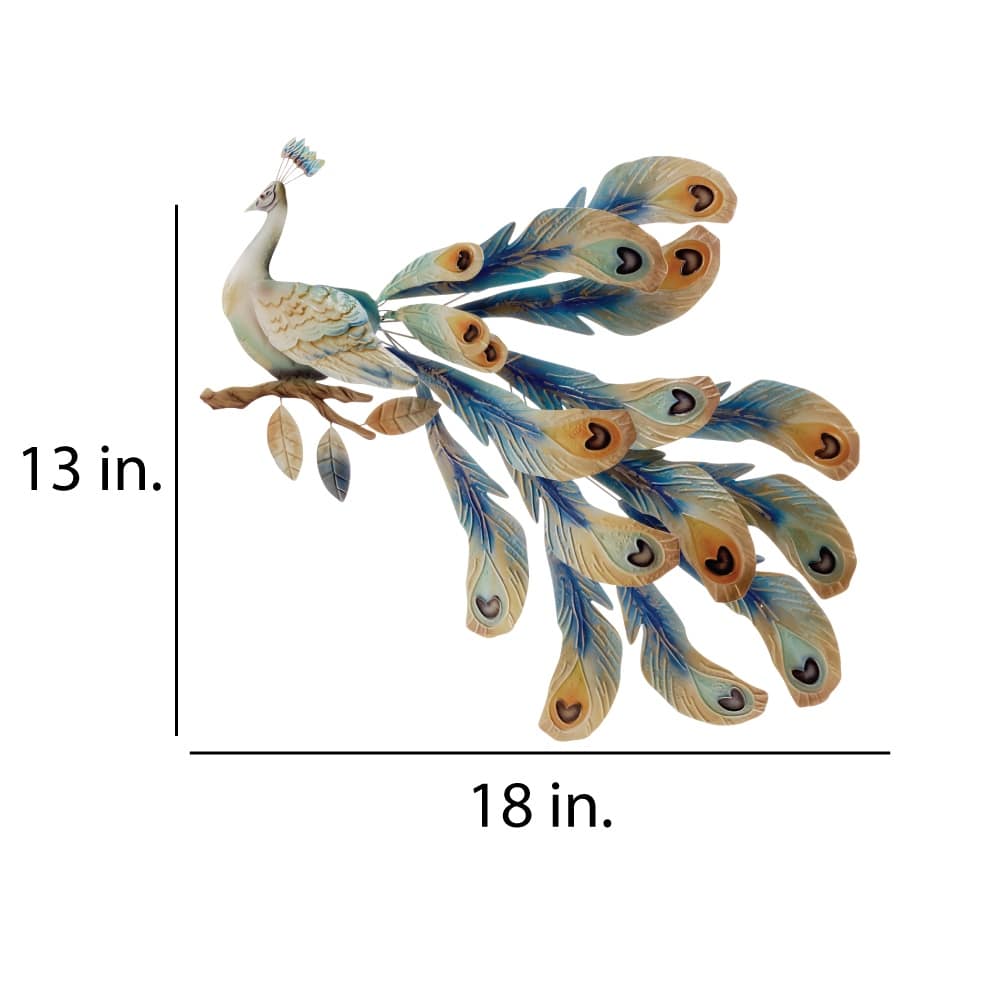
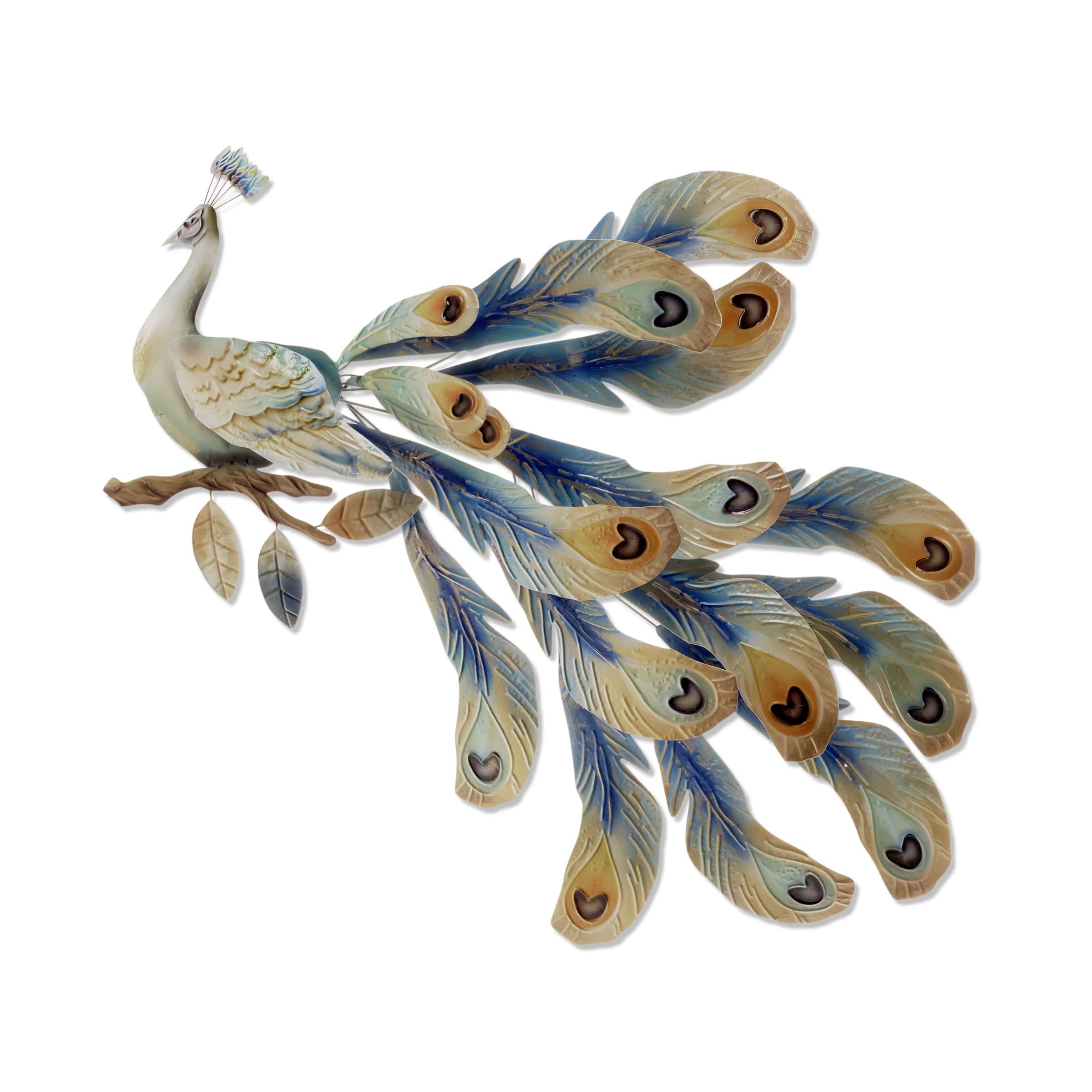 This elegant peacock is relaxed and calm, pluming through its feathers. Throughout its tail-feathers, the artists drew in the peacock's distinctive eyespots, with the eye itself in different colors. The chest of the bird is crafted from capiz shell, carefully painted in the blues and greens this bird is known for. It will fit perfectly within any decor style and add the finishing touch to its surroundings. The basic frame of the cat is created using tin, which is powder coated with a black finish. The frame is reinforced using tin wire along the inner edge. Capiz is an oyster shell and the primary purpose of the oyster is as a source of food. However, the by-product, the shell, can be used for decoration. Due to it being a natural material, the natural colors of the capiz come through as tans and browns underneath the paint. The shell is then painted the bold colors you see. The entire front facing piece is carefully hand-painted.
This elegant peacock is relaxed and calm, pluming through its feathers. Throughout its tail-feathers, the artists drew in the peacock's distinctive eyespots, with the eye itself in different colors. The chest of the bird is crafted from capiz shell, carefully painted in the blues and greens this bird is known for. It will fit perfectly within any decor style and add the finishing touch to its surroundings. The basic frame of the cat is created using tin, which is powder coated with a black finish. The frame is reinforced using tin wire along the inner edge. Capiz is an oyster shell and the primary purpose of the oyster is as a source of food. However, the by-product, the shell, can be used for decoration. Due to it being a natural material, the natural colors of the capiz come through as tans and browns underneath the paint. The shell is then painted the bold colors you see. The entire front facing piece is carefully hand-painted. -
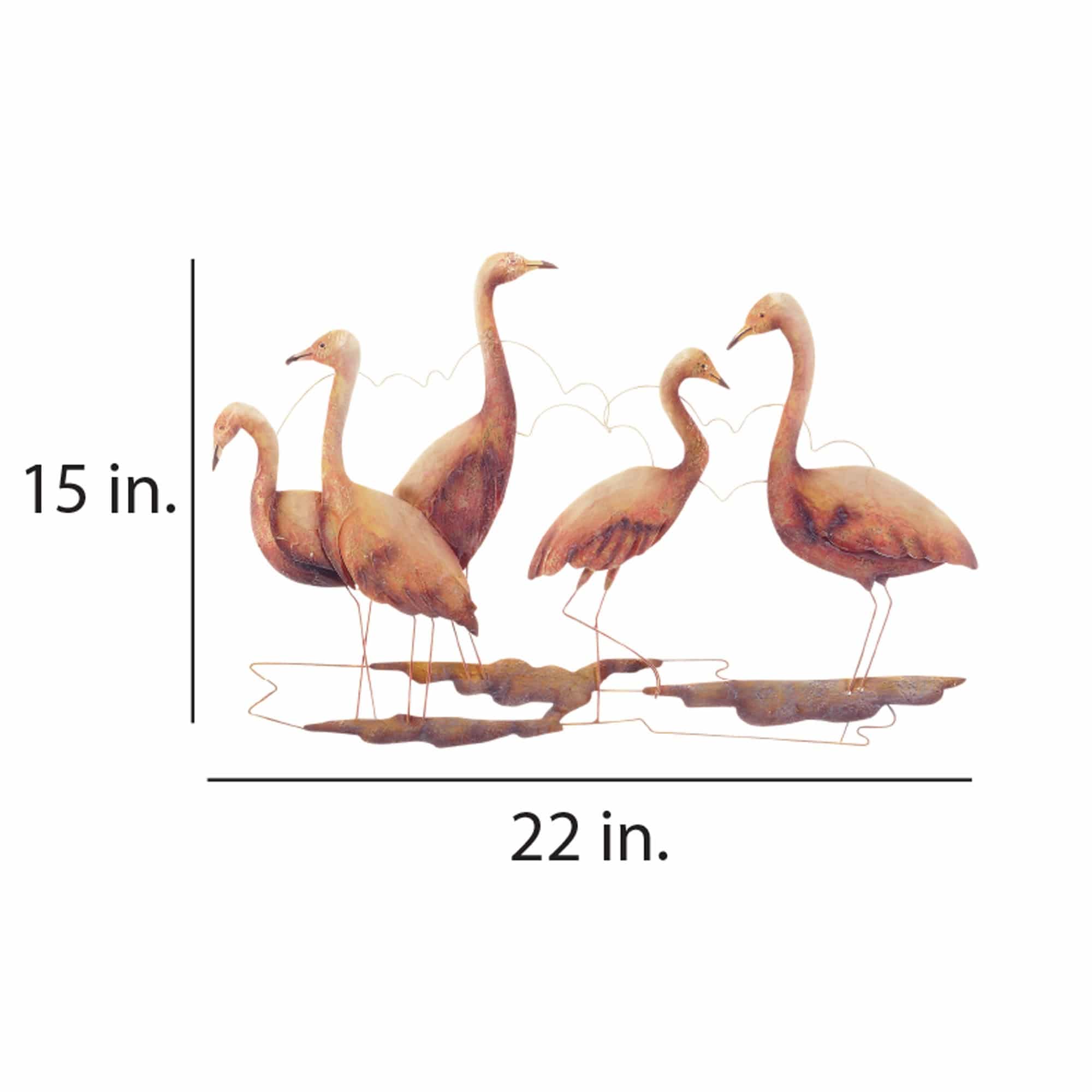
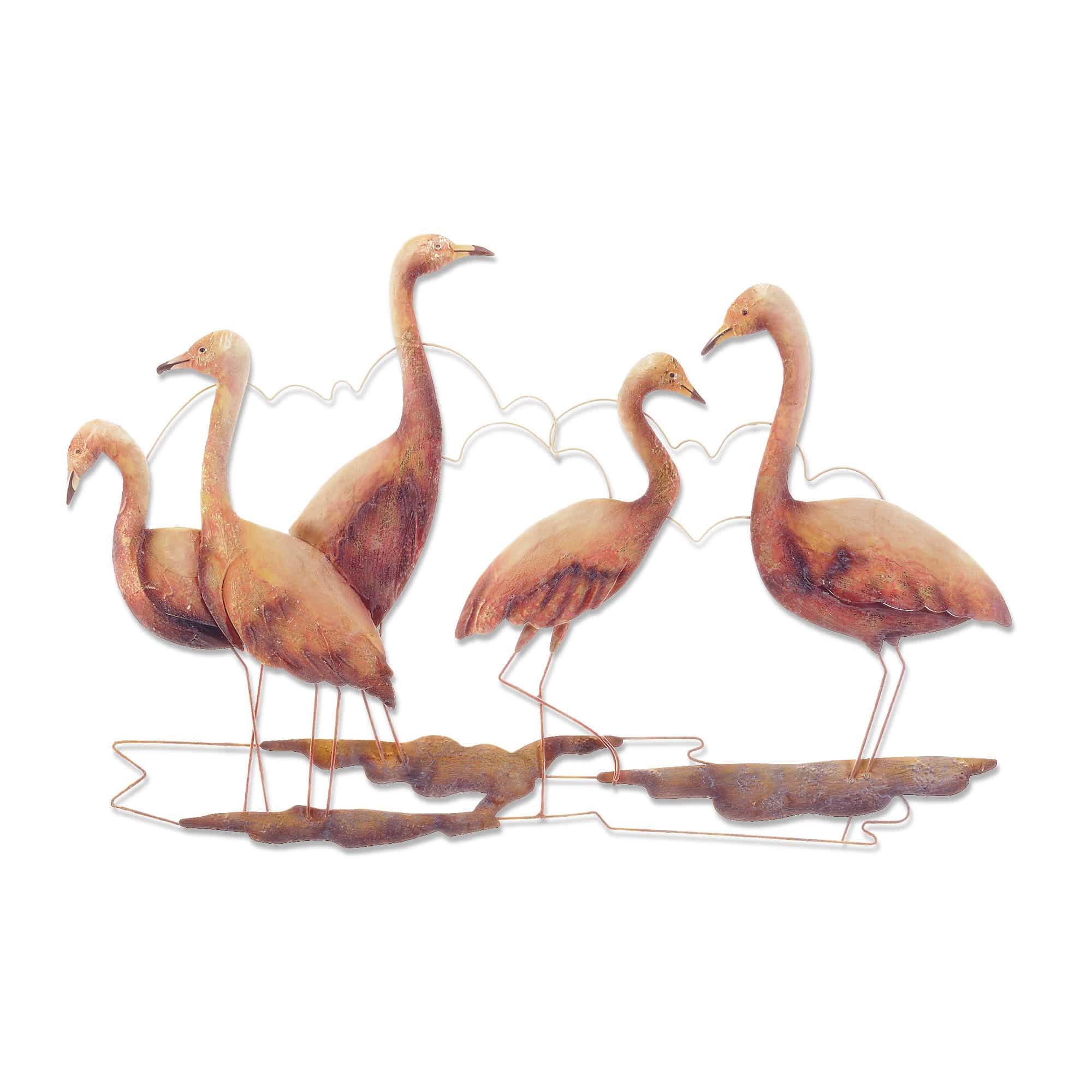 The name 'flamingo' comes from the Portuguese or Spanish 'flamengo,' which means 'flame-colored.' Born gray in hues, flamingos get their flamboyant color from brine shrimp that make up most of their diet. Flamingos are very social animals and the artist depicts this by creating a group of five birds wading through the calm water enjoying a warm day. The artist takes time in pressing the metal creating texture in the wings and body, and also uses metallic paints to highlight the famous colors of one of the most recognizable birds on the planet. The basic frame of this piece is created using tin, which is powder coated with a black finish. The frame is reinforced using tin wire along the inner edge. The front of the body is adorned with capiz. Capiz is an oyster shell and the primary purpose of the oyster is as a source of food. However, the by-product, the shell, can be used for decoration. Due to it being a natural material, the natural colors of the capiz may come through as tans and browns underneath the hand-painted surface.
The name 'flamingo' comes from the Portuguese or Spanish 'flamengo,' which means 'flame-colored.' Born gray in hues, flamingos get their flamboyant color from brine shrimp that make up most of their diet. Flamingos are very social animals and the artist depicts this by creating a group of five birds wading through the calm water enjoying a warm day. The artist takes time in pressing the metal creating texture in the wings and body, and also uses metallic paints to highlight the famous colors of one of the most recognizable birds on the planet. The basic frame of this piece is created using tin, which is powder coated with a black finish. The frame is reinforced using tin wire along the inner edge. The front of the body is adorned with capiz. Capiz is an oyster shell and the primary purpose of the oyster is as a source of food. However, the by-product, the shell, can be used for decoration. Due to it being a natural material, the natural colors of the capiz may come through as tans and browns underneath the hand-painted surface. -


Classically painted roses adorn this set of three butterflies. The traditional pattern brings the garden indoors. Painted on mother of pearl oyster shells, the vibrant roses pop, adding color and charm.
The basic frame of the butterfly is created using tin, which is powder-coated with a black finish and makes this piece safe to use outdoors. The edges of the frame are reinforced using thicker tin wire. The front of this piece is adorned in areas with capiz shell, an oyster native to the Philippines, before being hand-painted and sealed with a water-based sealant. The primary purpose of this oyster to provide a source of food, however, the shell is a sustainable by-product that can be used for decoration. The capiz shell subtly replicates the reflective qualities of butterflies in nature. The entire piece is lightweight and has an eyelet in the back allowing it to be hung using a finishing nail, command strip, or a push pin. Due to it being a natural material, the organic colors of capiz come through as tans and browns underneath the paint.
-
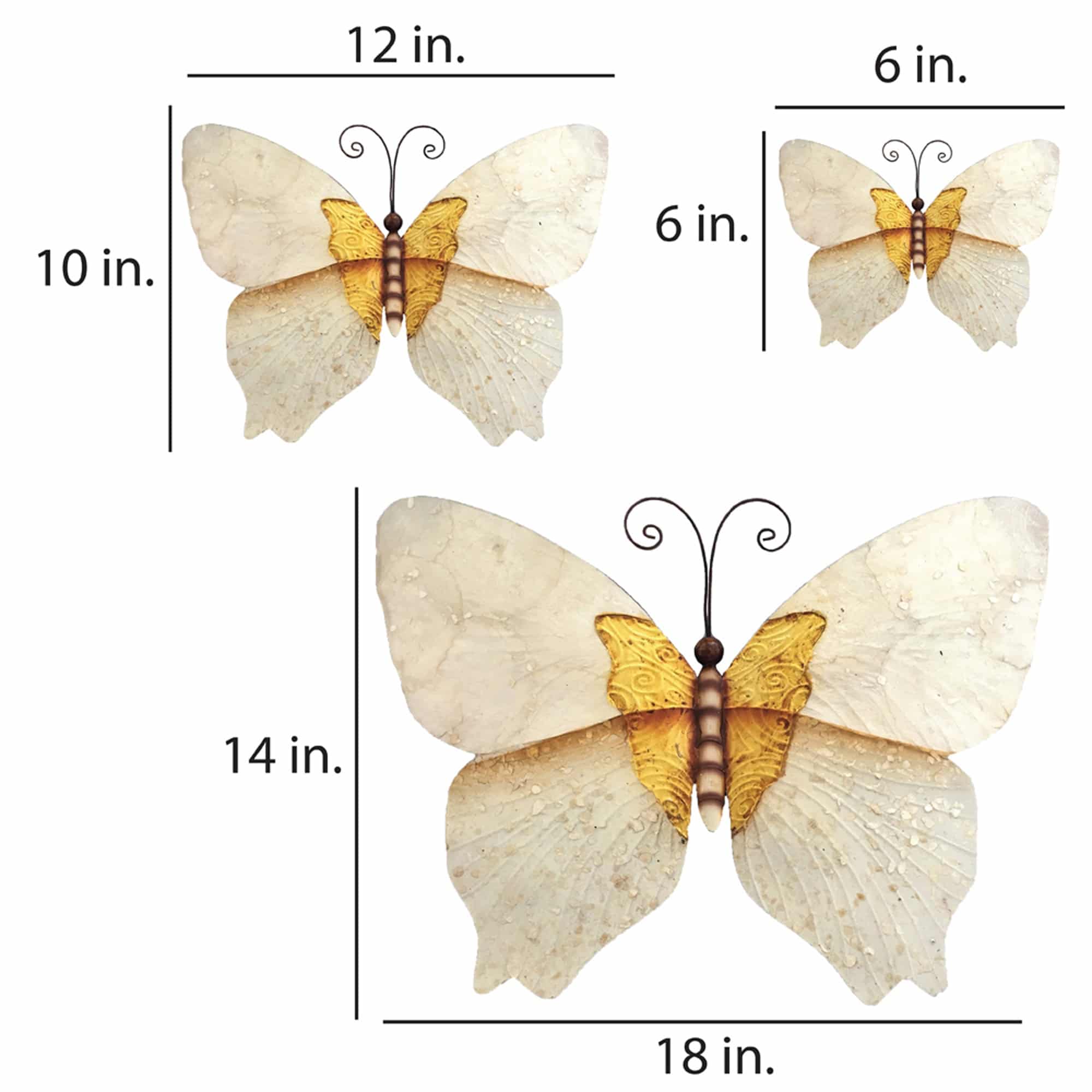

The set of three butterflies are influenced by the midcentury color pallet. The upper wings are adorned with capiz shell, giving it the translucent color seen in the natural butterfly. The lower wings are constructed from tin, textured, to accentuate the veins of the butterfly. Highlighted at the center is a burst of gold which trickles down to the lower portion of the wings.
The basic frame of the butterfly is created using tin, which is powder-coated with a black finish and makes this piece safe to use outdoors. The edges of the frame are reinforced using thicker tin wire. The front of this piece is adorned in areas with capiz shell, an oyster native to the Philippines, before being hand-painted and sealed with a water-based sealant. The primary purpose of this oyster to provide a source of food, however, the shell is a sustainable by-product that can be used for decoration. The capiz shell subtly replicates the reflective qualities of butterflies in nature. The entire piece is lightweight and has an eyelet in the back allowing it to be hung using a finishing nail, command strip, or a push pin. Due to it being a natural material, the organic colors of capiz come through as tans and browns underneath the paint.
-

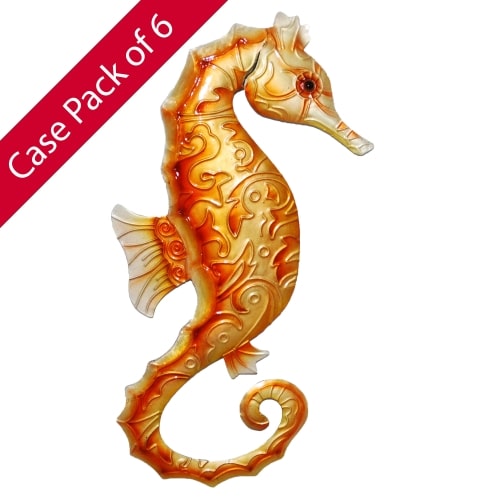 Case of 6 The seahorse has captured the minds and imaginations of people across all cultures for thousands of years. Seen as a symbol of good luck, strength and safety, this unique and beautiful animal is as charming as it is mysterious. The artist captures the beauty of the seahorse with a raised fine, high shine, hand-painted finish, and elegant mother of pearl chest and forefront. The basic frame of the wall seahorse is created using tin, which is powder coated as a black finish. Capiz is an oyster shell and the primary purpose of the oyster is as a source of food. However, the by-product, the shell, can be used for decoration. Due to it being a natural material, the natural colors of the capiz can come through as tans and browns.
Case of 6 The seahorse has captured the minds and imaginations of people across all cultures for thousands of years. Seen as a symbol of good luck, strength and safety, this unique and beautiful animal is as charming as it is mysterious. The artist captures the beauty of the seahorse with a raised fine, high shine, hand-painted finish, and elegant mother of pearl chest and forefront. The basic frame of the wall seahorse is created using tin, which is powder coated as a black finish. Capiz is an oyster shell and the primary purpose of the oyster is as a source of food. However, the by-product, the shell, can be used for decoration. Due to it being a natural material, the natural colors of the capiz can come through as tans and browns. -
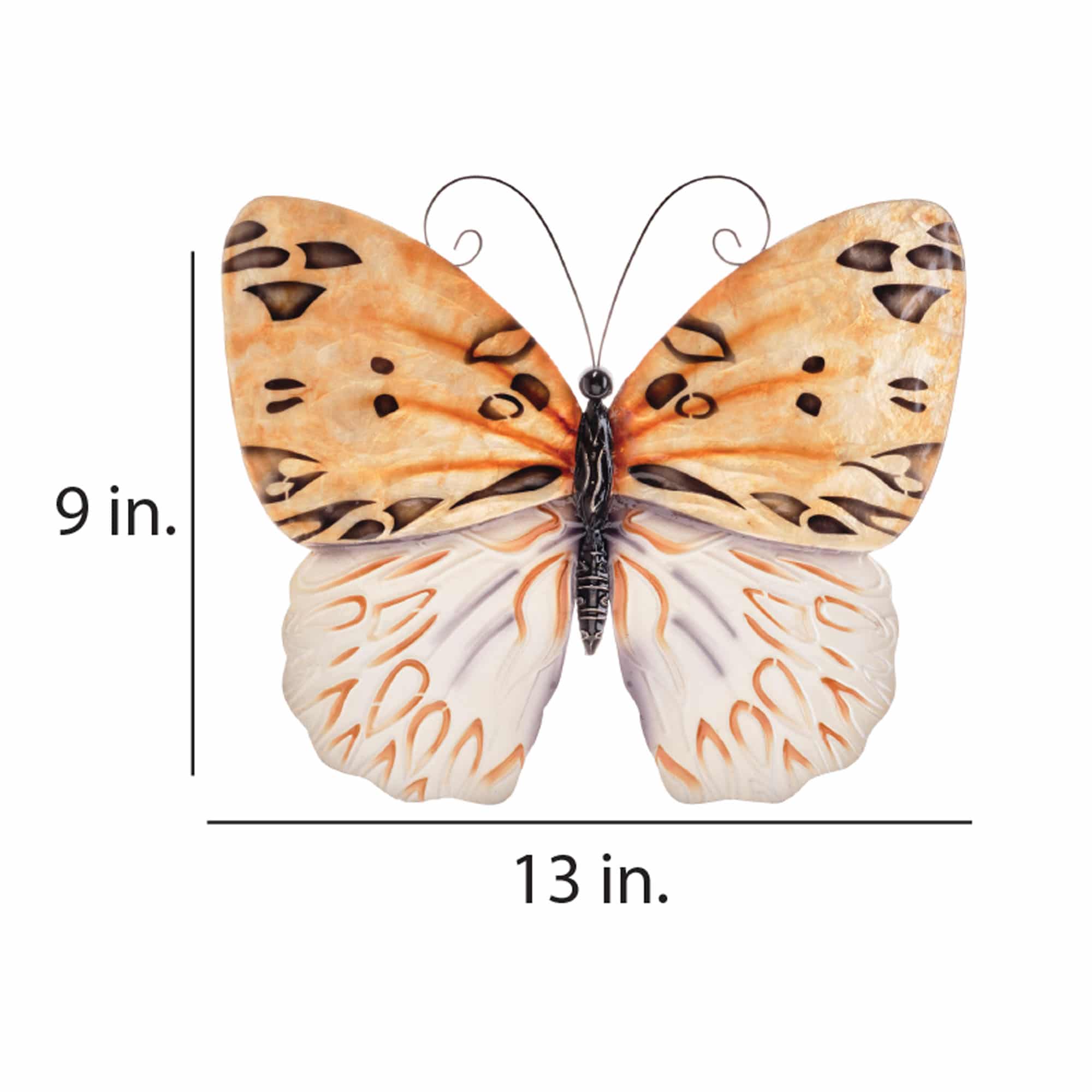
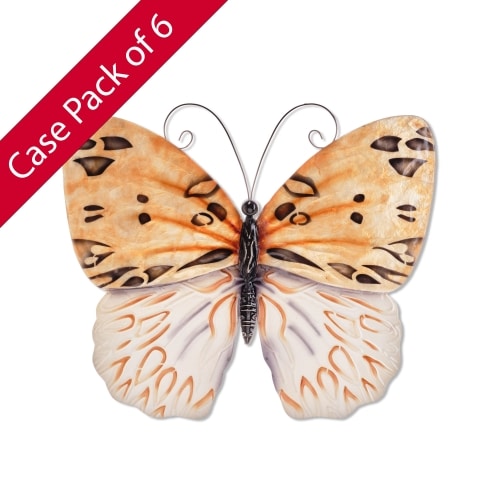 Case of 6
Case of 6Using paints of various shades and different hues of yellow, this graceful butterfly features an appearance of flowing honey on its upper wings. The lower wings diverge from the honey and are textured in a base white color with highlights of yellow. Stylish and elegant, this piece adds sophistication to the finish of any room, contemporary or traditional.
The basic frame of the butterfly is created using tin, which is powder-coated with a black finish and makes this piece safe to use outdoors. The edges of the frame are reinforced using thicker tin wire. The front of this piece is adorned in areas with capiz shell, an oyster native to the Philippines, before being hand-painted and sealed with a water-based sealant. The primary purpose of this oyster to provide a source of food, however, the shell is a sustainable by-product that can be used for decoration. The capiz shell subtly replicates the reflective qualities of butterflies in nature. The entire piece is lightweight and has an eyelet in the back allowing it to be hung using a finishing nail, command strip, or a push pin. Due to it being a natural material, the organic colors of capiz come through as tans and browns underneath the paint.
-
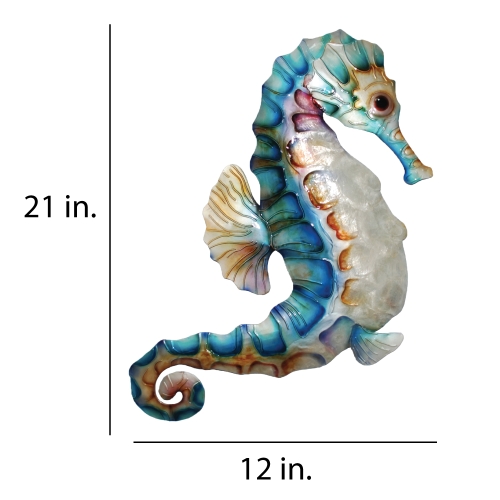
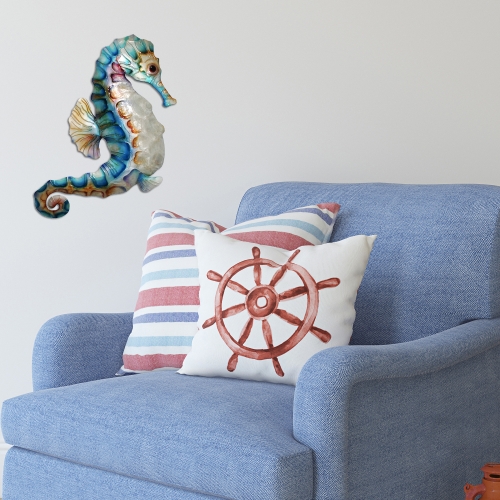 The Seahorse Wall Décor is a beautiful and unique addition to any home. The seahorse symbolizes discovery of balance in life and transformation of energy into positive thoughts. And because of the way seahorses move, they're also symbolic of peace and patience. The artist captures the splendor of the seahorse with a raised fin, high shine hand-painted finish, and capiz oyster shell chest and forefront. The Seahorse Wall Décor is the perfect way to bring good luck, strength, and beauty into your home. The basic frame of the Seahorse is created using tin, which is powder-coated with a black finish and makes this piece safe to use outdoors. The edges of the frame are reinforced using thicker tin wire. The front of this piece is adorned in areas with capiz shell, an oyster native to the Philippines, before being hand-painted and sealed with a water-based sealant. The primary purpose of this oyster to provide a source of food, however, the shell is a sustainable by-product that can be used for decoration. The capiz shell subtly replicates the reflective qualities of seahorses in nature. The entire piece is lightweight and has an eyelet in the back allowing it to be hung using a finishing nail, command strip, or a push pin. Due to it being a natural material, the organic colors of capiz come through as tans and browns underneath the paint.
The Seahorse Wall Décor is a beautiful and unique addition to any home. The seahorse symbolizes discovery of balance in life and transformation of energy into positive thoughts. And because of the way seahorses move, they're also symbolic of peace and patience. The artist captures the splendor of the seahorse with a raised fin, high shine hand-painted finish, and capiz oyster shell chest and forefront. The Seahorse Wall Décor is the perfect way to bring good luck, strength, and beauty into your home. The basic frame of the Seahorse is created using tin, which is powder-coated with a black finish and makes this piece safe to use outdoors. The edges of the frame are reinforced using thicker tin wire. The front of this piece is adorned in areas with capiz shell, an oyster native to the Philippines, before being hand-painted and sealed with a water-based sealant. The primary purpose of this oyster to provide a source of food, however, the shell is a sustainable by-product that can be used for decoration. The capiz shell subtly replicates the reflective qualities of seahorses in nature. The entire piece is lightweight and has an eyelet in the back allowing it to be hung using a finishing nail, command strip, or a push pin. Due to it being a natural material, the organic colors of capiz come through as tans and browns underneath the paint. -
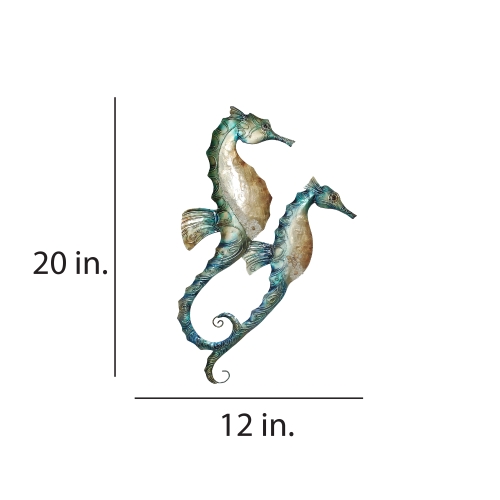
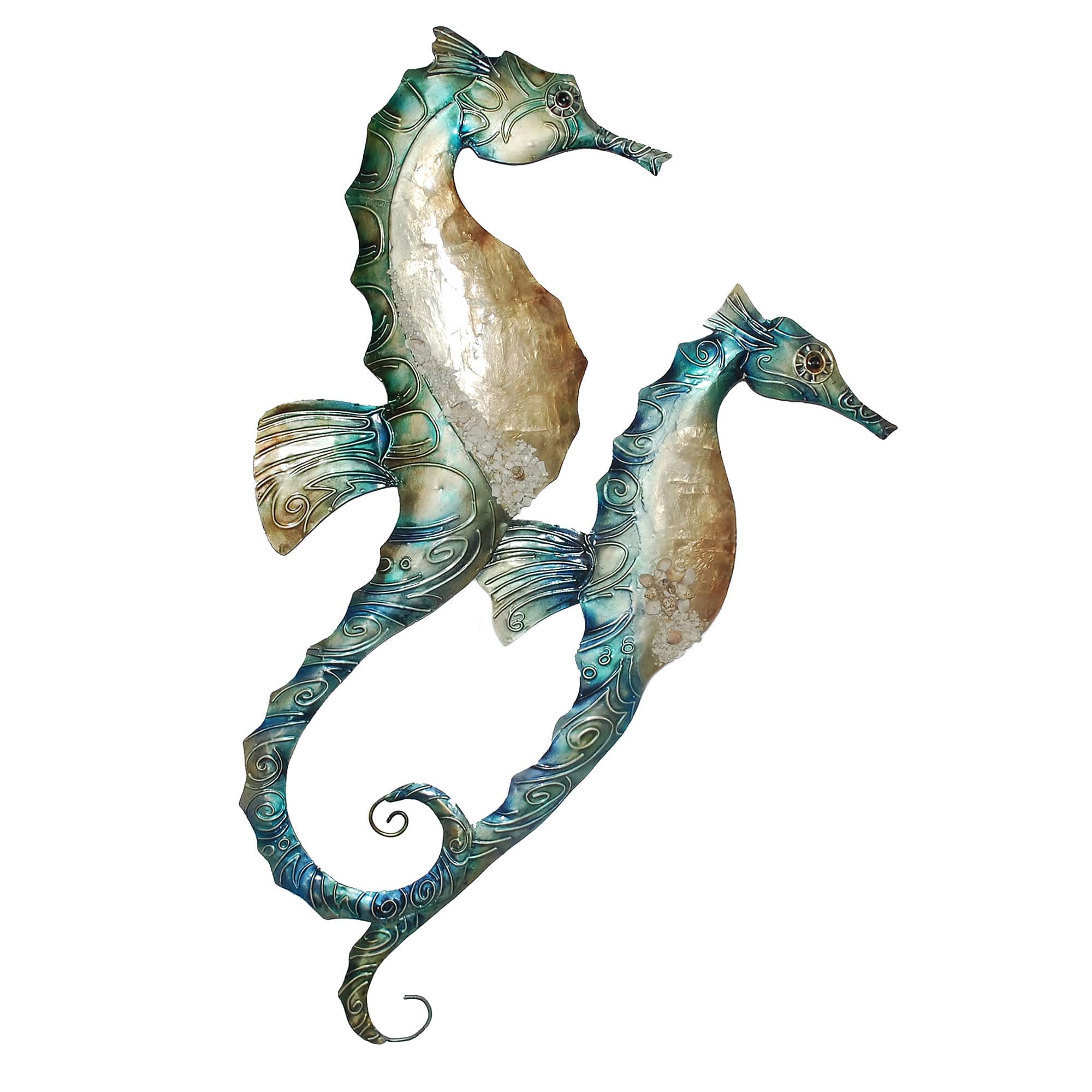 The seahorse has captured the minds and imaginations of people across all cultures for thousands of years. Seen as a symbol of good luck, strength and safety, this unique and beautiful animal is as charming as it is mysterious. The artist captures the beauty of the seahorse with a raised fine, high shine, hand-painted finish, and elegant mother of pearl on their chest and forefront. The basic frame of the wall seahorses is created using tin, which is powder coated as a black finish. Capiz is an oyster shell and the primary purpose of the oyster is as a source of food. However, the by-product, the shell, can be used for decoration. Due to it being a natural material, the natural colors of the capiz can come through as tans and browns.
The seahorse has captured the minds and imaginations of people across all cultures for thousands of years. Seen as a symbol of good luck, strength and safety, this unique and beautiful animal is as charming as it is mysterious. The artist captures the beauty of the seahorse with a raised fine, high shine, hand-painted finish, and elegant mother of pearl on their chest and forefront. The basic frame of the wall seahorses is created using tin, which is powder coated as a black finish. Capiz is an oyster shell and the primary purpose of the oyster is as a source of food. However, the by-product, the shell, can be used for decoration. Due to it being a natural material, the natural colors of the capiz can come through as tans and browns. -
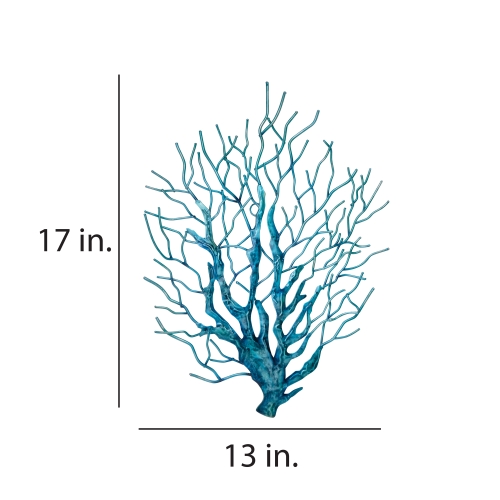
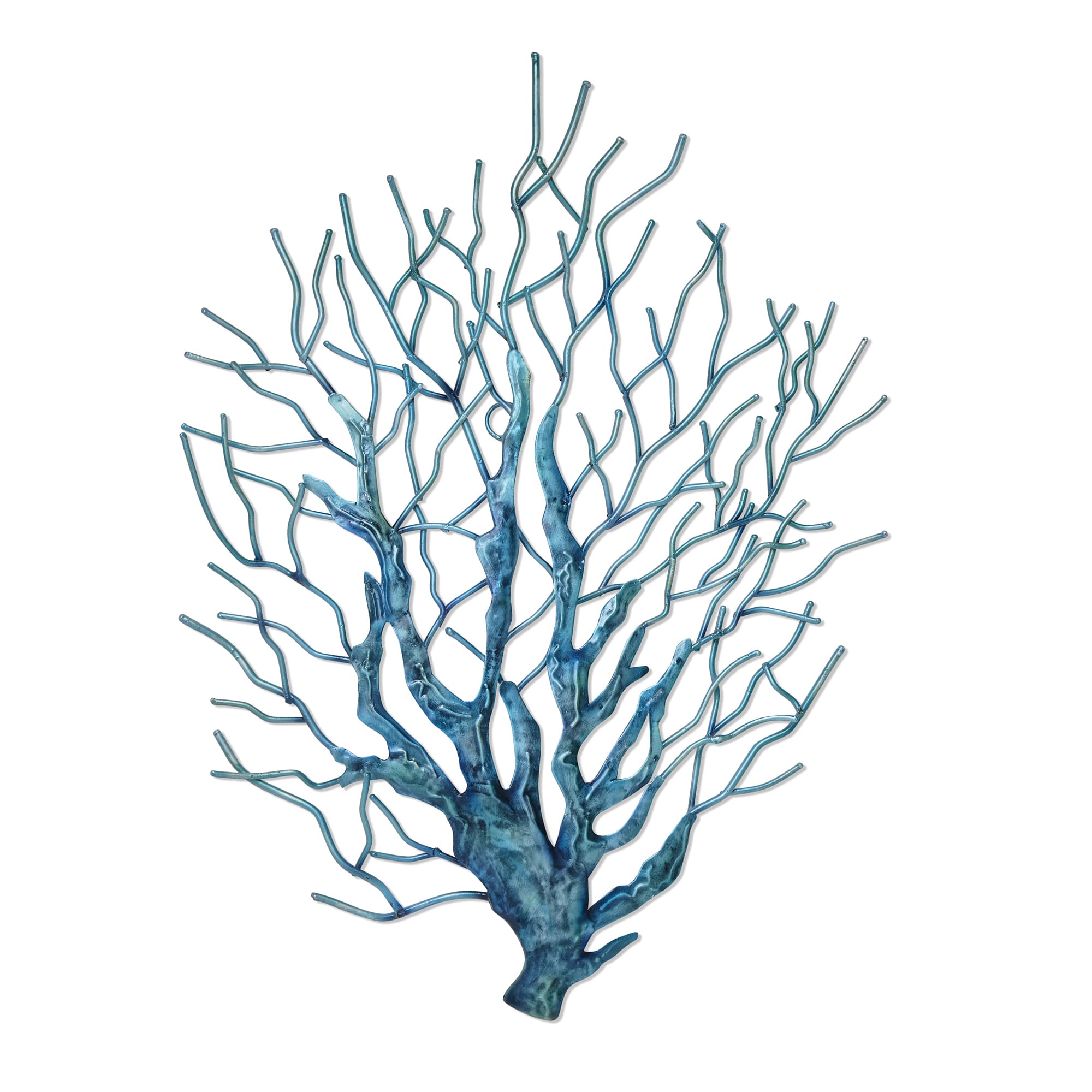 This piece features ten schooling mackerels swimming calmly with fins raised as if catching an ocean current. In their largest numbers, mackerels have been found to travel in schools that stretch as far as 20 miles. Painted by hand the artist uses aqua tones reminiscent of its ocean habitat. Capiz oyster shell adorn the front adding a watery shimmer. The basic frame of this piece is created using tin, which is powder coated with a black finish. The frame is reinforced using tin wire along the inner edge. The front of the body is adorned with capiz. Capiz is an oyster shell and the primary purpose of the oyster is as a source of food. However, the by-product, the shell, can be used for decoration. Due to it being a natural material, the natural colors of the capiz may come through as tans and browns underneath the hand-painted surface.
This piece features ten schooling mackerels swimming calmly with fins raised as if catching an ocean current. In their largest numbers, mackerels have been found to travel in schools that stretch as far as 20 miles. Painted by hand the artist uses aqua tones reminiscent of its ocean habitat. Capiz oyster shell adorn the front adding a watery shimmer. The basic frame of this piece is created using tin, which is powder coated with a black finish. The frame is reinforced using tin wire along the inner edge. The front of the body is adorned with capiz. Capiz is an oyster shell and the primary purpose of the oyster is as a source of food. However, the by-product, the shell, can be used for decoration. Due to it being a natural material, the natural colors of the capiz may come through as tans and browns underneath the hand-painted surface. -
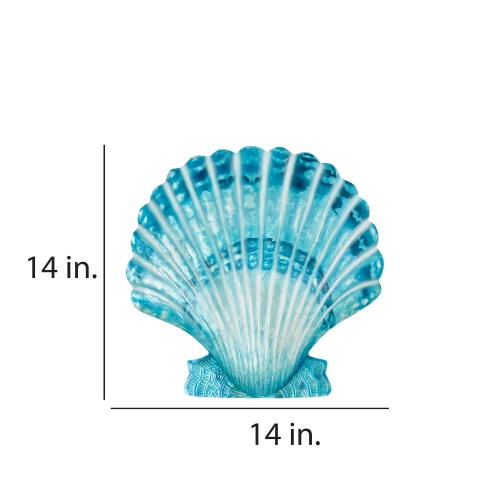
 The design is based on the shape of the Senatorial scallop found in the tropical waters of the pacific. Like the rings of a tree, one can determine the age of a scallop my counting the rings on its shell. Each ring represents one year of growth. The artist using this feature to add beautiful detail along with a deep aqua color to reflect its ocean habitat. Real capiz oyster shell adorns the exterior giving this piece a shimmer as if light were bouncing off its shell from under water. The basic frame of this piece is created using tin, which is powder coated with a black finish. The frame is reinforced using tin wire along the inner edge. The front of the body is adorned with capiz. Capiz is an oyster shell and the primary purpose of the oyster is as a source of food. However, the by-product, the shell, can be used for decoration. Due to it being a natural material, the natural colors of the capiz may come through as tans and browns underneath the hand-painted surface.
The design is based on the shape of the Senatorial scallop found in the tropical waters of the pacific. Like the rings of a tree, one can determine the age of a scallop my counting the rings on its shell. Each ring represents one year of growth. The artist using this feature to add beautiful detail along with a deep aqua color to reflect its ocean habitat. Real capiz oyster shell adorns the exterior giving this piece a shimmer as if light were bouncing off its shell from under water. The basic frame of this piece is created using tin, which is powder coated with a black finish. The frame is reinforced using tin wire along the inner edge. The front of the body is adorned with capiz. Capiz is an oyster shell and the primary purpose of the oyster is as a source of food. However, the by-product, the shell, can be used for decoration. Due to it being a natural material, the natural colors of the capiz may come through as tans and browns underneath the hand-painted surface. -
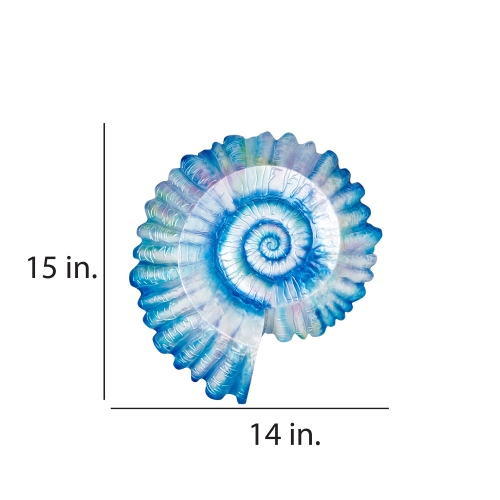
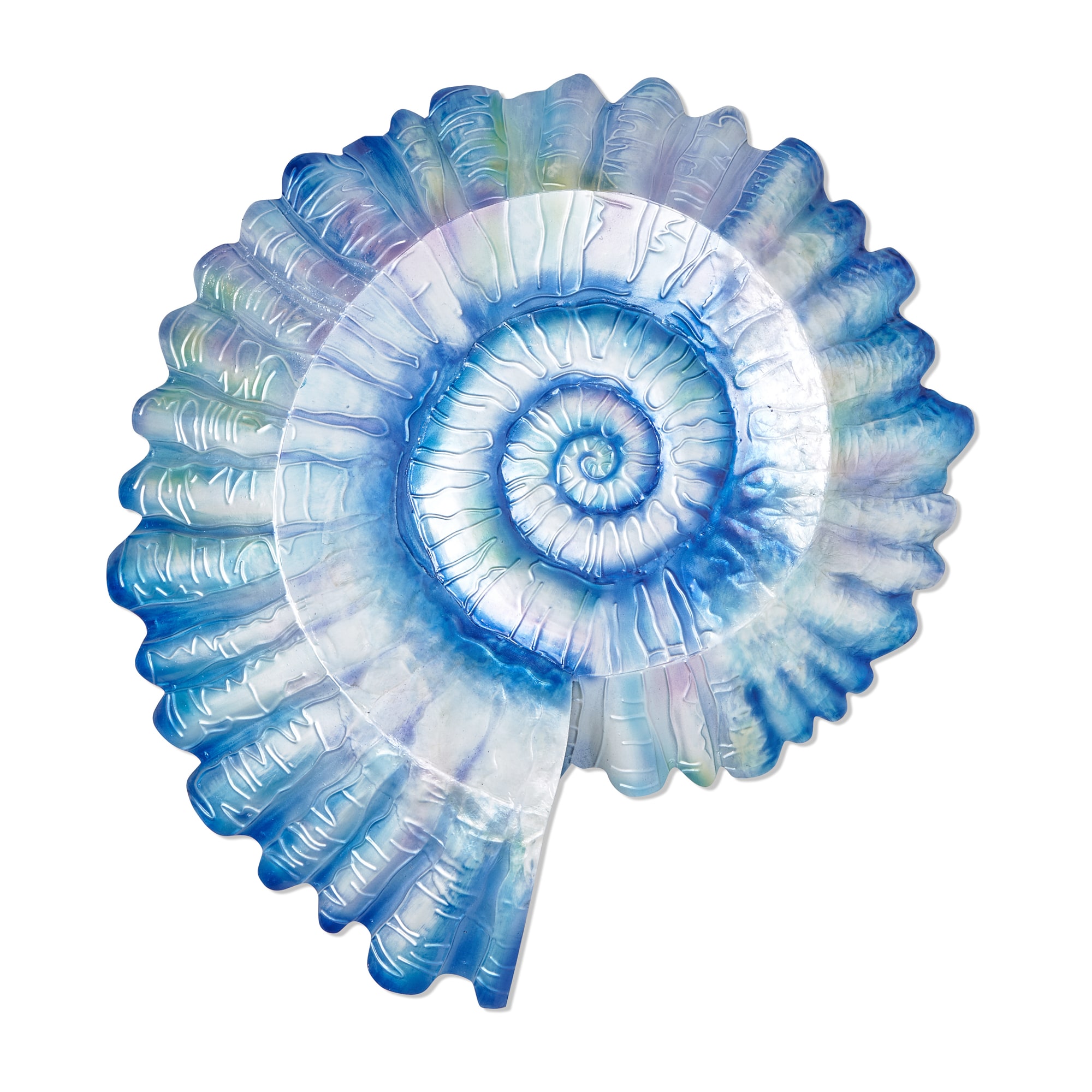 The spiral, flat seashell shape is a familiar one, but few know what actually live inside. This shell belongs to a creature known as a nautilus. Related to octopus, this creature is mobile, able to jettison itself through the ocean with streams of water. The artist captures its classic shape and adds deep shades of sea blue. Capiz oyster shell adorns its exterior as if it were glistening under water. The basic frame of this piece is created using tin, which is powder coated with a black finish. The frame is reinforced using tin wire along the inner edge. The front of the body is adorned with capiz. Capiz is an oyster shell and the primary purpose of the oyster is as a source of food. However, the by-product, the shell, can be used for decoration. Due to it being a natural material, the natural colors of the capiz may come through as tans and browns underneath the hand-painted surface.
The spiral, flat seashell shape is a familiar one, but few know what actually live inside. This shell belongs to a creature known as a nautilus. Related to octopus, this creature is mobile, able to jettison itself through the ocean with streams of water. The artist captures its classic shape and adds deep shades of sea blue. Capiz oyster shell adorns its exterior as if it were glistening under water. The basic frame of this piece is created using tin, which is powder coated with a black finish. The frame is reinforced using tin wire along the inner edge. The front of the body is adorned with capiz. Capiz is an oyster shell and the primary purpose of the oyster is as a source of food. However, the by-product, the shell, can be used for decoration. Due to it being a natural material, the natural colors of the capiz may come through as tans and browns underneath the hand-painted surface. -
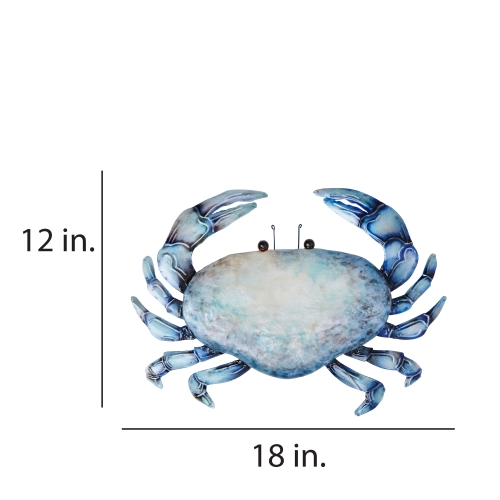
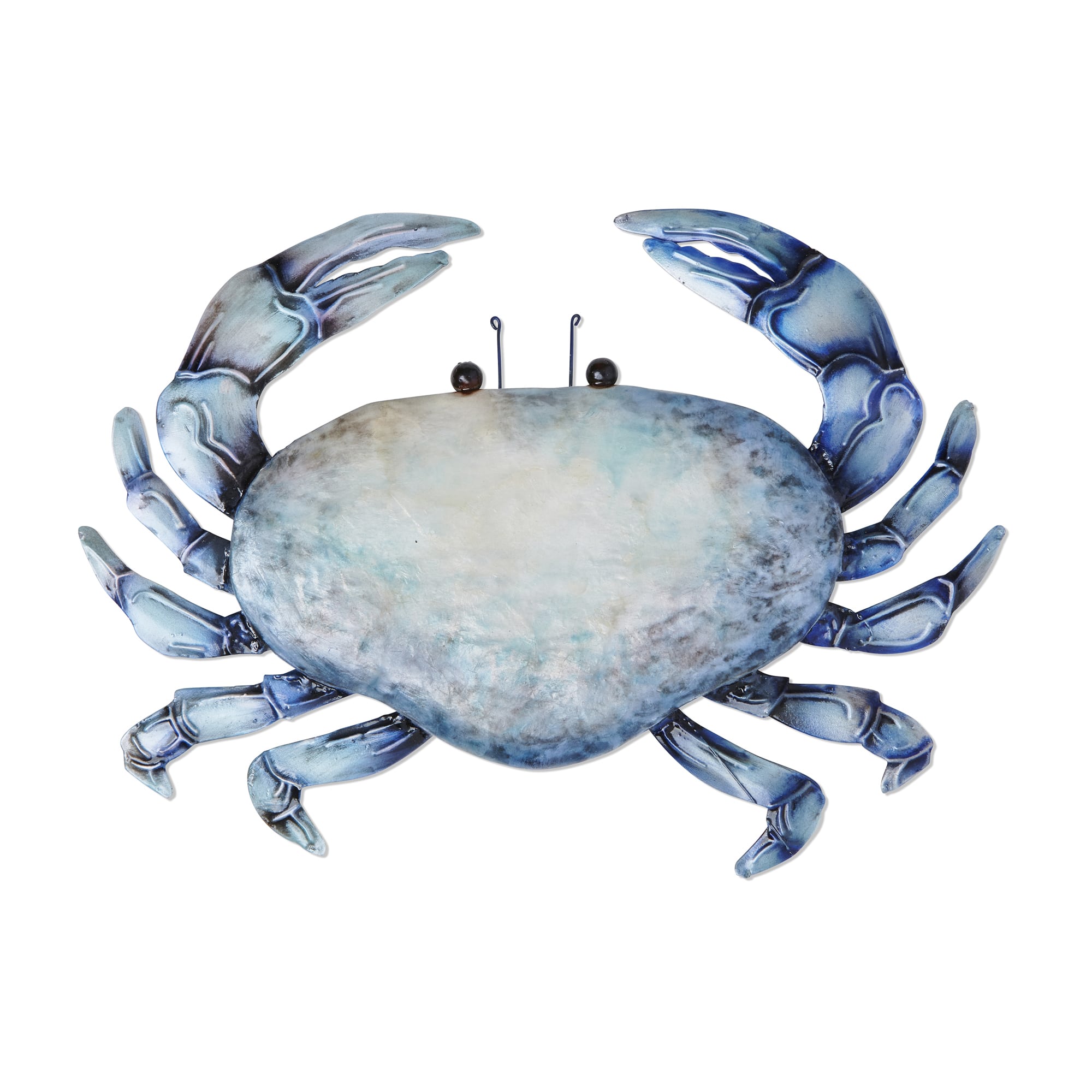 The frame of the piece is an Emerald Crab, which are commonly found in tropical waters of the Caribbean Sea. The maritime blue colors reflect the waters of its natural habitat while exhibiting calm and cool colors. The artist also creates slight contrasts between the body of the crab using capiz oyster shells and the matted outer legs and pinchers. The body will reflect light making it seem bolder. The basic frame of this piece is created using tin, which is powder coated with a black finish. The frame is reinforced using tin wire along the inner edge. The front of the body is adorned with capiz. Capiz is an oyster shell and the primary purpose of the oyster is as a source of food. However, the by-product, the shell, can be used for decoration. Due to it being a natural material, the natural colors of the capiz may come through as tans and browns underneath the hand-painted surface.
The frame of the piece is an Emerald Crab, which are commonly found in tropical waters of the Caribbean Sea. The maritime blue colors reflect the waters of its natural habitat while exhibiting calm and cool colors. The artist also creates slight contrasts between the body of the crab using capiz oyster shells and the matted outer legs and pinchers. The body will reflect light making it seem bolder. The basic frame of this piece is created using tin, which is powder coated with a black finish. The frame is reinforced using tin wire along the inner edge. The front of the body is adorned with capiz. Capiz is an oyster shell and the primary purpose of the oyster is as a source of food. However, the by-product, the shell, can be used for decoration. Due to it being a natural material, the natural colors of the capiz may come through as tans and browns underneath the hand-painted surface. -
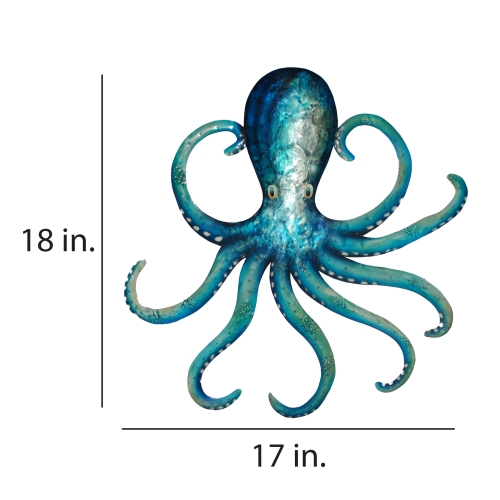
 The octopus has become known for its intelligence and curious nature. No other animal outside of birds and mammals has as large of a brain compared to the size its body as does the octopus. With eyes wide open, the artist reflects the inquisitive nature of this sea creature. Tones of blue represent its aquatic habitat. The use of capiz oyster shell bounces light from the front of this piece as if its reflecting light under water. The basic frame of this piece is created using tin, which is powder coated with a black finish. The frame is reinforced using tin wire along the inner edge. The front of the body is adorned with capiz. Capiz is an oyster shell and the primary purpose of the oyster is as a source of food. However, the by-product, the shell, can be used for decoration. Due to it being a natural material, the natural colors of the capiz may come through as tans and browns underneath the hand-painted surface.
The octopus has become known for its intelligence and curious nature. No other animal outside of birds and mammals has as large of a brain compared to the size its body as does the octopus. With eyes wide open, the artist reflects the inquisitive nature of this sea creature. Tones of blue represent its aquatic habitat. The use of capiz oyster shell bounces light from the front of this piece as if its reflecting light under water. The basic frame of this piece is created using tin, which is powder coated with a black finish. The frame is reinforced using tin wire along the inner edge. The front of the body is adorned with capiz. Capiz is an oyster shell and the primary purpose of the oyster is as a source of food. However, the by-product, the shell, can be used for decoration. Due to it being a natural material, the natural colors of the capiz may come through as tans and browns underneath the hand-painted surface. -
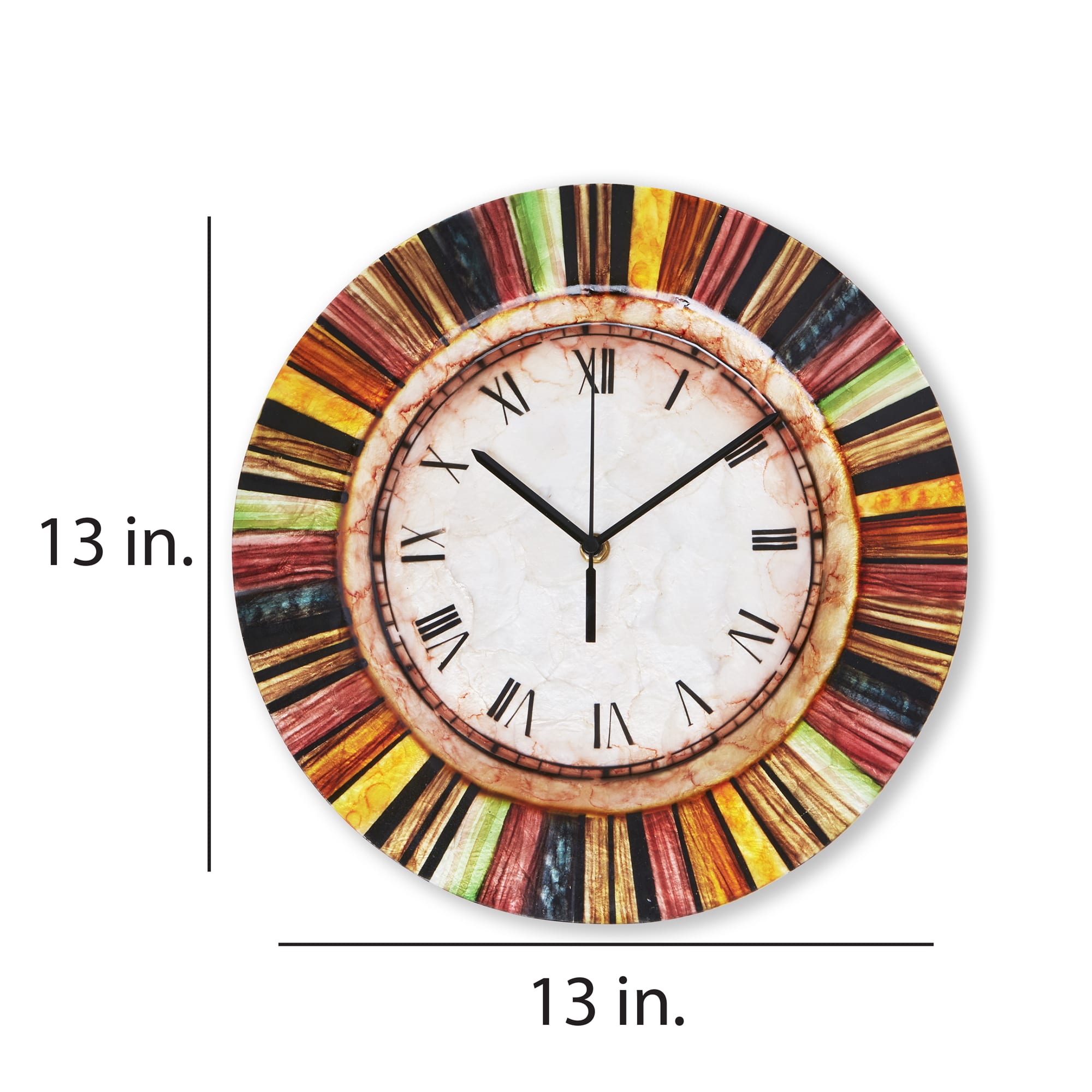
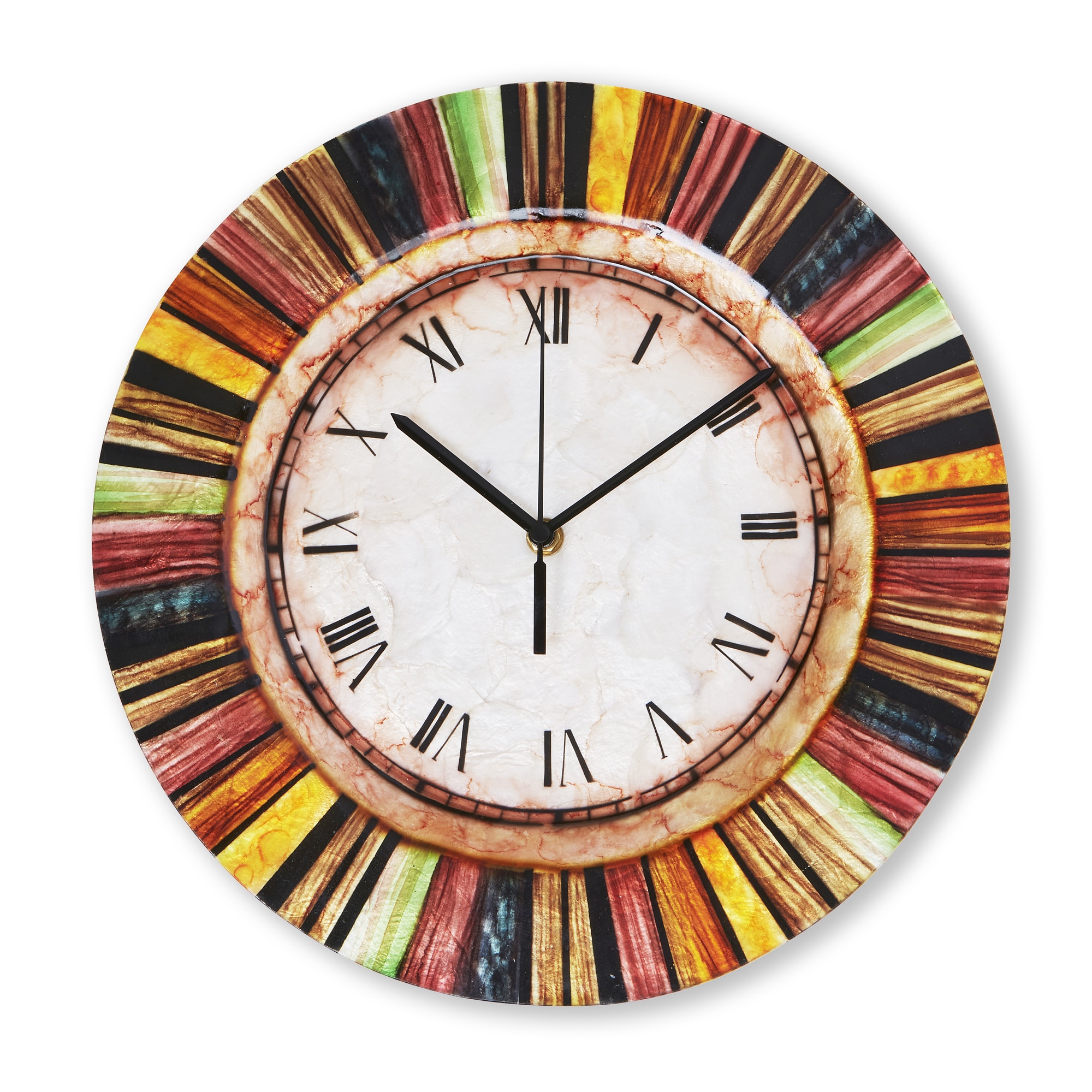 The frame of this clock is made with solid capiz oyster shell, compressed into shape.The artist calls attention to the uniqueness of each shell in the center with a high-gloss finish. Bold, roman numerals stand in contrast to the shell within the clock face. Color blocks adorn the outer rim of the clock in muted tones. The roman numerals combined with the color palette are strongly influenced from Tuscan design. Capiz is an oyster shell and the primary purpose of the oyster is as a source of food. However, the by-product, the shell, can be used for decoration. The clock is created by compressing capiz shell together and forming it into shape. The final result is a light-weight, plate that feels similar to plastic. Due to it being a natural material, the natural colors of the capiz may come through as tans and browns underneath the hand-painted surface.
The frame of this clock is made with solid capiz oyster shell, compressed into shape.The artist calls attention to the uniqueness of each shell in the center with a high-gloss finish. Bold, roman numerals stand in contrast to the shell within the clock face. Color blocks adorn the outer rim of the clock in muted tones. The roman numerals combined with the color palette are strongly influenced from Tuscan design. Capiz is an oyster shell and the primary purpose of the oyster is as a source of food. However, the by-product, the shell, can be used for decoration. The clock is created by compressing capiz shell together and forming it into shape. The final result is a light-weight, plate that feels similar to plastic. Due to it being a natural material, the natural colors of the capiz may come through as tans and browns underneath the hand-painted surface. -

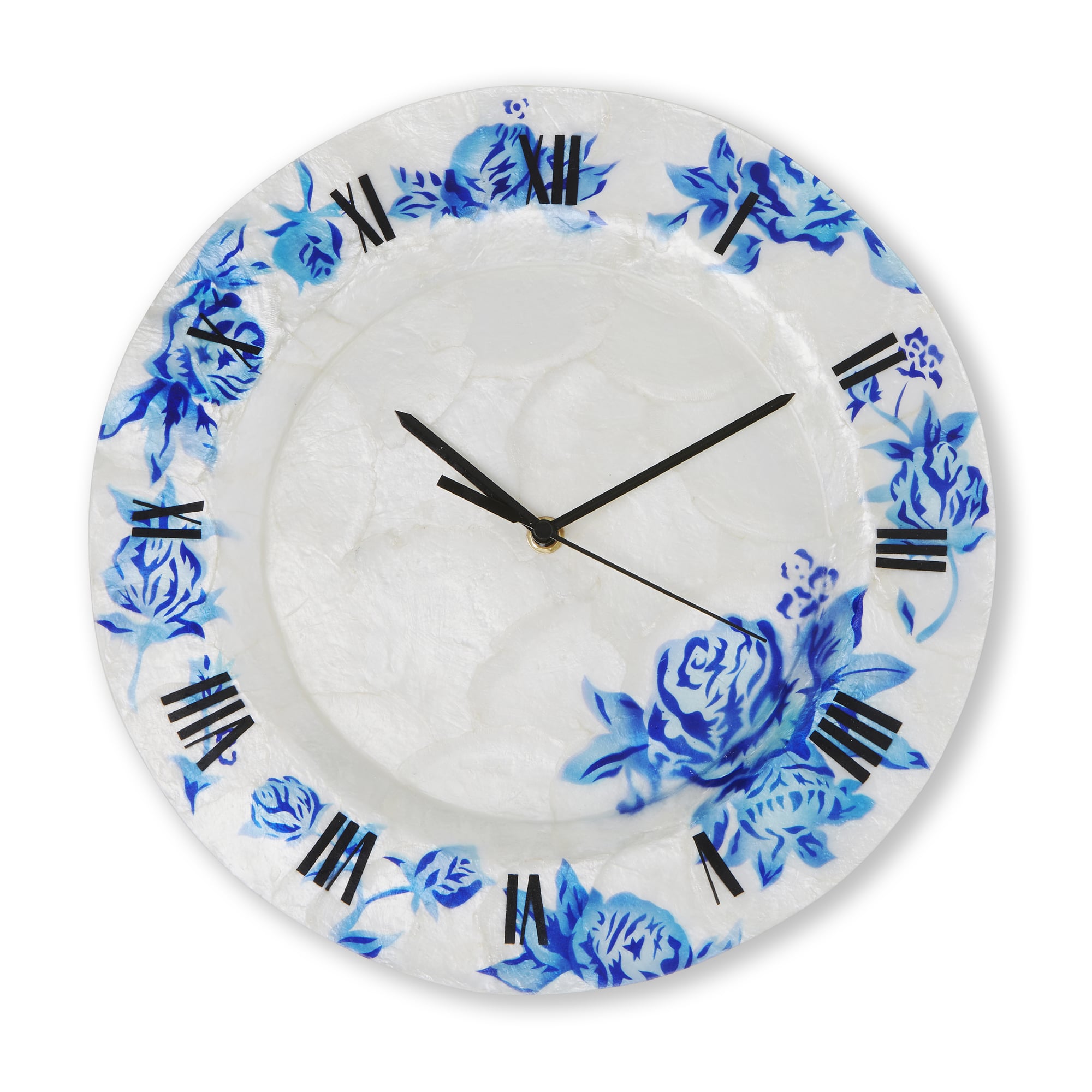 The frame of this clock is made with solid capiz oyster shell, compressed into shape. The artist seals the shells, leaving the natural color of the capiz as the base, pearl color of the clock face. Intricately designed blue roses are hand-painted and purposefully placed along the outer rim. Bold roman numberals are evenly spaced to complement the strong floral design. The combination provides a strong vintage appeal. Capiz is an oyster shell and the primary purpose of the oyster is as a source of food. However, the by-product, the shell, can be used for decoration. The clock is created by compressing capiz shell together and forming it into shape. The final result is a light-weight, plate that feels similar to plastic. Due to it being a natural material, the natural colors of the capiz may come through as tans and browns underneath the hand-painted surface.
The frame of this clock is made with solid capiz oyster shell, compressed into shape. The artist seals the shells, leaving the natural color of the capiz as the base, pearl color of the clock face. Intricately designed blue roses are hand-painted and purposefully placed along the outer rim. Bold roman numberals are evenly spaced to complement the strong floral design. The combination provides a strong vintage appeal. Capiz is an oyster shell and the primary purpose of the oyster is as a source of food. However, the by-product, the shell, can be used for decoration. The clock is created by compressing capiz shell together and forming it into shape. The final result is a light-weight, plate that feels similar to plastic. Due to it being a natural material, the natural colors of the capiz may come through as tans and browns underneath the hand-painted surface. -
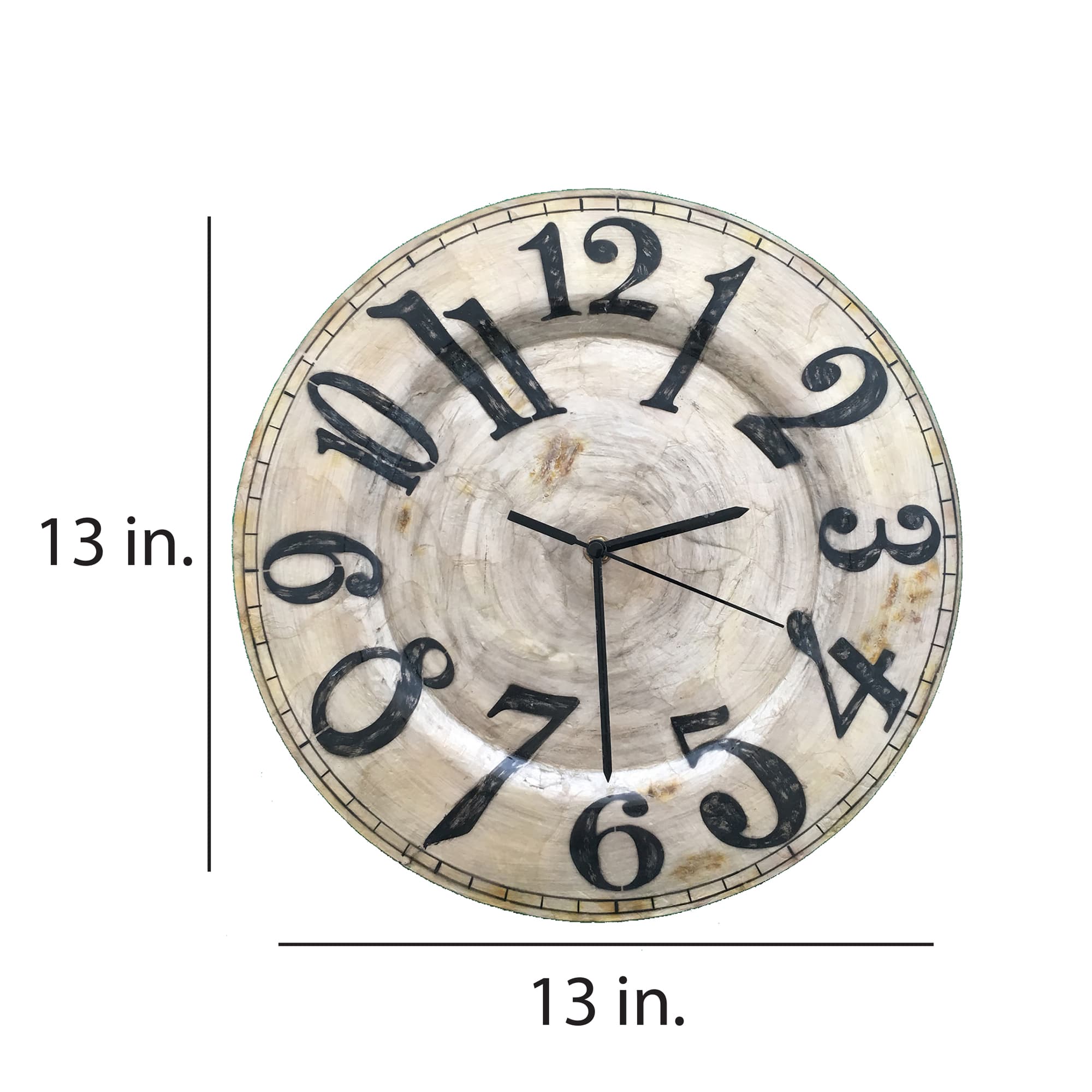
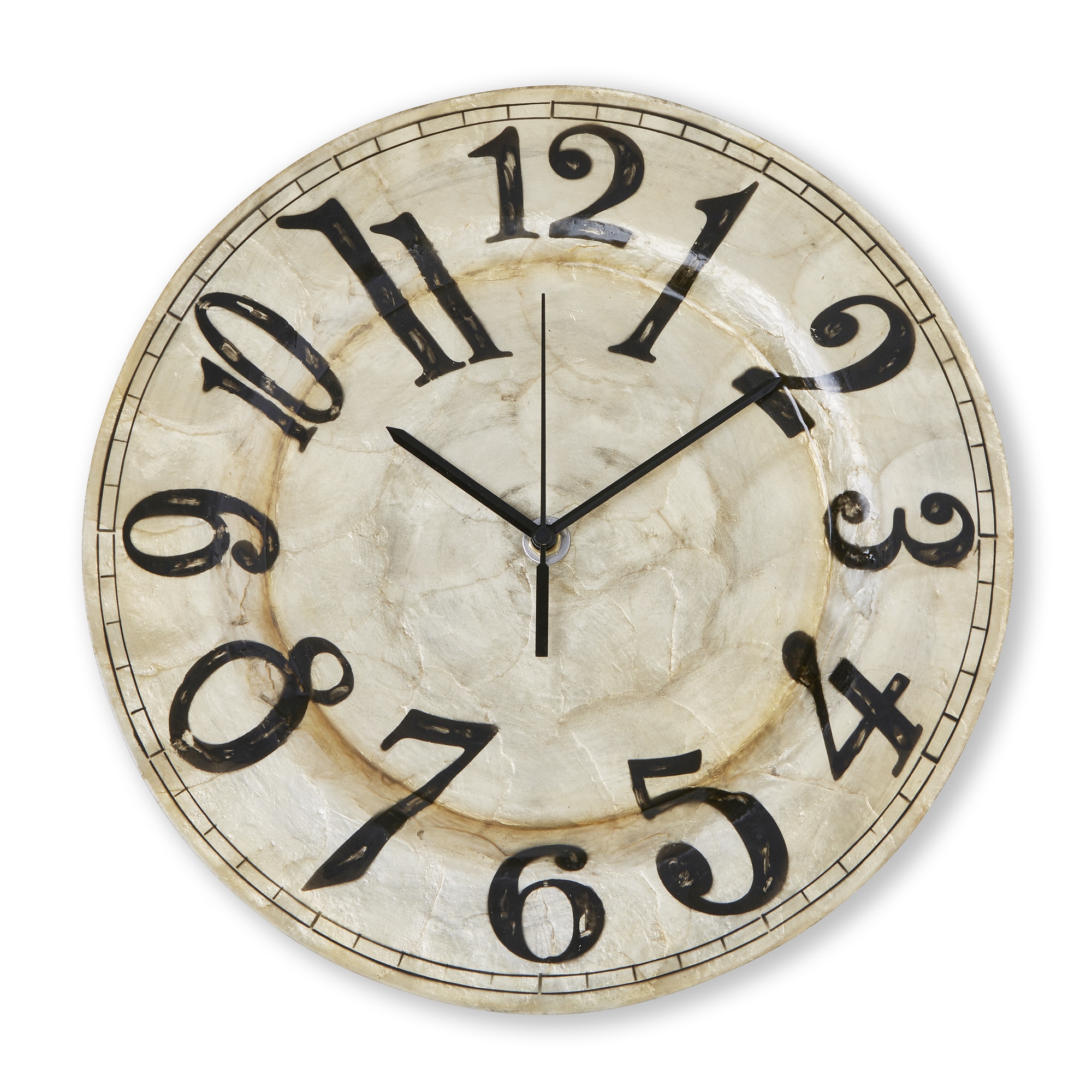 The frame of this clock is made with solid capiz oyster shell, compressed into shape. The face is hand-painted to appear as if it is aged porcelain, promoted by the natual colors of the capiz shell. The look is further accentuated by gentle distressed marks. The black, bold numbers vary in size and stand in strong contrast to the pearl background. The combination of simple color palette and the seasoned feel of the porcelain finish are quintessential hallmarks of the modern farmhouse design genre. Capiz is an oyster shell and the primary purpose of the oyster is as a source of food. However, the by-product, the shell, can be used for decoration. The clock is created by compressing capiz shell together and forming it into shape. The final result is a light-weight, plate that feels similar to plastic. Due to it being a natural material, the natural colors of the capiz may come through as tans and browns underneath the hand-painted surface.
The frame of this clock is made with solid capiz oyster shell, compressed into shape. The face is hand-painted to appear as if it is aged porcelain, promoted by the natual colors of the capiz shell. The look is further accentuated by gentle distressed marks. The black, bold numbers vary in size and stand in strong contrast to the pearl background. The combination of simple color palette and the seasoned feel of the porcelain finish are quintessential hallmarks of the modern farmhouse design genre. Capiz is an oyster shell and the primary purpose of the oyster is as a source of food. However, the by-product, the shell, can be used for decoration. The clock is created by compressing capiz shell together and forming it into shape. The final result is a light-weight, plate that feels similar to plastic. Due to it being a natural material, the natural colors of the capiz may come through as tans and browns underneath the hand-painted surface. -
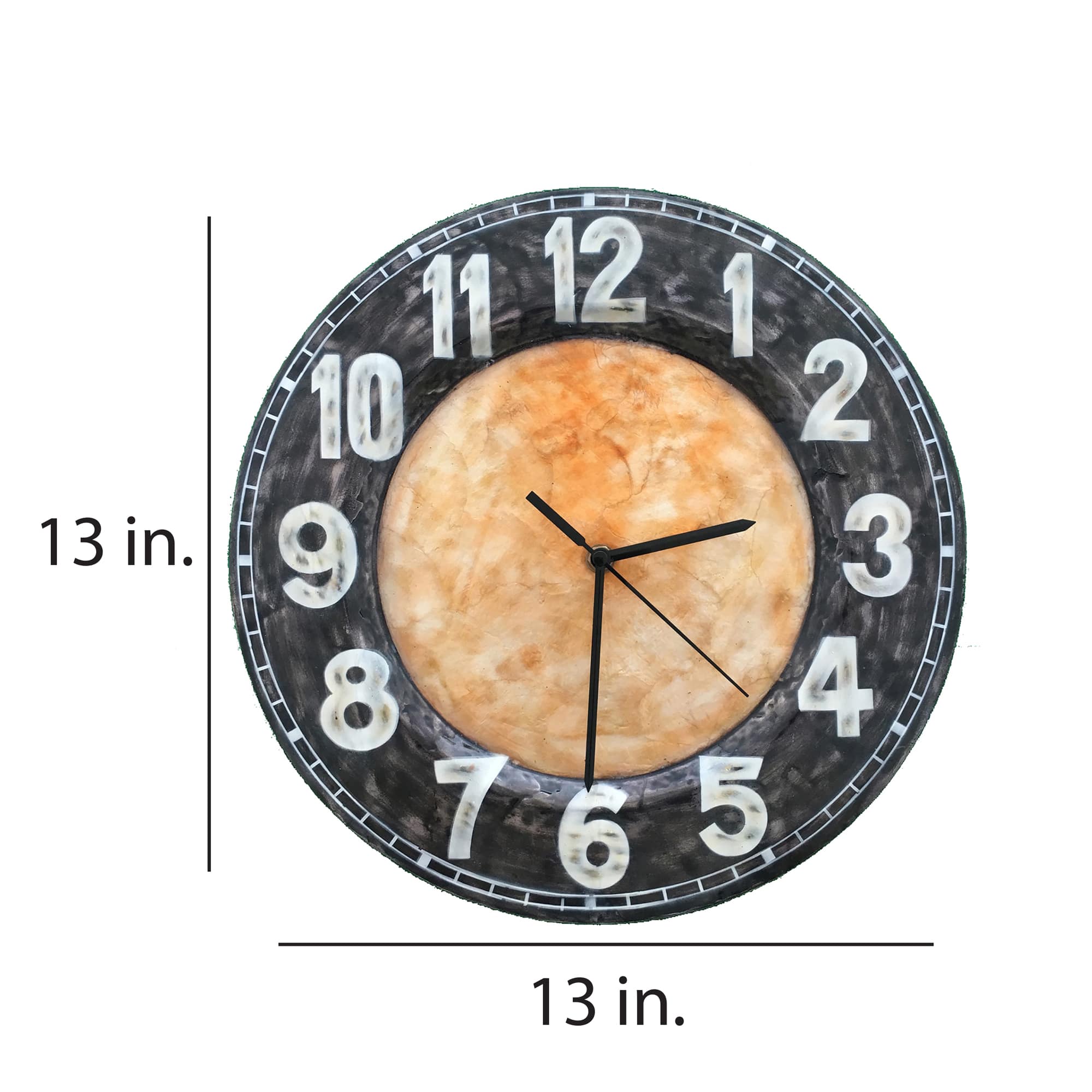
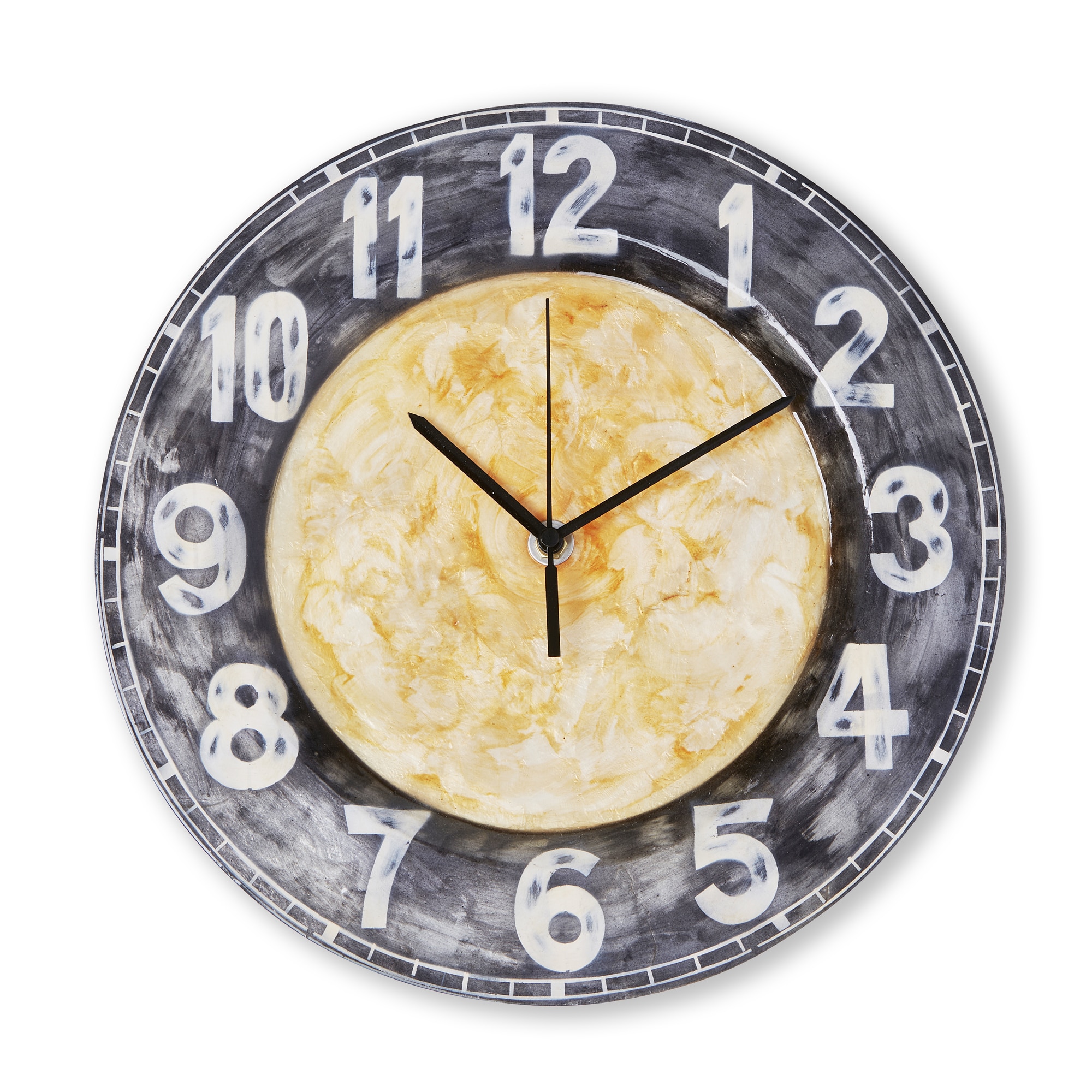 The frame of this clock is made with solid capiz oyster shell, compressed into shape. The texture and lines of the individual shell pieces still come through the hand-painted clock face. The center of the clock is sponge-painted resembling a Mediterranean, terra cotta finish. The darker outer rim and contrasting white, weathered numbers, complete this piece to feel as though it came from the old world. Capiz is an oyster shell and the primary purpose of the oyster is as a source of food. However, the by-product, the shell, can be used for decoration. The clock is created by compressing capiz shell together and forming it into shape. The final result is a light-weight, plate that feels similar to plastic. Due to it being a natural material, the natural colors of the capiz may come through as tans and browns underneath the hand-painted surface.
The frame of this clock is made with solid capiz oyster shell, compressed into shape. The texture and lines of the individual shell pieces still come through the hand-painted clock face. The center of the clock is sponge-painted resembling a Mediterranean, terra cotta finish. The darker outer rim and contrasting white, weathered numbers, complete this piece to feel as though it came from the old world. Capiz is an oyster shell and the primary purpose of the oyster is as a source of food. However, the by-product, the shell, can be used for decoration. The clock is created by compressing capiz shell together and forming it into shape. The final result is a light-weight, plate that feels similar to plastic. Due to it being a natural material, the natural colors of the capiz may come through as tans and browns underneath the hand-painted surface. -
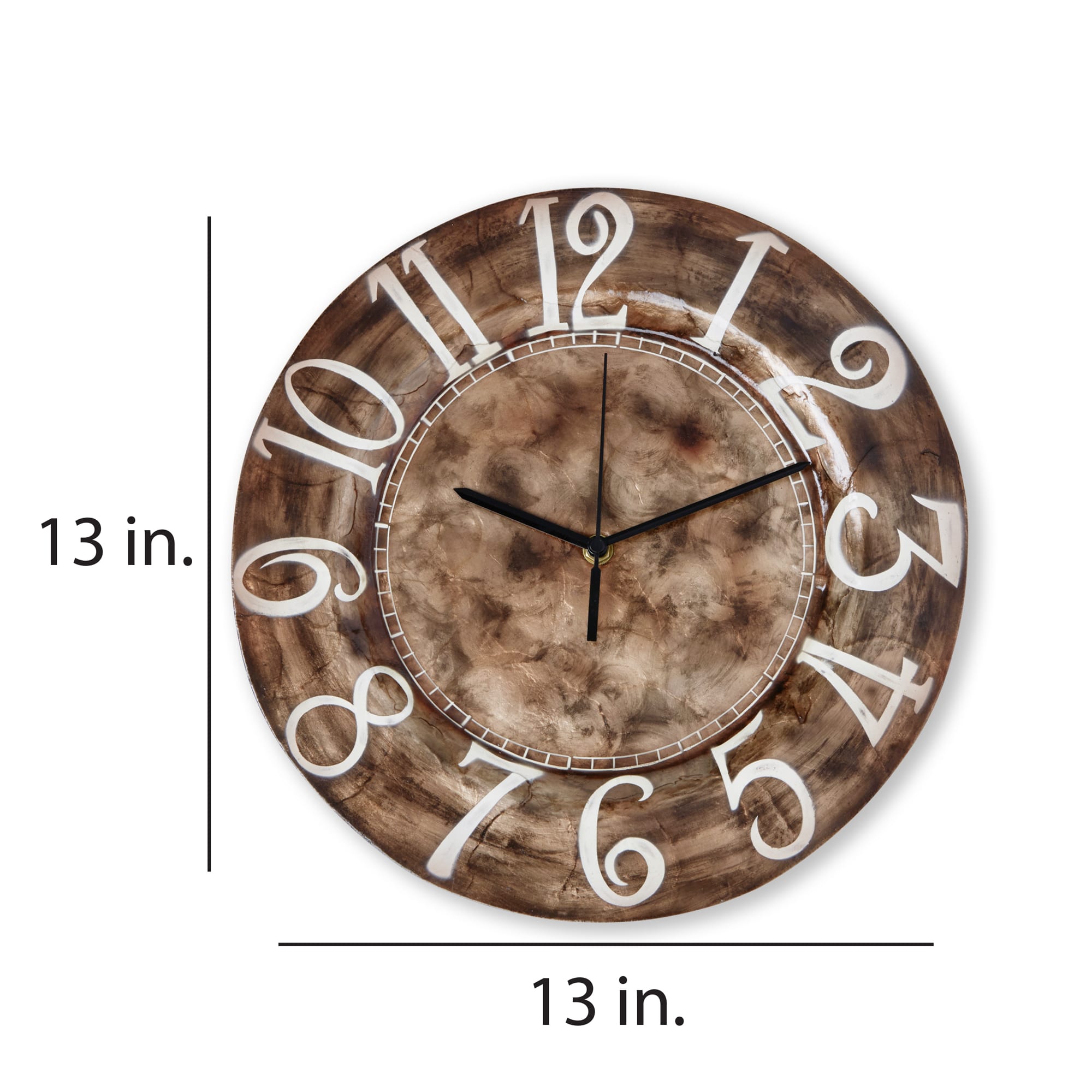
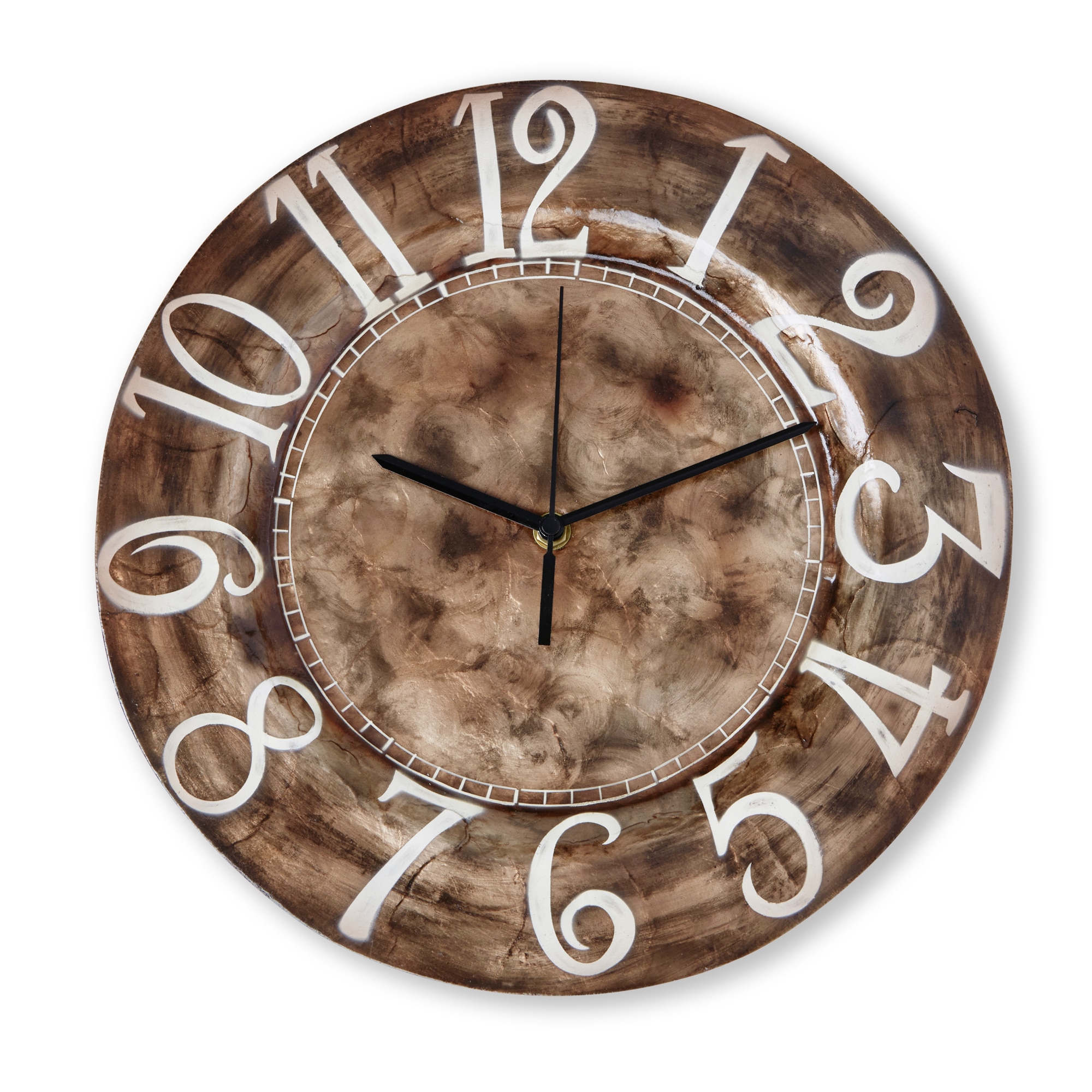 The frame of this clock is made with solid capiz oyster shell, compressed into shape. The texture and lines of the individual shell pieces still come through the broad brush strokes of brown on the background of the clock. The distressed look of the earthy, rich background color giving an aged feel which is complemented by the added detail of the weathered, hand-painted numbers. Capiz is an oyster shell and the primary purpose of the oyster is as a source of food. However, the by-product, the shell, can be used for decoration. The clock is created by compressing capiz shell together and forming it into shape. The final result is a light-weight, plate that feels similar to plastic. Due to it being a natural material, the natural colors of the capiz may come through as tans and browns underneath the hand-painted surface.
The frame of this clock is made with solid capiz oyster shell, compressed into shape. The texture and lines of the individual shell pieces still come through the broad brush strokes of brown on the background of the clock. The distressed look of the earthy, rich background color giving an aged feel which is complemented by the added detail of the weathered, hand-painted numbers. Capiz is an oyster shell and the primary purpose of the oyster is as a source of food. However, the by-product, the shell, can be used for decoration. The clock is created by compressing capiz shell together and forming it into shape. The final result is a light-weight, plate that feels similar to plastic. Due to it being a natural material, the natural colors of the capiz may come through as tans and browns underneath the hand-painted surface. -
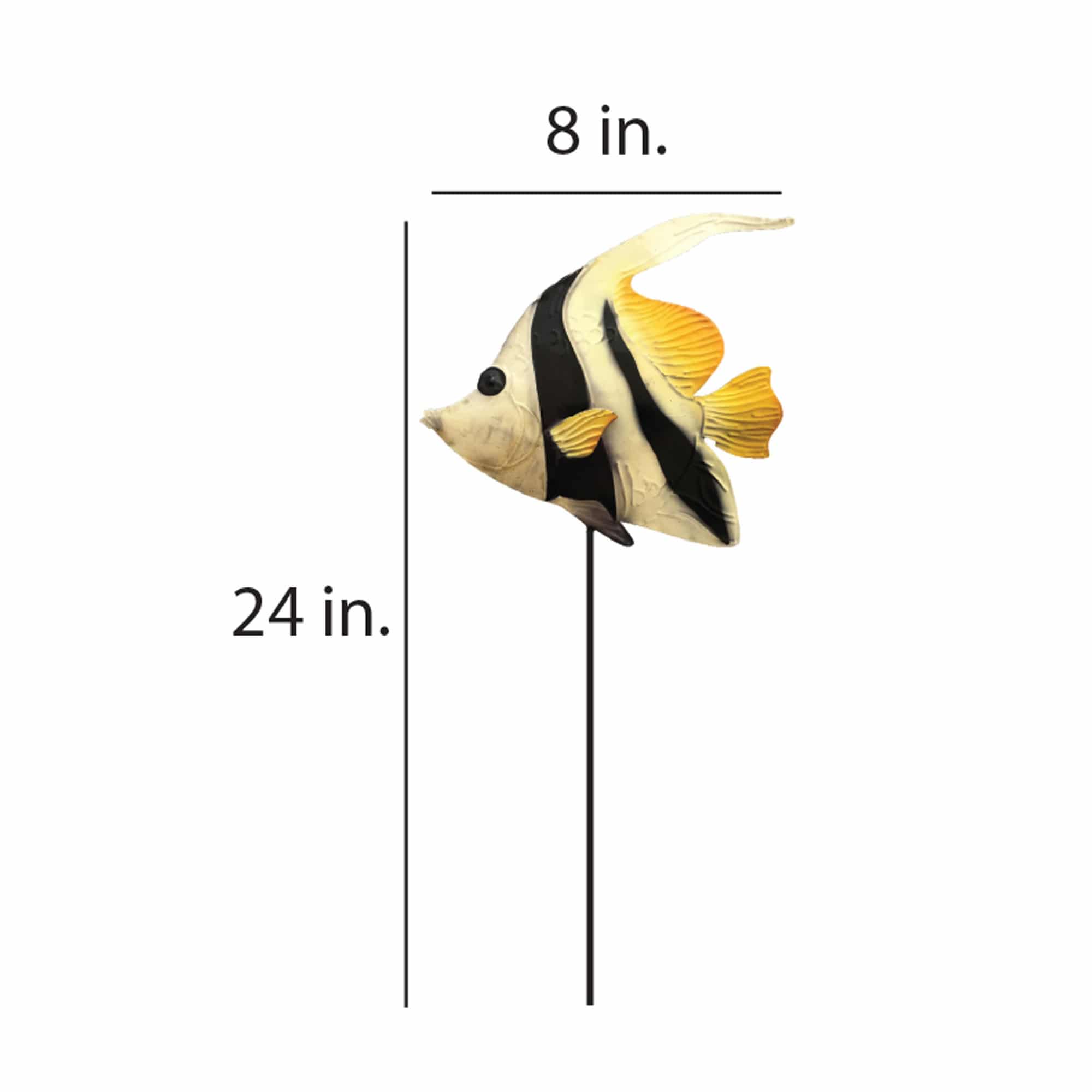
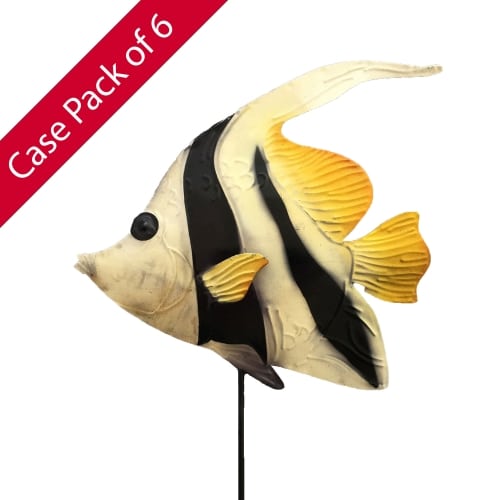 Case of 6 With its contrast of black and yellow and long iconic dorsal fin, the Moorish Idol Angle is well recognized by aquatic hobbyist and novices alike. This moderately peaceful fish is found throughout the southern hemisphere. The artist took great care on showing the big details common to the fish, but on closer examination one will see some color variations and shading in the paint itself. Handcrafted from metal then hand-painted and sealed.
Case of 6 With its contrast of black and yellow and long iconic dorsal fin, the Moorish Idol Angle is well recognized by aquatic hobbyist and novices alike. This moderately peaceful fish is found throughout the southern hemisphere. The artist took great care on showing the big details common to the fish, but on closer examination one will see some color variations and shading in the paint itself. Handcrafted from metal then hand-painted and sealed. -
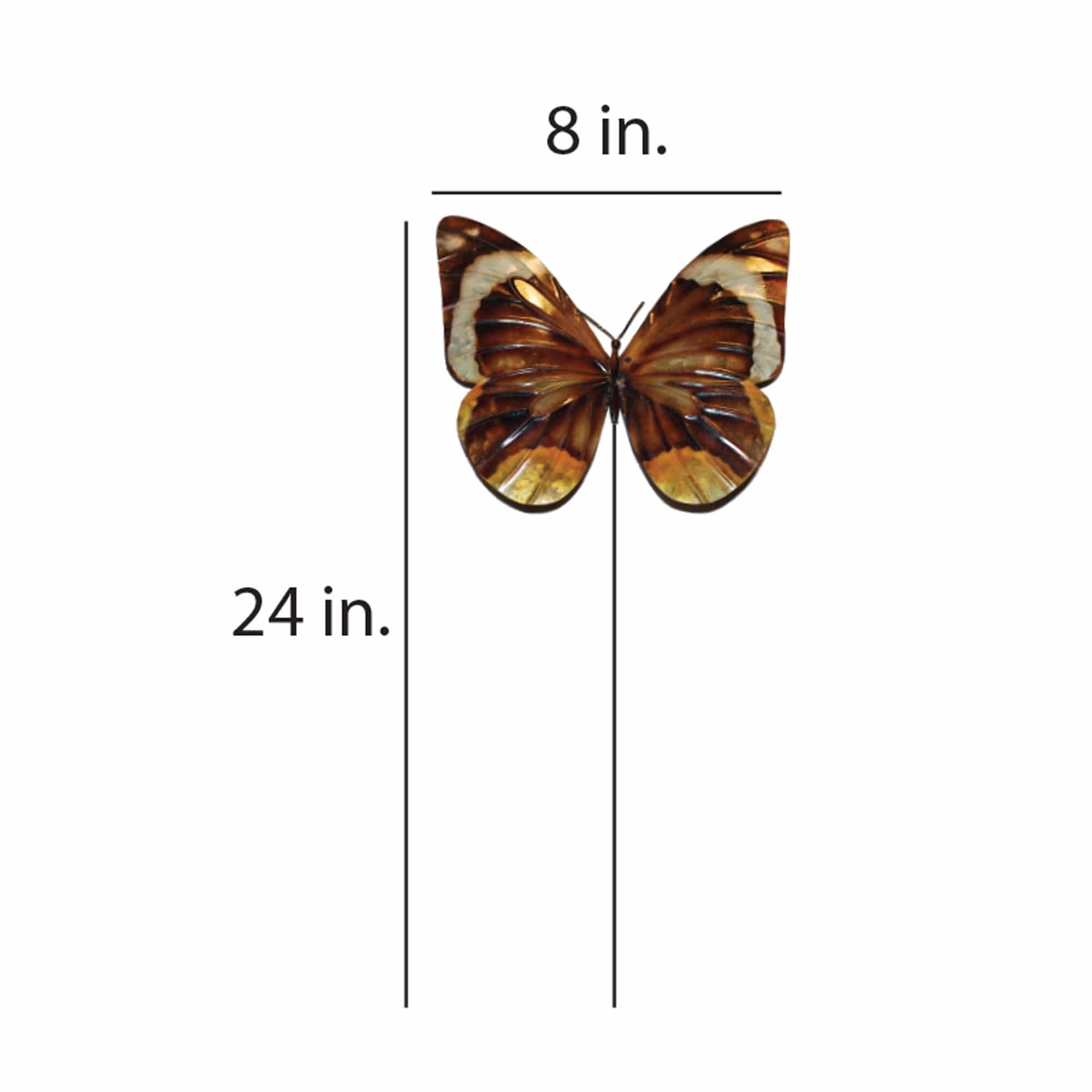
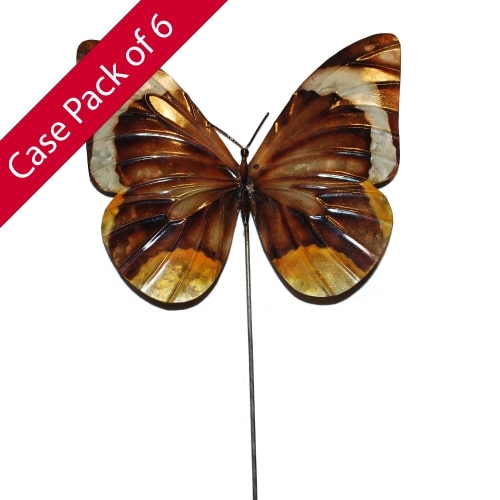 Case of 6 Neutral earth tones fill the body of this butterfly. A beautiful autumn brown sets around highlights of pearl and yellow. Whether placed with a potted plant or in a garden bed, this butterfly will add the finishing touch to any environment. Handcrafted from metal then hand-painted and sealed.
Case of 6 Neutral earth tones fill the body of this butterfly. A beautiful autumn brown sets around highlights of pearl and yellow. Whether placed with a potted plant or in a garden bed, this butterfly will add the finishing touch to any environment. Handcrafted from metal then hand-painted and sealed. -
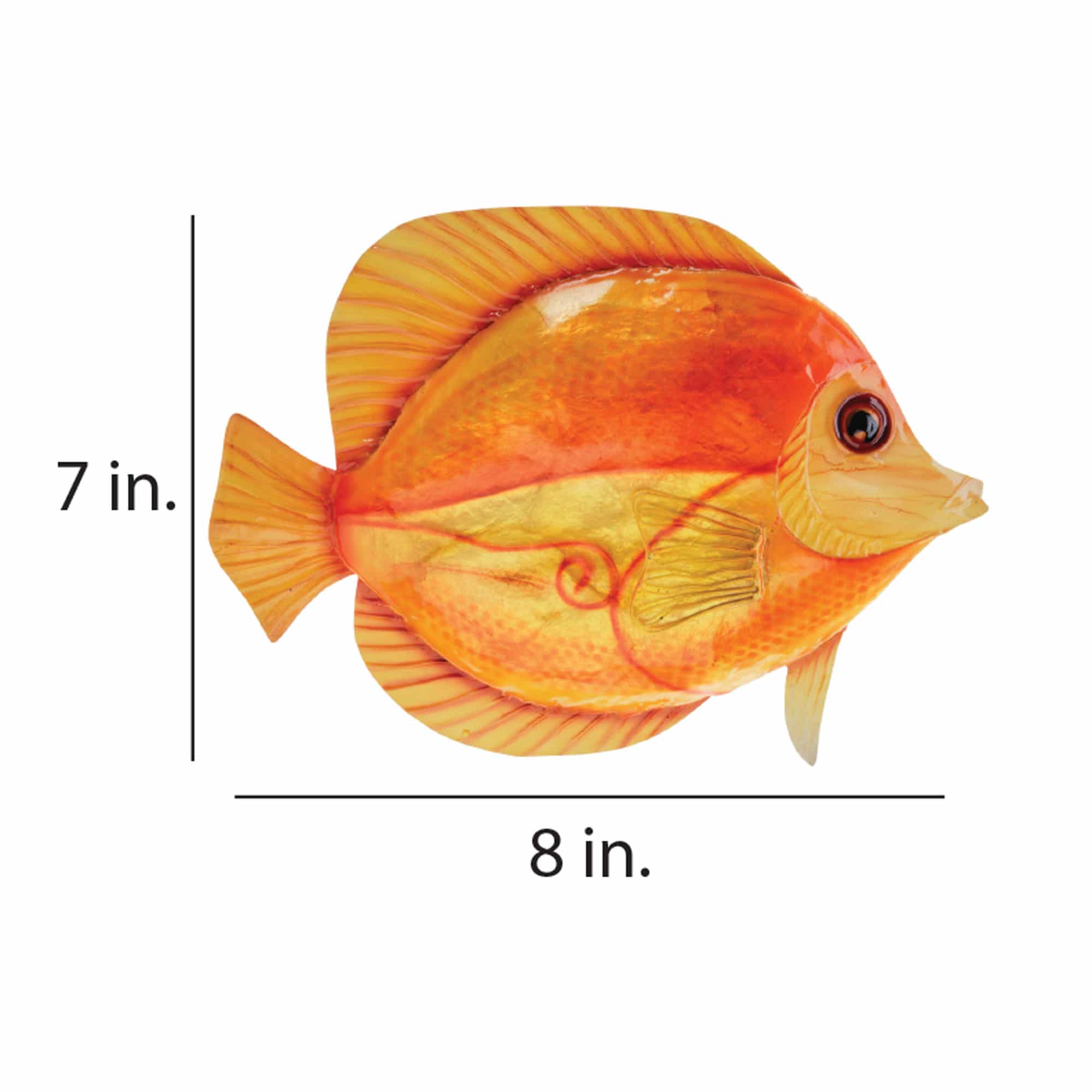
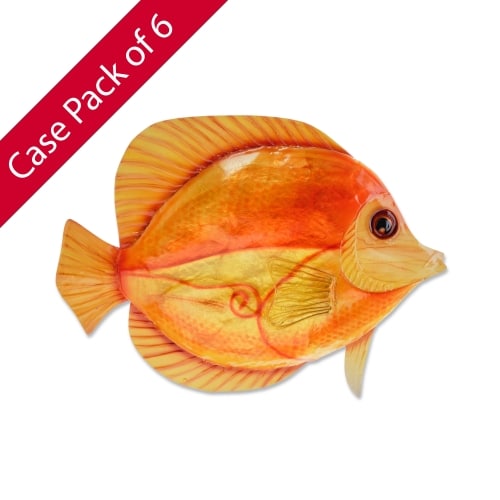 Case of 6 The discus fish is native to the Amazon river basin. These fish are known for their distinctive shape, bright colors, and unique patterns. The artist who painted this fish paid attention to the interacting color patterns. Using capiz shell, he emulated the natural scales of this fish. The basic frame of the wall fish is created using tin, which is powder coated as a black finish. The frame is reinforced using wrought iron wire along the inner edge. Capiz is an oyster shell and the primary purpose of the oyster is as a source of food. However, the by-product, the shell, can be used for decoration. Due to it being a natural material, the natural colors of the capiz can come through as tans and browns underneath the paint.
Case of 6 The discus fish is native to the Amazon river basin. These fish are known for their distinctive shape, bright colors, and unique patterns. The artist who painted this fish paid attention to the interacting color patterns. Using capiz shell, he emulated the natural scales of this fish. The basic frame of the wall fish is created using tin, which is powder coated as a black finish. The frame is reinforced using wrought iron wire along the inner edge. Capiz is an oyster shell and the primary purpose of the oyster is as a source of food. However, the by-product, the shell, can be used for decoration. Due to it being a natural material, the natural colors of the capiz can come through as tans and browns underneath the paint. -
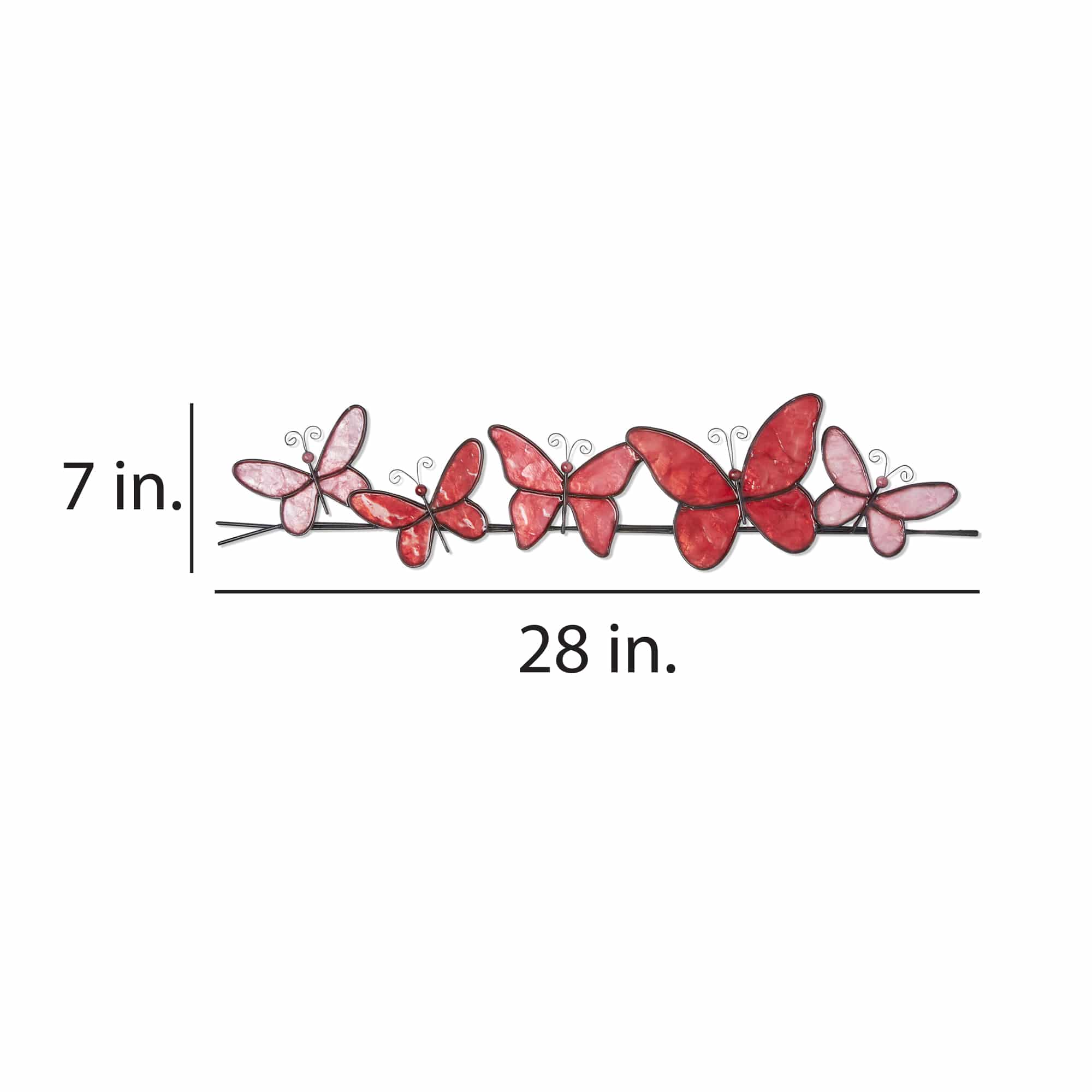
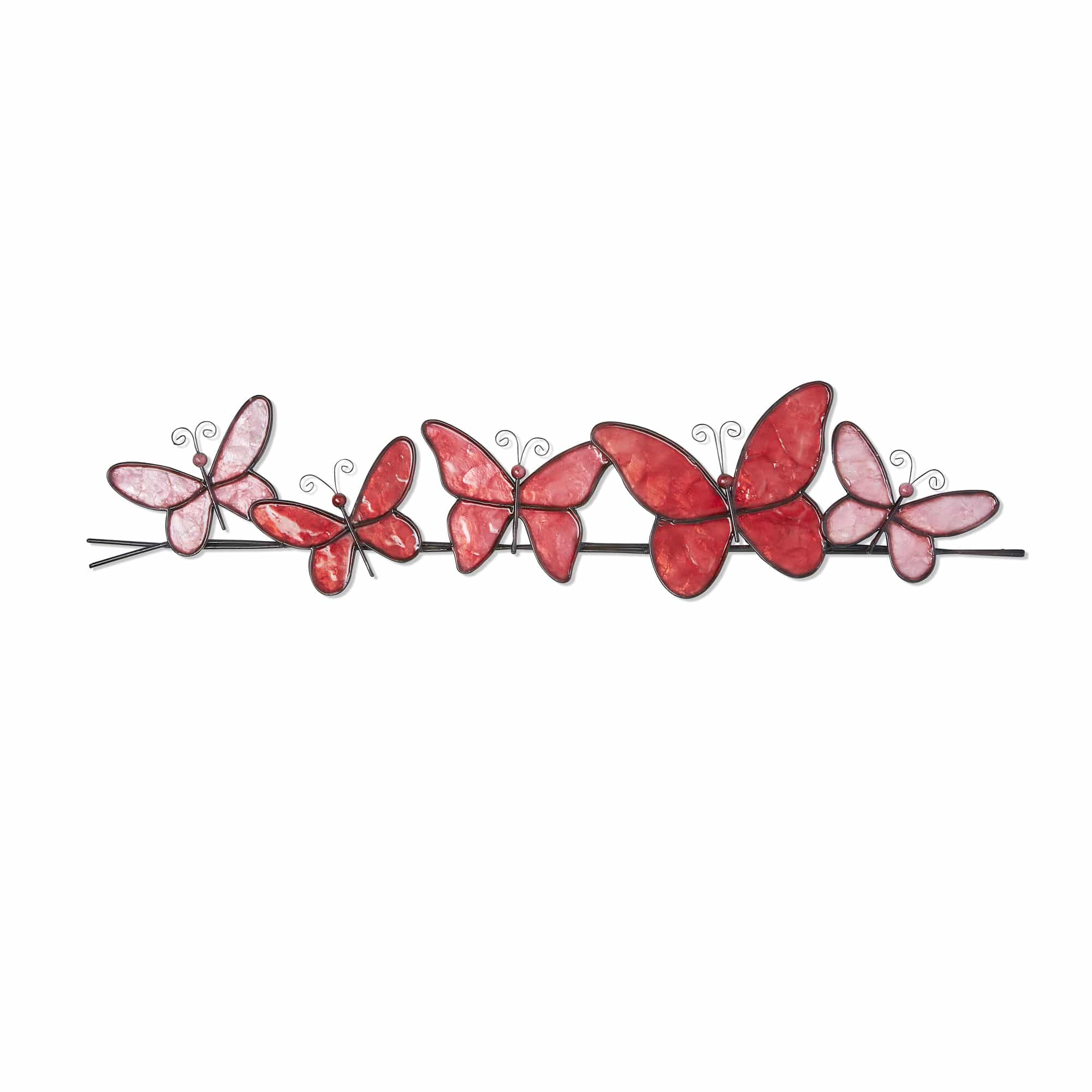
Five, fluttering butterflies are ready to complete their journey after taking a break from a long migration. The slender, metal body of each butterfly connects to colorful capiz-shell wings which catches light and adds shine. Each wing is framed using sturdy wrought iron and reinforced with a metal backing.
The basic frame of the butterfly is created using tin, which is powder-coated with a black finish and makes this piece safe to use outdoors. The edges of the frame are reinforced using thicker tin wire. The front of this piece is adorned in areas with capiz shell, an oyster native to the Philippines, before being hand-painted and sealed with a water-based sealant. The primary purpose of this oyster to provide a source of food, however, the shell is a sustainable by-product that can be used for decoration. The capiz shell subtly replicates the reflective qualities of butterflies in nature. The entire piece is lightweight and has an eyelet in the back allowing it to be hung using a finishing nail, command strip, or a push pin. Due to it being a natural material, the organic colors of capiz come through as tans and browns underneath the paint.
-
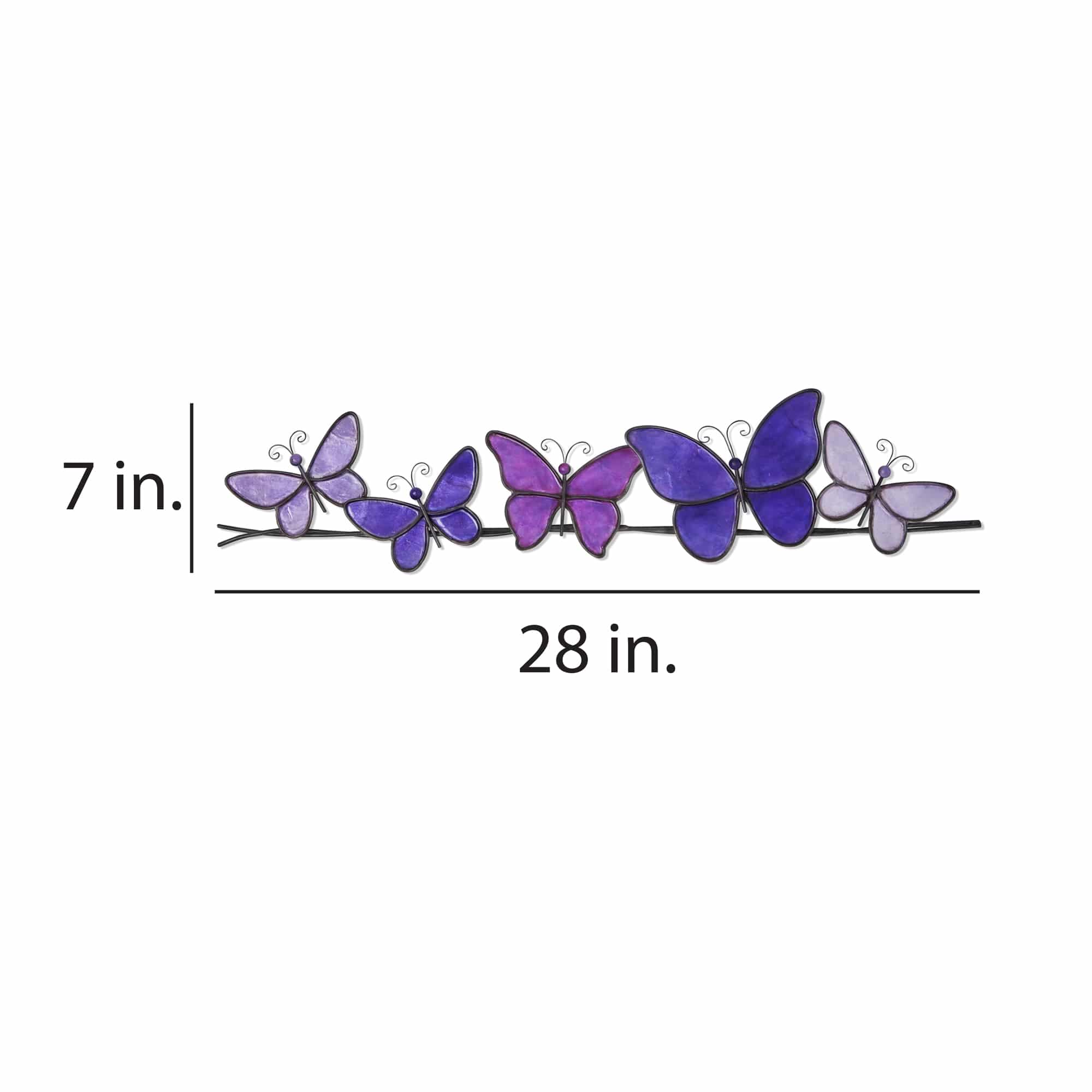
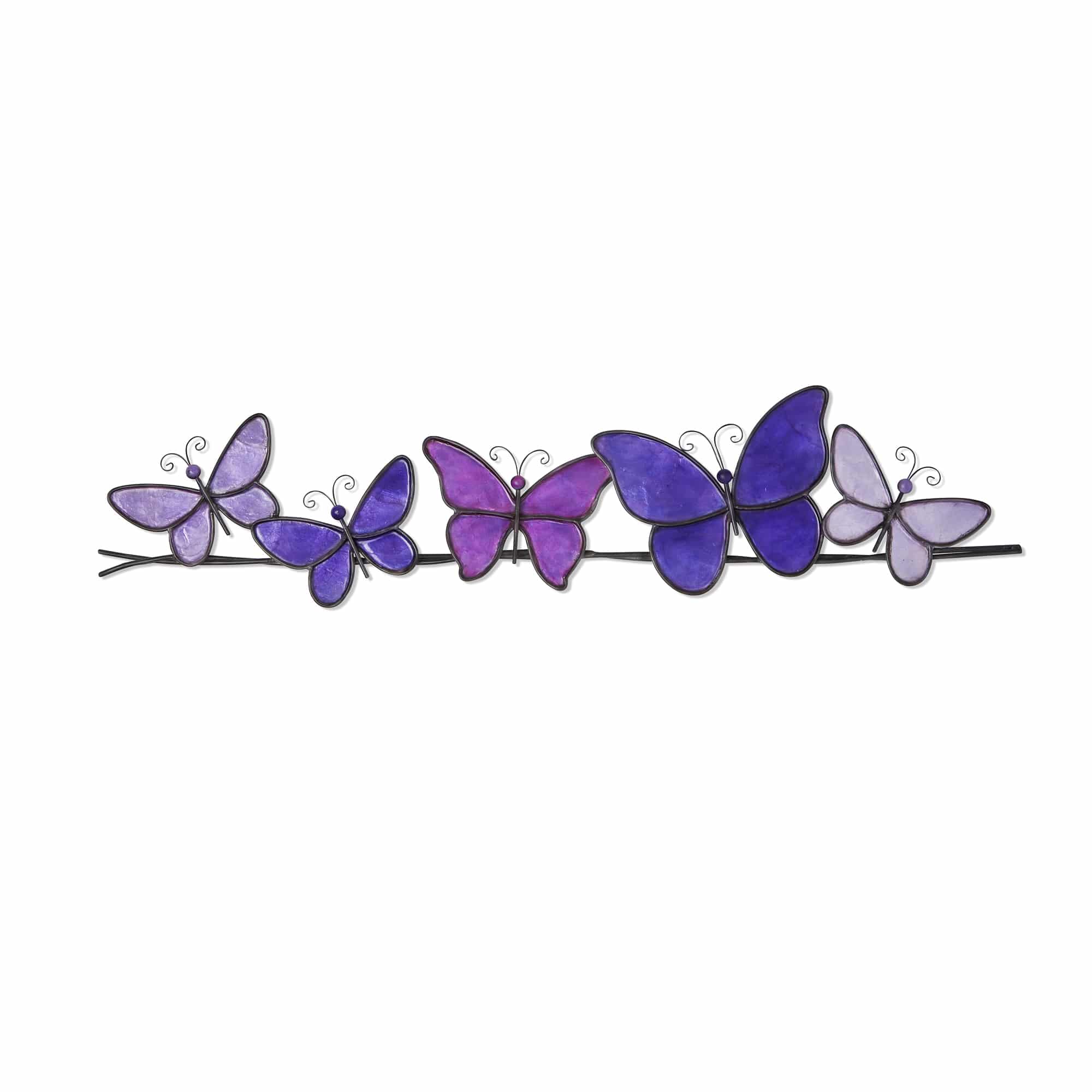
Five, fluttering butterflies are ready to complete their journey after taking a break from a long migration. The slender, metal body of each butterfly connects to colorful capiz-shell wings which catches light and adds shine. Each wing is framed using sturdy wrought iron and reinforced with a metal backing.
The basic frame of the butterfly is created using tin, which is powder-coated with a black finish and makes this piece safe to use outdoors. The edges of the frame are reinforced using thicker tin wire. The front of this piece is adorned in areas with capiz shell, an oyster native to the Philippines, before being hand-painted and sealed with a water-based sealant. The primary purpose of this oyster to provide a source of food, however, the shell is a sustainable by-product that can be used for decoration. The capiz shell subtly replicates the reflective qualities of butterflies in nature. The entire piece is lightweight and has an eyelet in the back allowing it to be hung using a finishing nail, command strip, or a push pin. Due to it being a natural material, the organic colors of capiz come through as tans and browns underneath the paint.
-
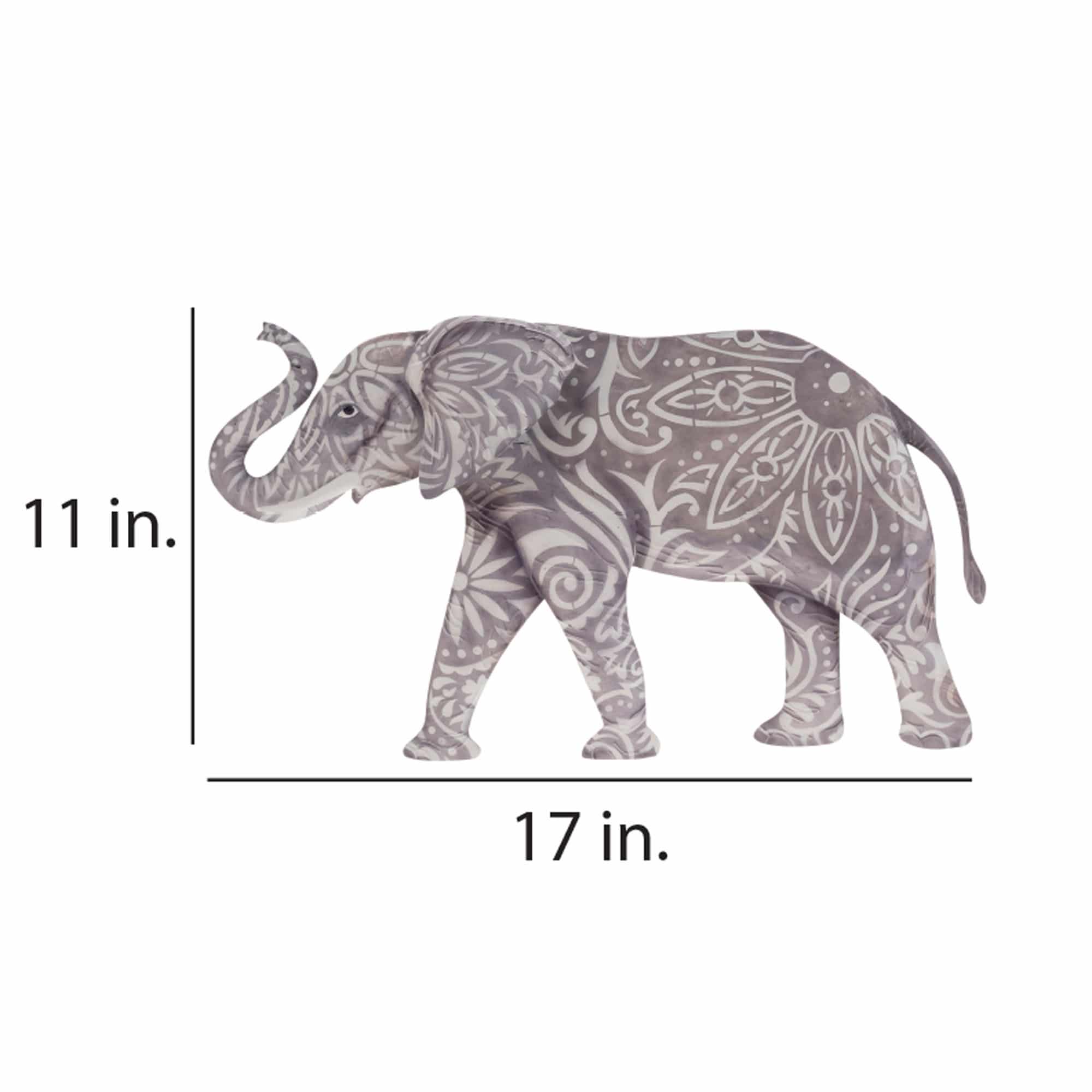
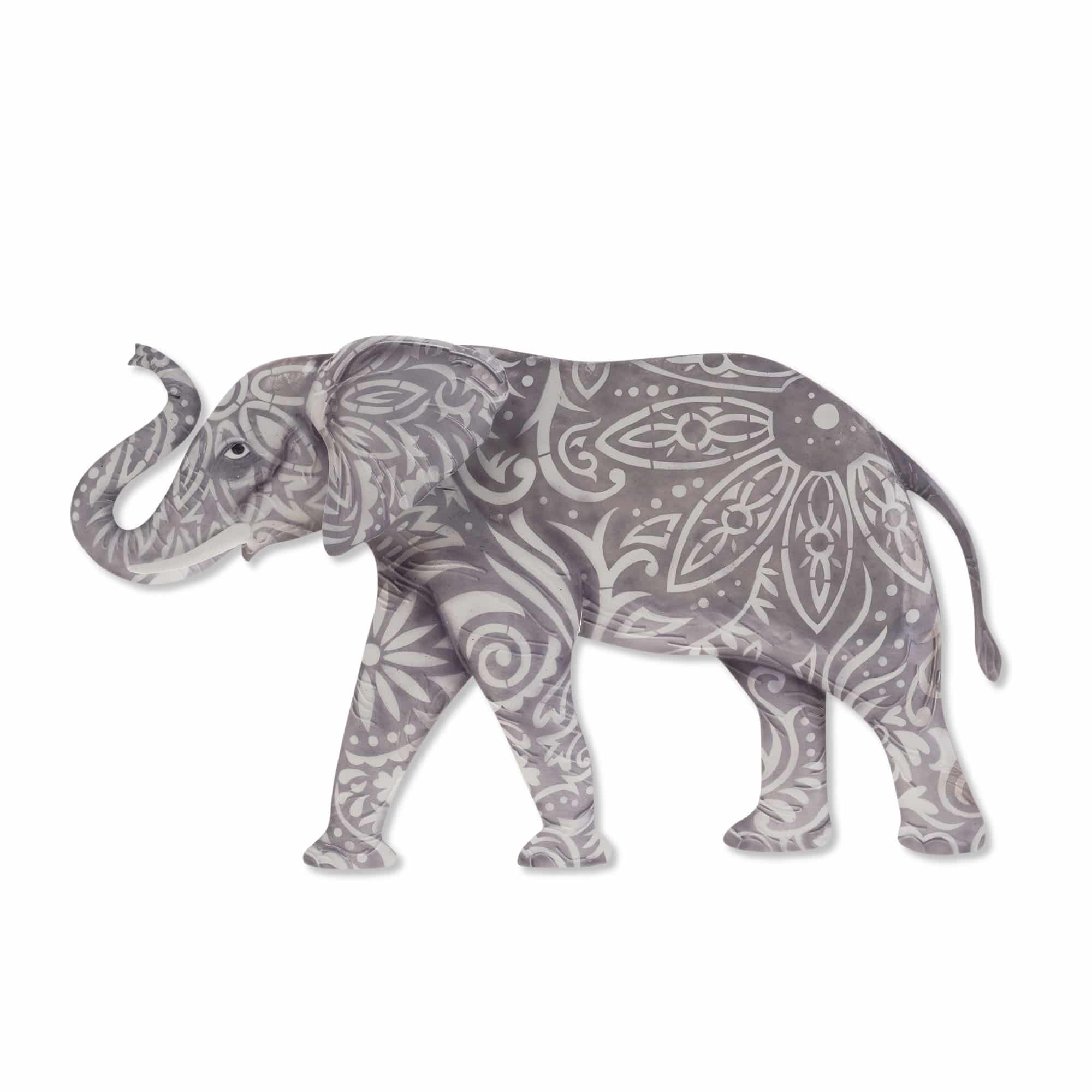 According to feng shui, an elephant with its trunk raised will shower good luck to those around it. It is a symbol for intelligence, curiosity, kindness and strength. The basic shape of this handcrafted metal elephant has its powerful trunk raised due to the importance of the symbolism. Furthermore, the artisan hand-paints the body in a colorful pattern influenced by designs from different Eastern cultures. Placing such a symbol near a door is said to welcome beneficial energy into that space. The basic frame of the is created using tin, which is powder coated with a black finish. The frame is reinforced using tin wire along the inner edge. Capiz is an oyster shell and the primary purpose of the oyster is as a source of food. However, the by-product, the shell, can be used for decoration. Due to it being a natural material, the natural colors of the capiz come through as tans and browns underneath the paint. The shell is then painted the bold colors you see. The entire front facing piece is carefully hand-painted.
According to feng shui, an elephant with its trunk raised will shower good luck to those around it. It is a symbol for intelligence, curiosity, kindness and strength. The basic shape of this handcrafted metal elephant has its powerful trunk raised due to the importance of the symbolism. Furthermore, the artisan hand-paints the body in a colorful pattern influenced by designs from different Eastern cultures. Placing such a symbol near a door is said to welcome beneficial energy into that space. The basic frame of the is created using tin, which is powder coated with a black finish. The frame is reinforced using tin wire along the inner edge. Capiz is an oyster shell and the primary purpose of the oyster is as a source of food. However, the by-product, the shell, can be used for decoration. Due to it being a natural material, the natural colors of the capiz come through as tans and browns underneath the paint. The shell is then painted the bold colors you see. The entire front facing piece is carefully hand-painted. -
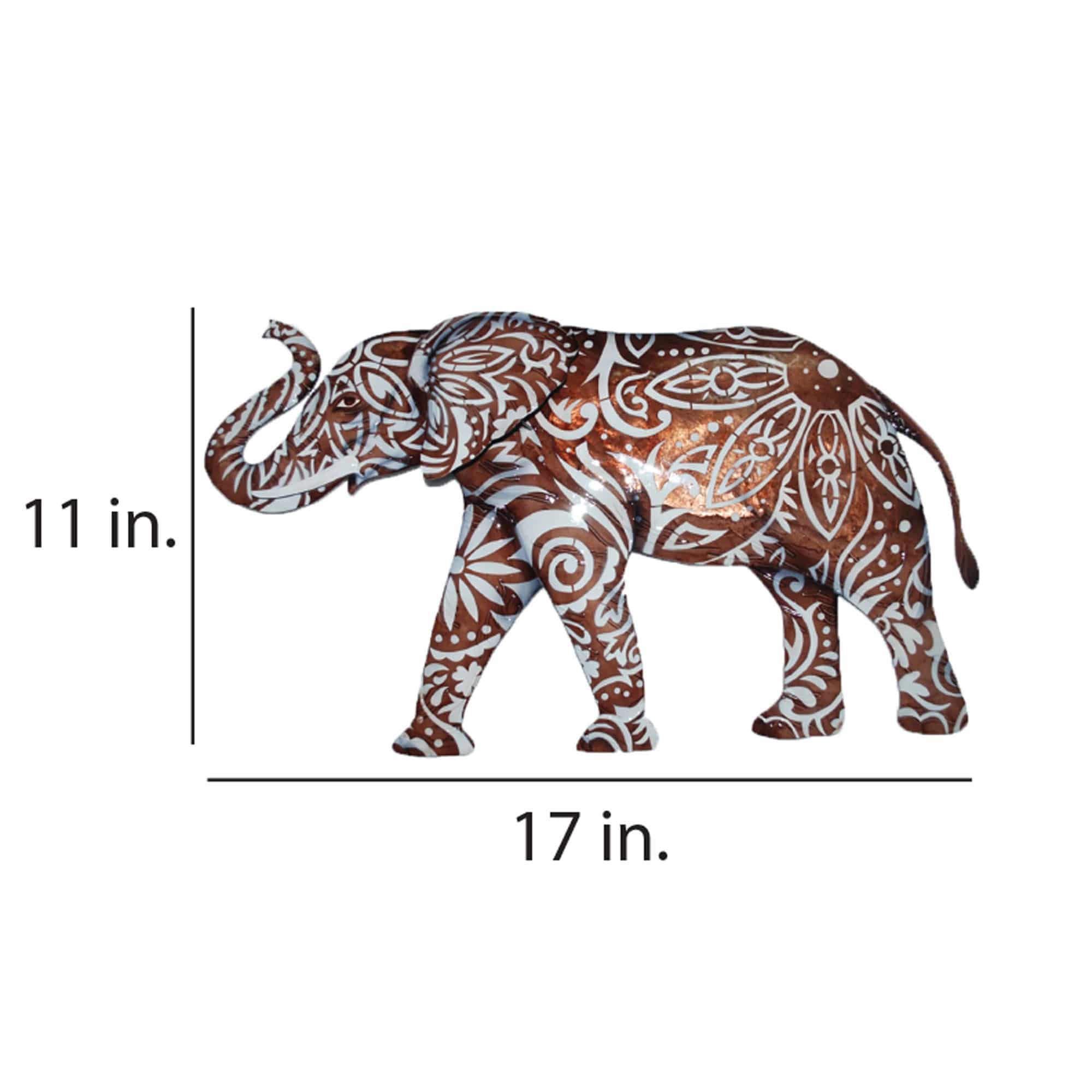
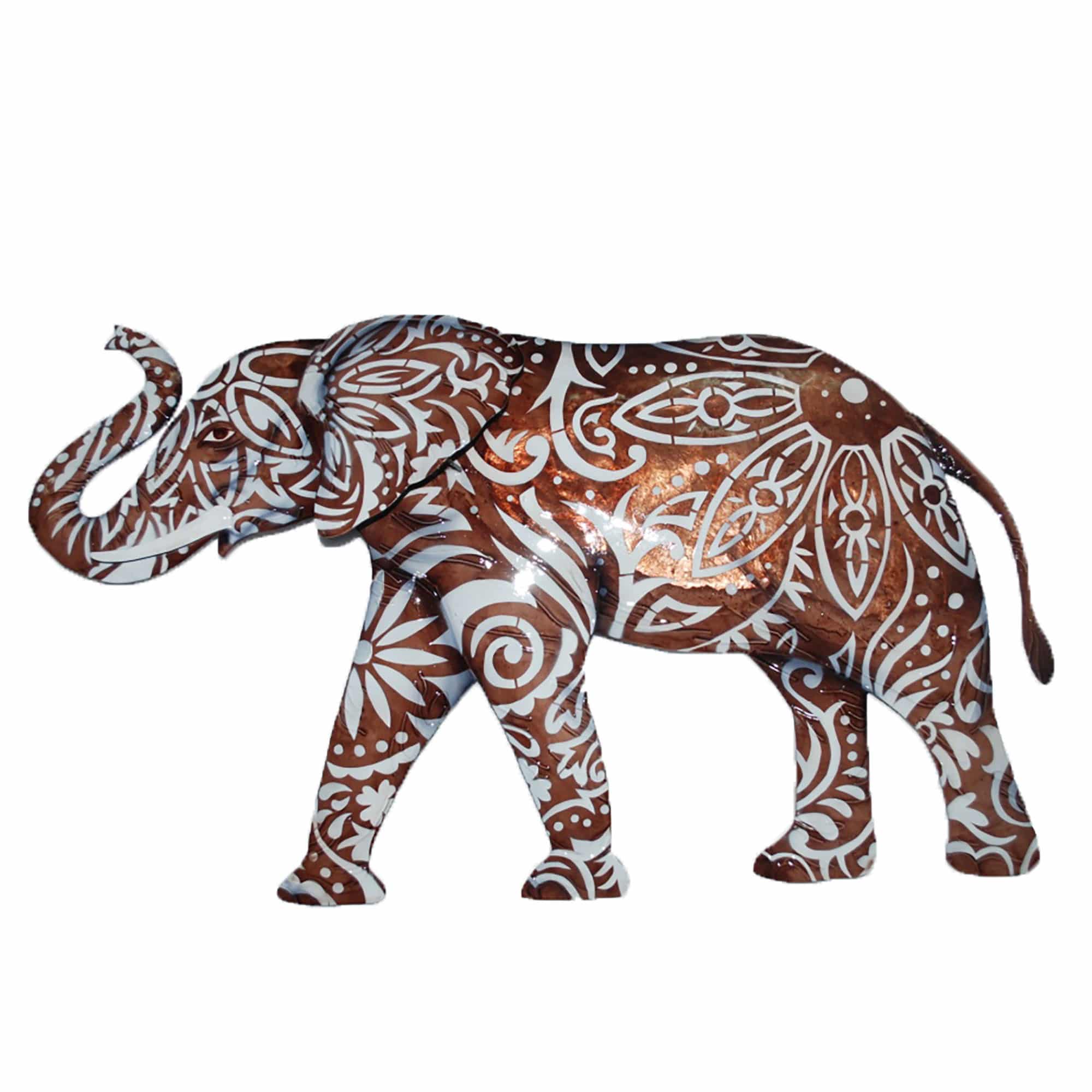 According to feng shui, an elephant with its trunk raised will shower good luck to those around it. It is a symbol for intelligence, curiosity, kindness and strength. The basic shape of this handcrafted metal elephant has its powerful trunk raised due to the importance of the symbolism. Furthermore, the artisan hand-paints the body in a colorful pattern influenced by designs from different Eastern cultures. Placing such a symbol near a door is said to welcome beneficial energy into that space. The basic frame of the is created using tin, which is powder coated with a black finish. The frame is reinforced using tin wire along the inner edge. Capiz is an oyster shell and the primary purpose of the oyster is as a source of food. However, the by-product, the shell, can be used for decoration. Due to it being a natural material, the natural colors of the capiz come through as tans and browns underneath the paint. The shell is then painted the bold colors you see. The entire front facing piece is carefully hand-painted.
According to feng shui, an elephant with its trunk raised will shower good luck to those around it. It is a symbol for intelligence, curiosity, kindness and strength. The basic shape of this handcrafted metal elephant has its powerful trunk raised due to the importance of the symbolism. Furthermore, the artisan hand-paints the body in a colorful pattern influenced by designs from different Eastern cultures. Placing such a symbol near a door is said to welcome beneficial energy into that space. The basic frame of the is created using tin, which is powder coated with a black finish. The frame is reinforced using tin wire along the inner edge. Capiz is an oyster shell and the primary purpose of the oyster is as a source of food. However, the by-product, the shell, can be used for decoration. Due to it being a natural material, the natural colors of the capiz come through as tans and browns underneath the paint. The shell is then painted the bold colors you see. The entire front facing piece is carefully hand-painted. -
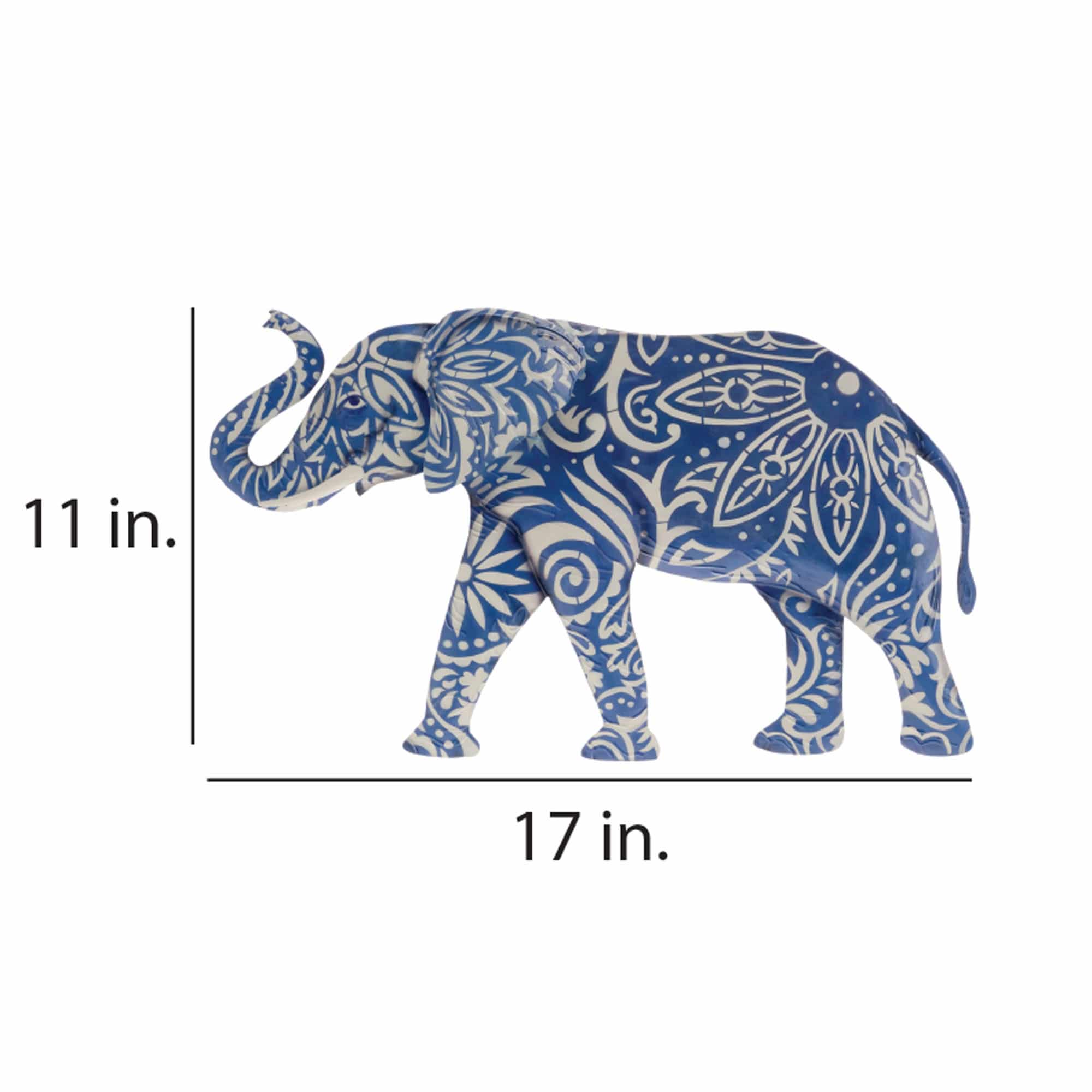
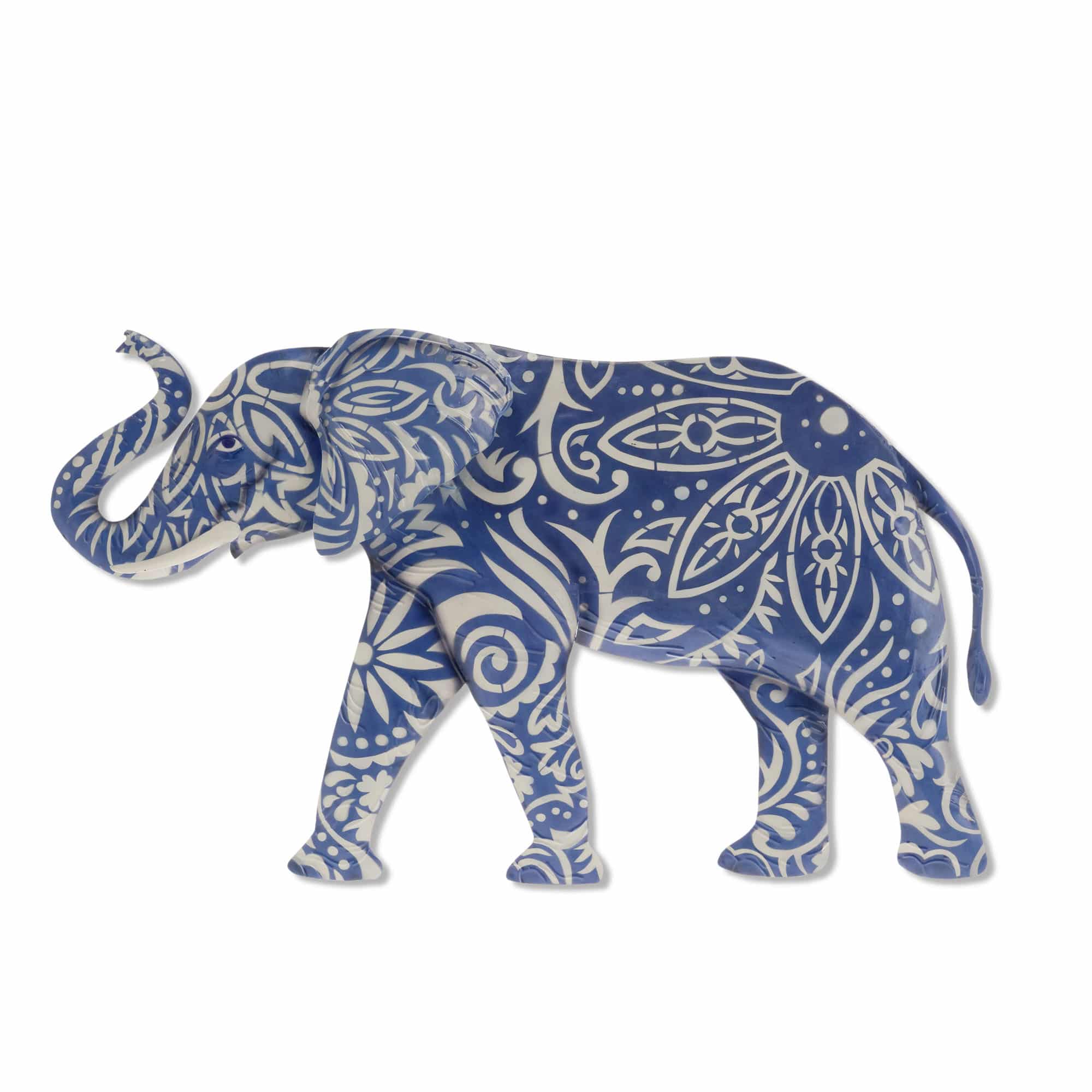 According to feng shui, an elephant with its trunk raised will shower good luck to those around it. It is a symbol for intelligence, curiosity, kindness and strength. The basic shape of this handcrafted metal elephant has its powerful trunk raised due to the importance of the symbolism. Furthermore, the artisan hand-paints the body in a colorful pattern influenced by designs from different Eastern cultures. Placing such a symbol near a door is said to welcome beneficial energy into that space. The basic frame of the is created using tin, which is powder coated with a black finish. The frame is reinforced using tin wire along the inner edge. Capiz is an oyster shell and the primary purpose of the oyster is as a source of food. However, the by-product, the shell, can be used for decoration. Due to it being a natural material, the natural colors of the capiz come through as tans and browns underneath the paint. The shell is then painted the bold colors you see. The entire front facing piece is carefully hand-painted.
According to feng shui, an elephant with its trunk raised will shower good luck to those around it. It is a symbol for intelligence, curiosity, kindness and strength. The basic shape of this handcrafted metal elephant has its powerful trunk raised due to the importance of the symbolism. Furthermore, the artisan hand-paints the body in a colorful pattern influenced by designs from different Eastern cultures. Placing such a symbol near a door is said to welcome beneficial energy into that space. The basic frame of the is created using tin, which is powder coated with a black finish. The frame is reinforced using tin wire along the inner edge. Capiz is an oyster shell and the primary purpose of the oyster is as a source of food. However, the by-product, the shell, can be used for decoration. Due to it being a natural material, the natural colors of the capiz come through as tans and browns underneath the paint. The shell is then painted the bold colors you see. The entire front facing piece is carefully hand-painted. -

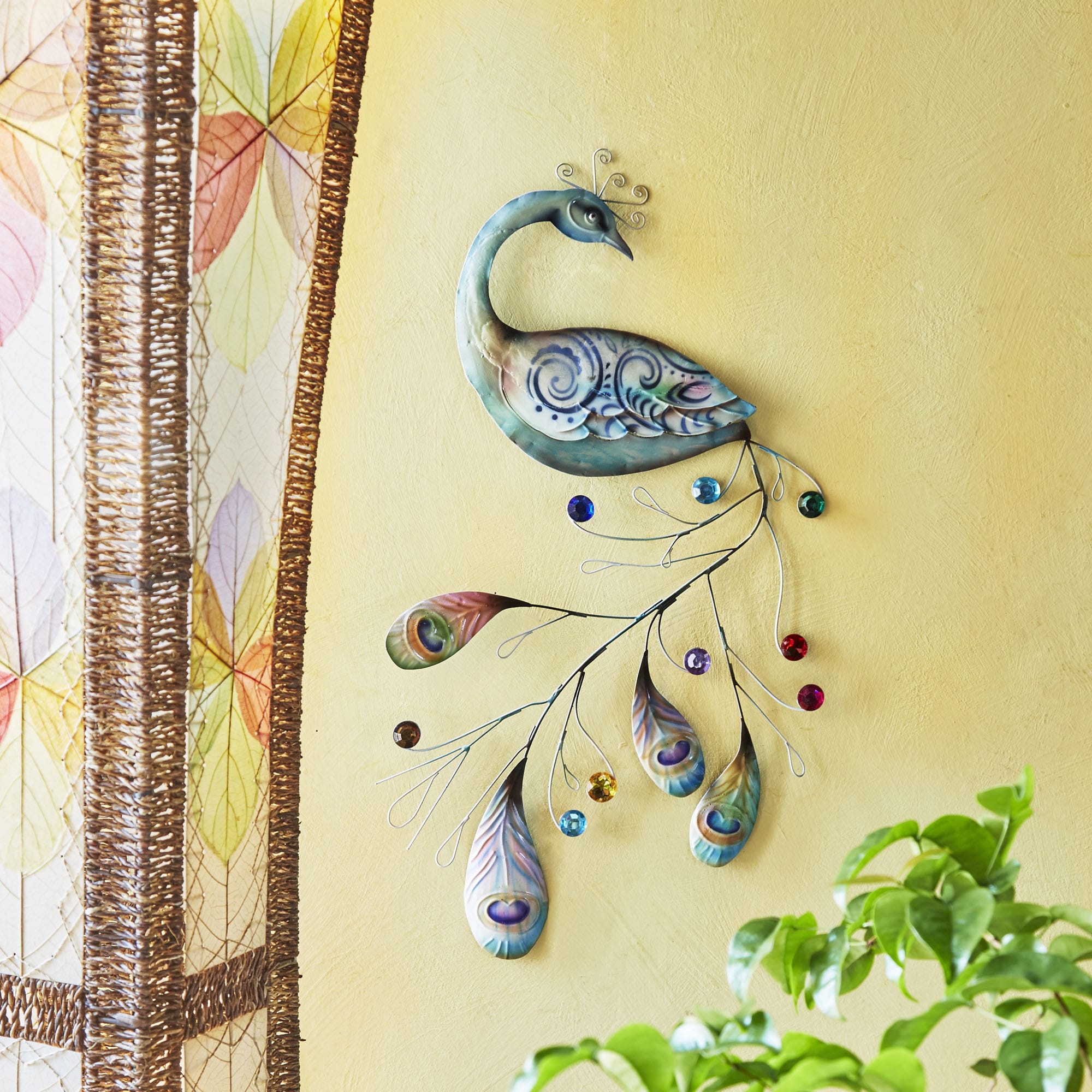
This elegant peacock is relaxed and calm, pluming through its feathers. The gentle hues of its body are enhanced with a pop of color in the jeweled stones in the peacock's tail. The jewels aren't the only representation of the iridescent colors of peacocks. The artist doesn't hesitate to hand-paint the distinctive eyespots, with the eye itself in different colors. This piece comes together and brings a of soothing peace to any space.
The basic frame of the is created using tin, which is powder coated with a black finish. The frame is reinforced using tin wire along the inner edge. Capiz is an oyster shell and the primary purpose of the oyster is as a source of food. However, the by-product, the shell, can be used for decoration. Due to it being a natural material, the natural colors of the capiz come through as tans and browns underneath the paint. The shell is then painted the bold colors you see. The entire front facing piece is carefully hand-painted.
-
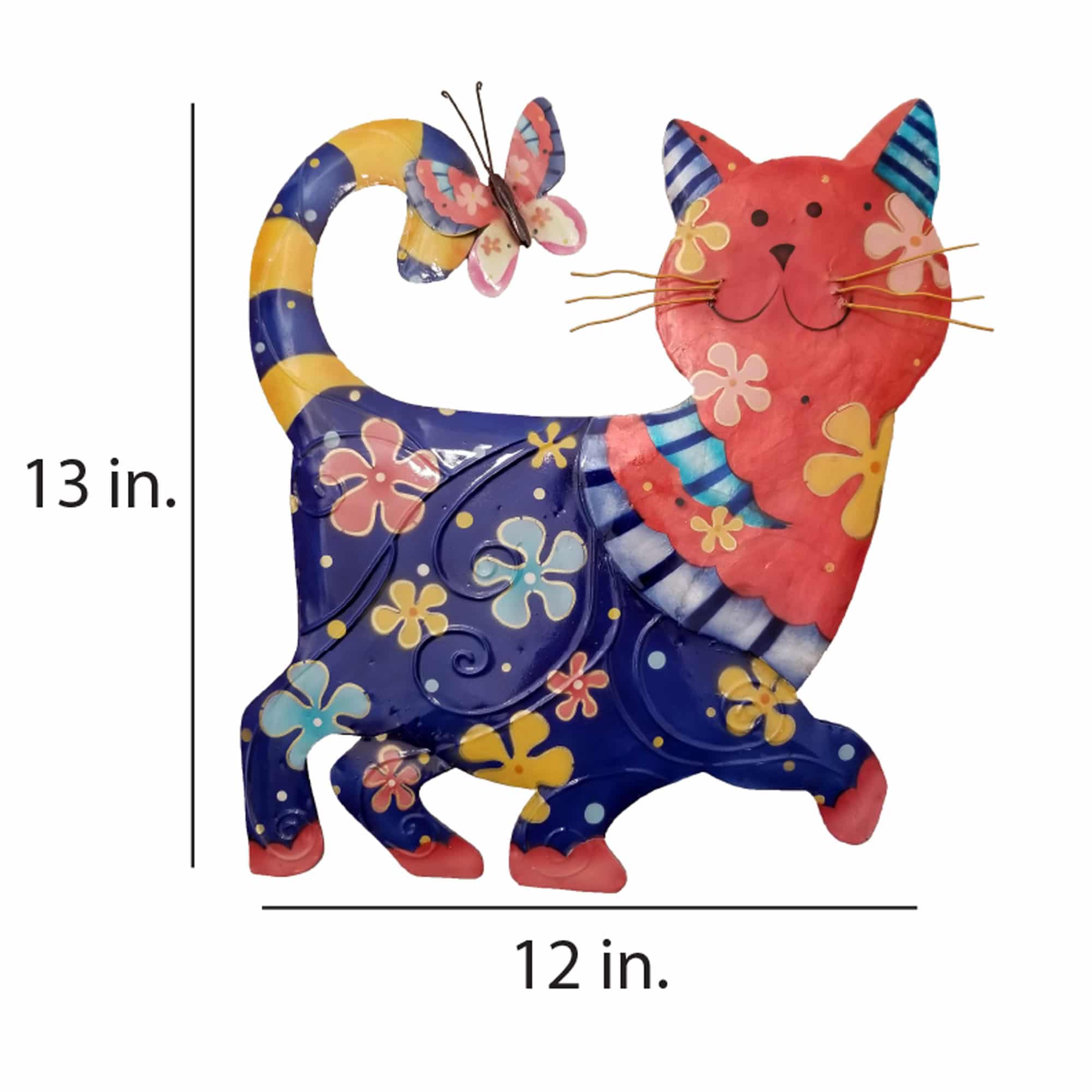
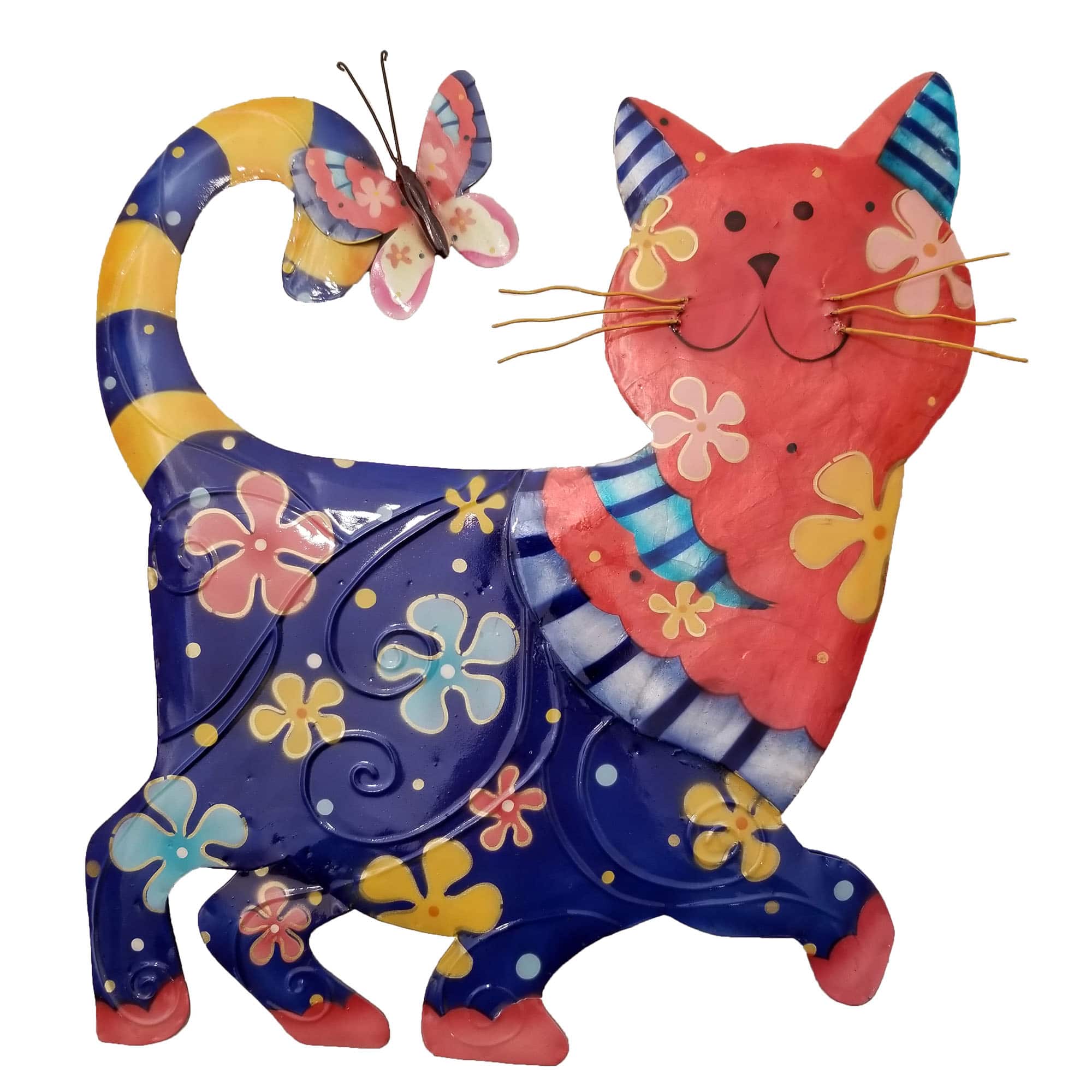 Marching along, this cat is bringing his butterfly buddy along for the ride. Bright reds and blues are highlighted with multi colored flowers. This kitty's face and chest are adorned with mother of pearl capiz shell. The artist then hand-painted flowers on top of the shell. The floral theme continues on the lower half of the body, both in being paint and etching. This piece will bring warmth and happiness to any space. The basic frame of the cat is created using tin, which is powder coated with a black finish. The frame is reinforced using tin wire along the inner edge. Capiz is an oyster shell and the primary purpose of the oyster is as a source of food. However, the by-product, the shell, can be used for decoration. Due to it being a natural material, the natural colors of the capiz come through as tans and browns underneath the paint. The shell is then painted the bold colors you see. The entire front facing piece is carefully hand-painted.
Marching along, this cat is bringing his butterfly buddy along for the ride. Bright reds and blues are highlighted with multi colored flowers. This kitty's face and chest are adorned with mother of pearl capiz shell. The artist then hand-painted flowers on top of the shell. The floral theme continues on the lower half of the body, both in being paint and etching. This piece will bring warmth and happiness to any space. The basic frame of the cat is created using tin, which is powder coated with a black finish. The frame is reinforced using tin wire along the inner edge. Capiz is an oyster shell and the primary purpose of the oyster is as a source of food. However, the by-product, the shell, can be used for decoration. Due to it being a natural material, the natural colors of the capiz come through as tans and browns underneath the paint. The shell is then painted the bold colors you see. The entire front facing piece is carefully hand-painted. -
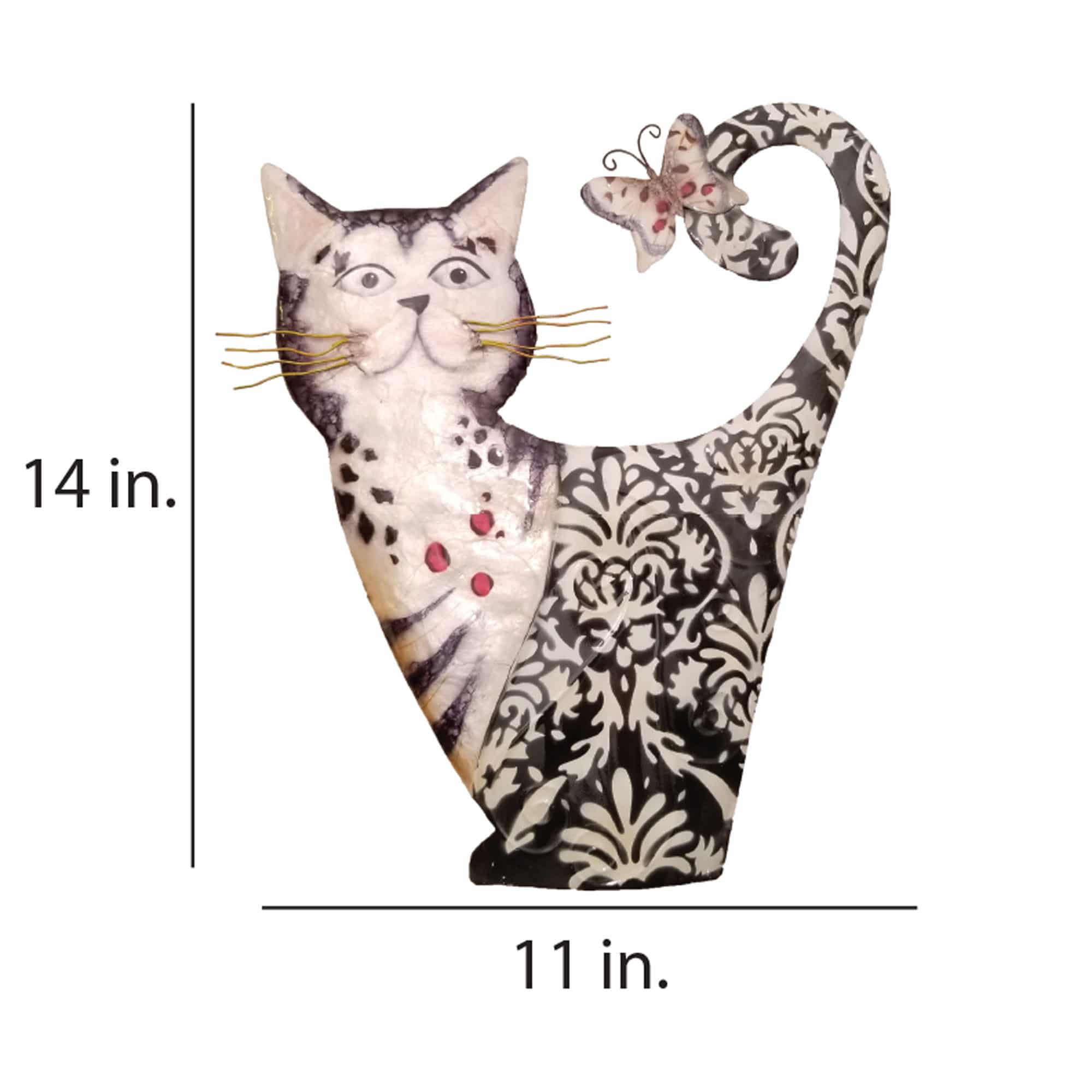
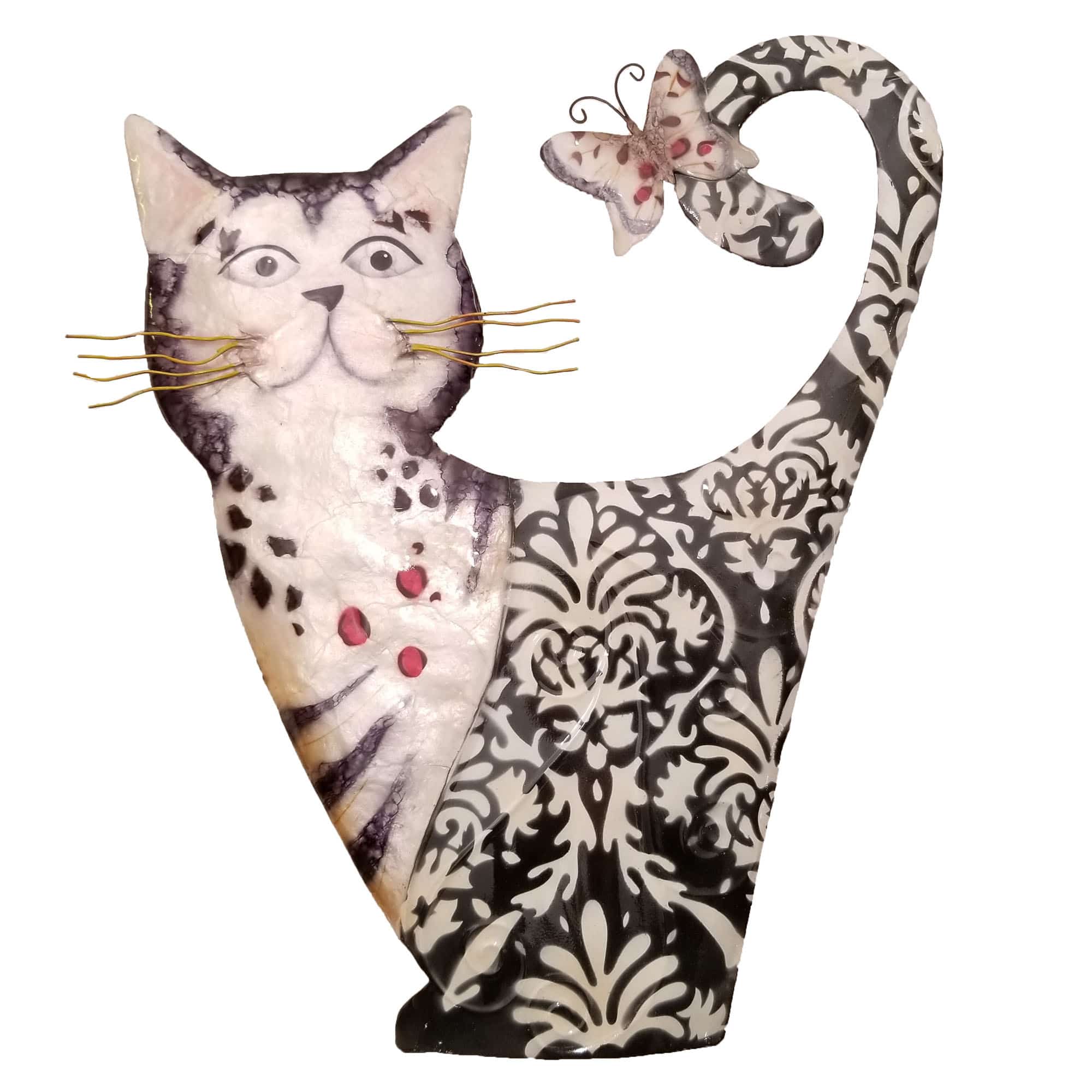 Sitting perched and waiting, this cat is ready pounce. The simple neutral colors contrast with traditional design elements embedded into the background. This kitty's face and chest is adorned with mother of pearl capiz shell. The artist then hand-paints stripes on top of the shell. The butterfly sitting on its tale adds a sense of movement to this piece leading to the bemused smile on the face of the cat. The basic frame of the cat is created using tin, which is powder coated with a black finish. The frame is reinforced using tin wire along the inner edge. Capiz is an oyster shell and the primary purpose of the oyster is as a source of food. However, the by-product, the shell, can be used for decoration. Due to it being a natural material, the natural colors of the capiz come through as tans and browns underneath the paint. The shell is then painted the bold colors you see. The entire front facing piece is carefully hand-painted.
Sitting perched and waiting, this cat is ready pounce. The simple neutral colors contrast with traditional design elements embedded into the background. This kitty's face and chest is adorned with mother of pearl capiz shell. The artist then hand-paints stripes on top of the shell. The butterfly sitting on its tale adds a sense of movement to this piece leading to the bemused smile on the face of the cat. The basic frame of the cat is created using tin, which is powder coated with a black finish. The frame is reinforced using tin wire along the inner edge. Capiz is an oyster shell and the primary purpose of the oyster is as a source of food. However, the by-product, the shell, can be used for decoration. Due to it being a natural material, the natural colors of the capiz come through as tans and browns underneath the paint. The shell is then painted the bold colors you see. The entire front facing piece is carefully hand-painted. -
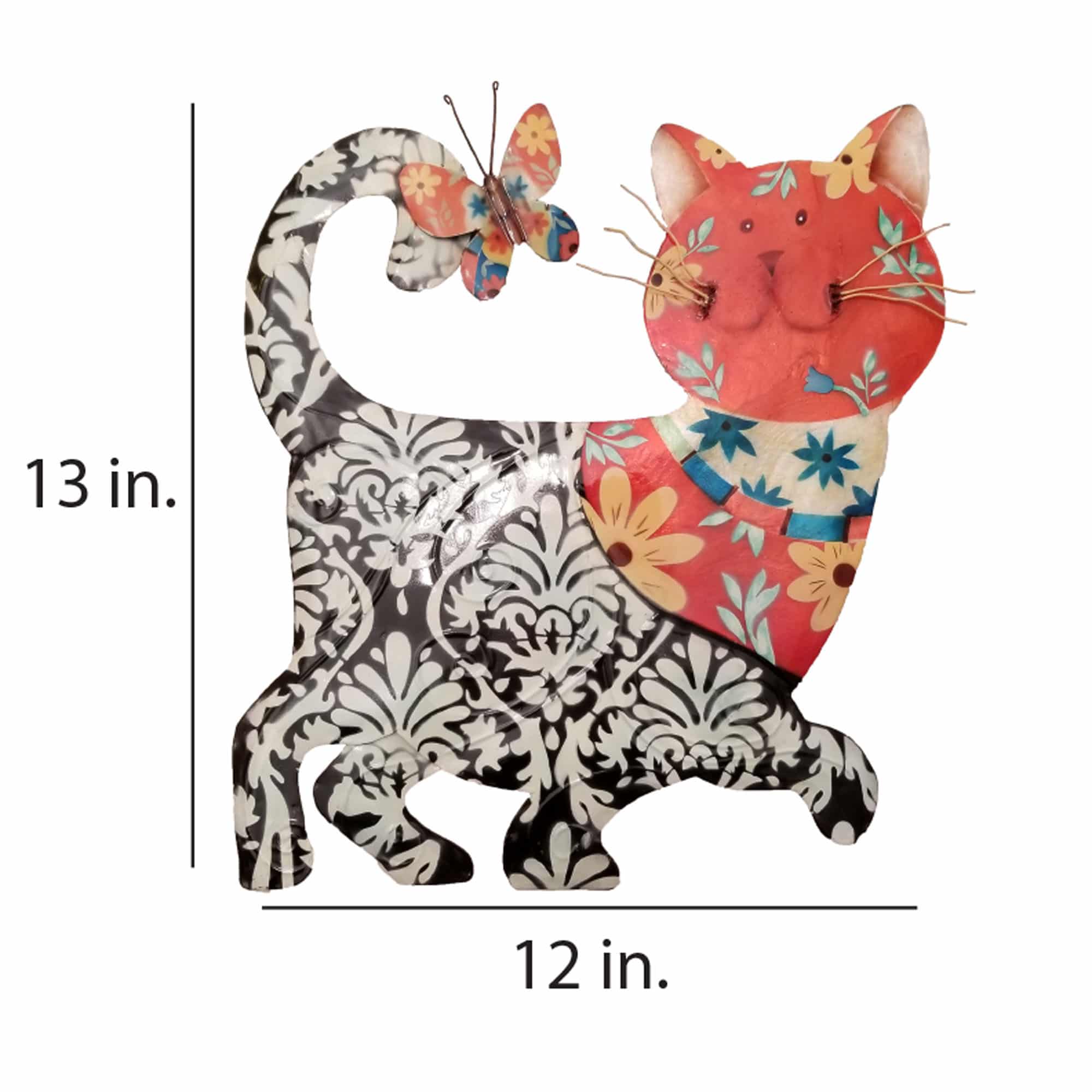
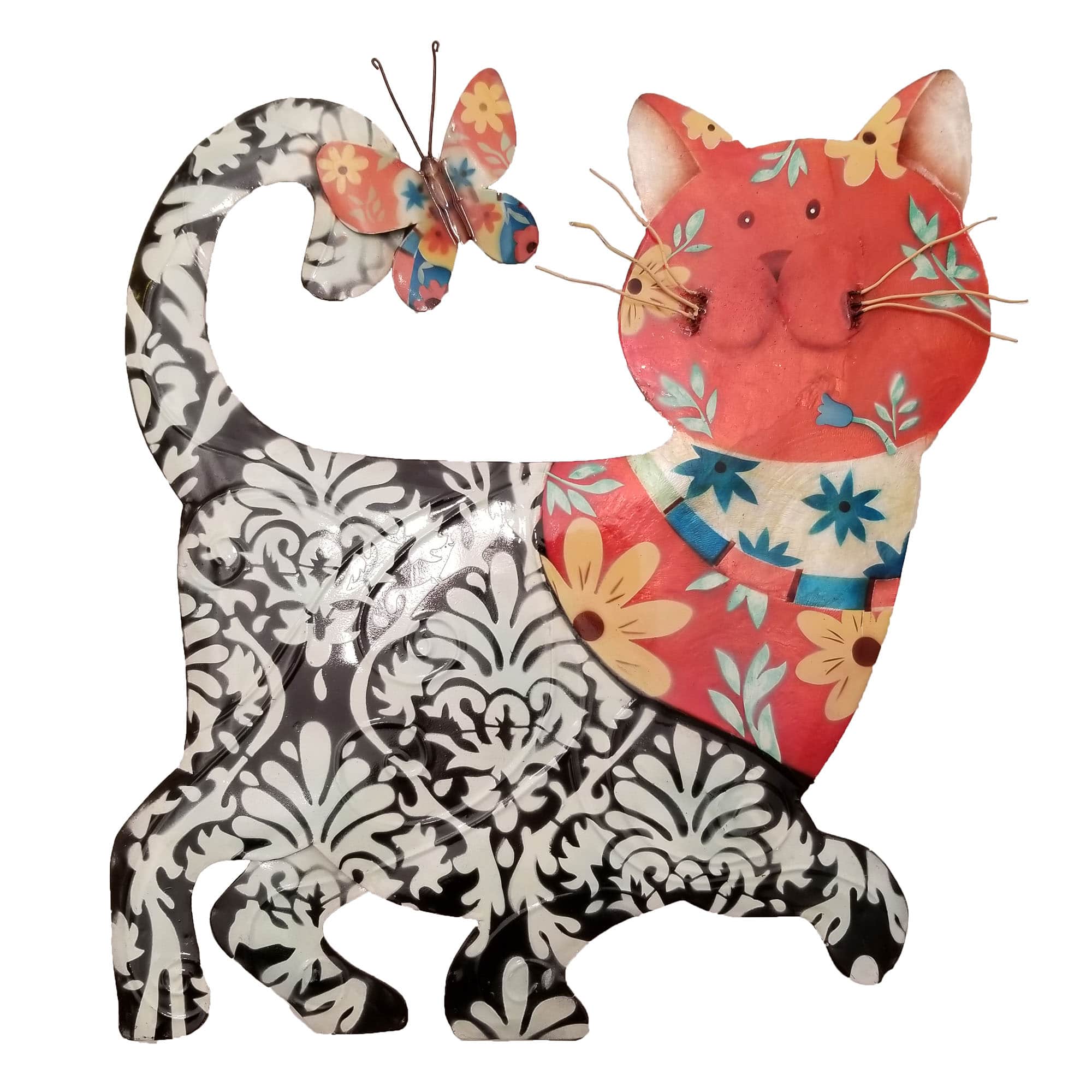 With a look of playful satisfaction on its face, this kitty is ready to warm up any space. This kitty's face and chest is adorned with mother of pearl capiz shell. The artist then hand-painted floral patterns on the shell. The body is marked with traditional forms, while the bright colors and whimsy and fun. The basic frame of the cat is created using tin, which is powder coated with a black finish. The frame is reinforced using tin wire along the inner edge. Capiz is an oyster shell and the primary purpose of the oyster is as a source of food. However, the by-product, the shell, can be used for decoration. Due to it being a natural material, the natural colors of the capiz come through as tans and browns underneath the paint. The shell is then painted the bold colors you see. The entire front facing piece is carefully hand-painted.
With a look of playful satisfaction on its face, this kitty is ready to warm up any space. This kitty's face and chest is adorned with mother of pearl capiz shell. The artist then hand-painted floral patterns on the shell. The body is marked with traditional forms, while the bright colors and whimsy and fun. The basic frame of the cat is created using tin, which is powder coated with a black finish. The frame is reinforced using tin wire along the inner edge. Capiz is an oyster shell and the primary purpose of the oyster is as a source of food. However, the by-product, the shell, can be used for decoration. Due to it being a natural material, the natural colors of the capiz come through as tans and browns underneath the paint. The shell is then painted the bold colors you see. The entire front facing piece is carefully hand-painted. -
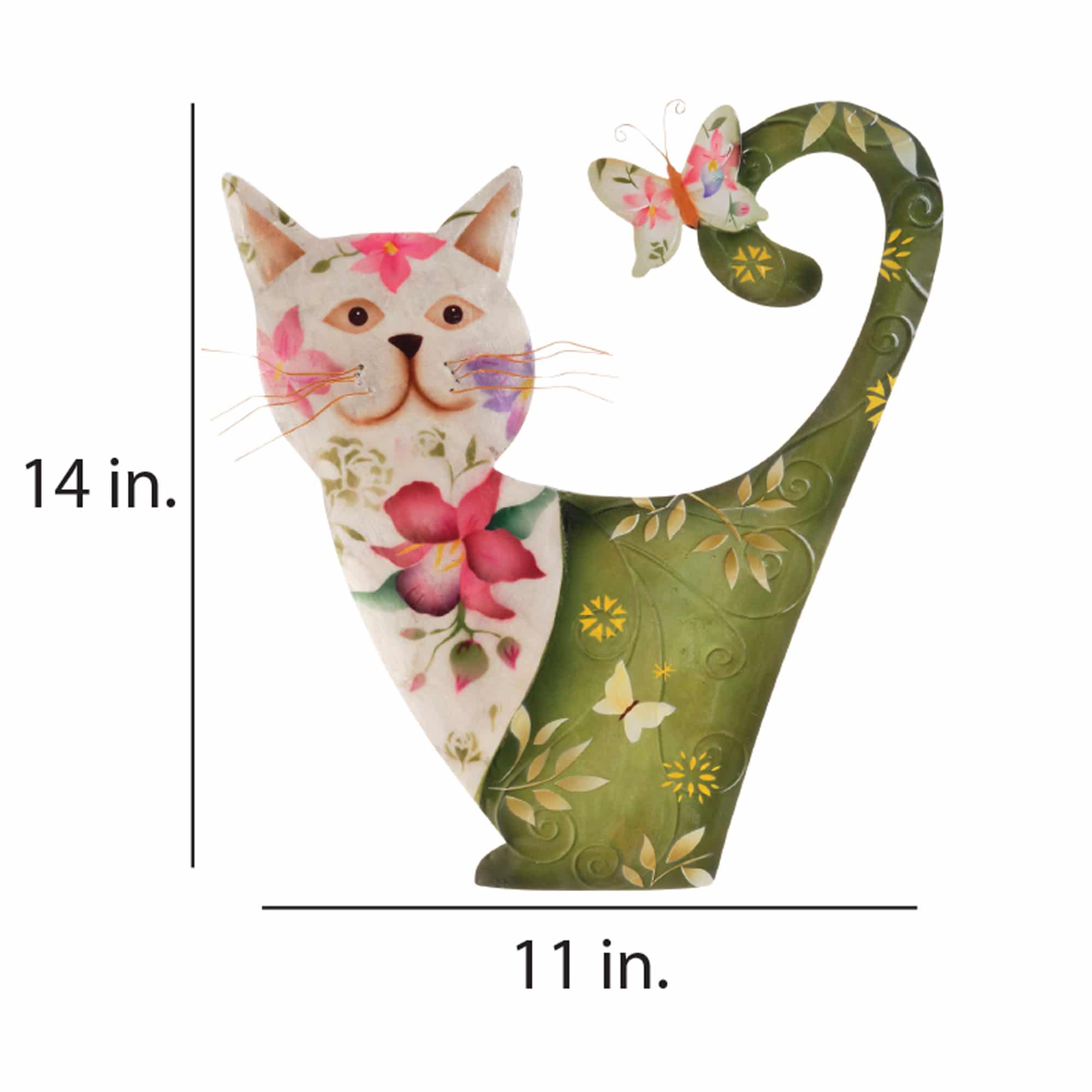
 From the smile on its face to the butterfly resting on its tail, this happy cat brings warmth and joy. This kitty's face and chest is adorned with mother of pearl capiz shell. The artist then hand-painted flowers on top of the shell. The floral theme continues on the lower half of the body, both in being painted on and being pressed into the tin. The contrasting pearl and green ensures this piece fits in nearly any decor style. The basic frame of the cat is created using tin, which is powder coated with a black finish. The frame is reinforced using tin wire along the inner edge. Capiz is an oyster shell and the primary purpose of the oyster is as a source of food. However, the by-product, the shell, can be used for decoration. Due to it being a natural material, the natural colors of the capiz come through as tans and browns underneath the paint. The shell is then painted the bold colors you see. The entire front facing piece is carefully hand-painted.
From the smile on its face to the butterfly resting on its tail, this happy cat brings warmth and joy. This kitty's face and chest is adorned with mother of pearl capiz shell. The artist then hand-painted flowers on top of the shell. The floral theme continues on the lower half of the body, both in being painted on and being pressed into the tin. The contrasting pearl and green ensures this piece fits in nearly any decor style. The basic frame of the cat is created using tin, which is powder coated with a black finish. The frame is reinforced using tin wire along the inner edge. Capiz is an oyster shell and the primary purpose of the oyster is as a source of food. However, the by-product, the shell, can be used for decoration. Due to it being a natural material, the natural colors of the capiz come through as tans and browns underneath the paint. The shell is then painted the bold colors you see. The entire front facing piece is carefully hand-painted. -

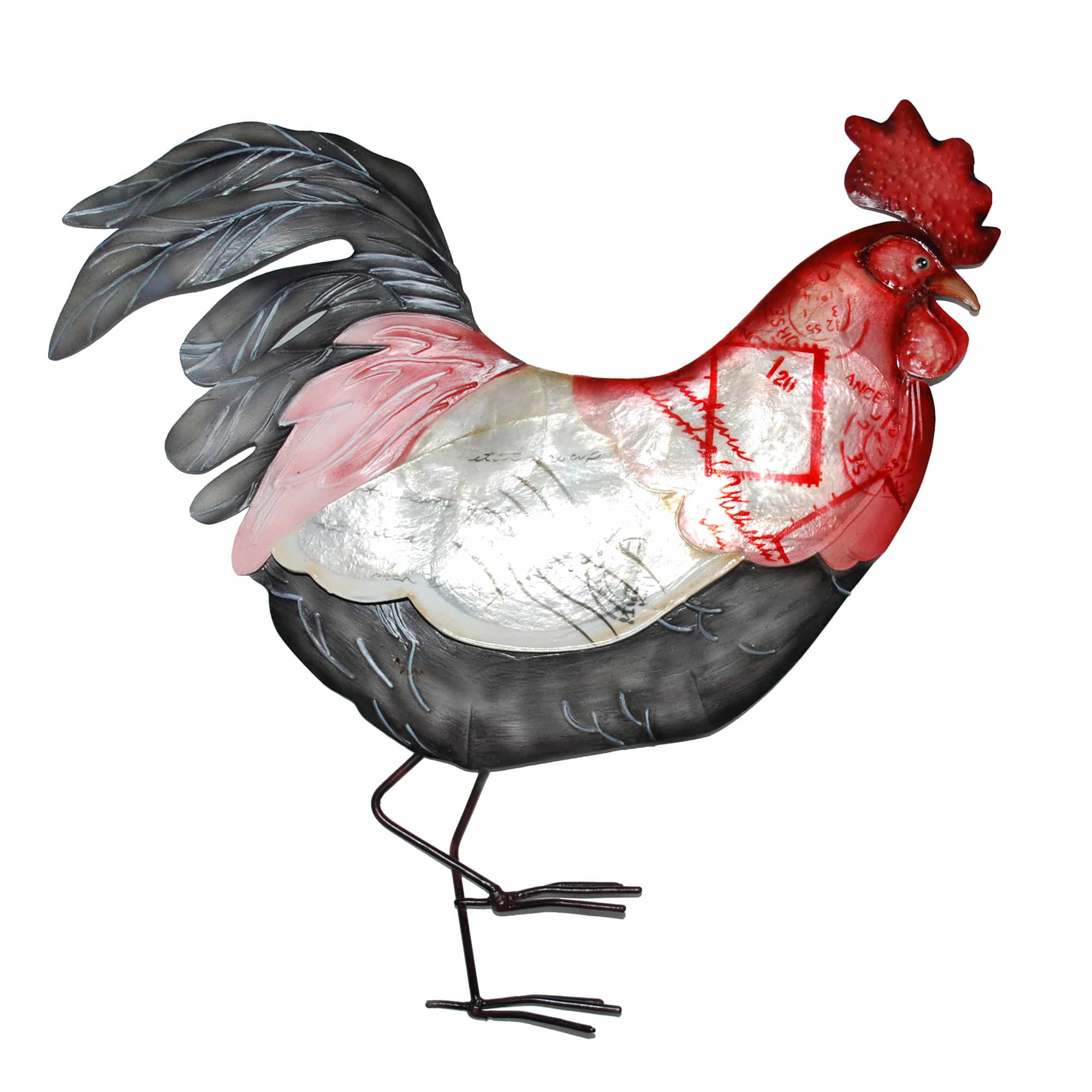 This vintage designed rooster is influenced by the designs of the early 20th century. The artist took great care in making sure the rooster's comb and wattle appear authentic by pressing texture into the metal frame. Furthermore, the artist made sure to use realistic colors and shading. Even the body and the tail feathers were pressed and cut to mimic the body of a real rooster. However, the center of the rooster deviates from the realism and merges into the nostalgic with what appears to be an envelope of an old handwritten letter. The capiz oyster shell gives an aged patina making the rooster and the letter feel like it has been around for a very long time. The letter is an artistic way of tying in a piece of the old into the new. The basic frame of this piece is created using tin, which is powder coated with a black finish. The frame is reinforced using tin wire along the inner edge. The front of the body is adorned with capiz. Capiz is an oyster shell and the primary purpose of the oyster is as a source of food. However, the by-product, the shell, can be used for decoration. Due to it being a natural material, the natural colors of the capiz may come through as tans and browns underneath the hand-painted surface.
This vintage designed rooster is influenced by the designs of the early 20th century. The artist took great care in making sure the rooster's comb and wattle appear authentic by pressing texture into the metal frame. Furthermore, the artist made sure to use realistic colors and shading. Even the body and the tail feathers were pressed and cut to mimic the body of a real rooster. However, the center of the rooster deviates from the realism and merges into the nostalgic with what appears to be an envelope of an old handwritten letter. The capiz oyster shell gives an aged patina making the rooster and the letter feel like it has been around for a very long time. The letter is an artistic way of tying in a piece of the old into the new. The basic frame of this piece is created using tin, which is powder coated with a black finish. The frame is reinforced using tin wire along the inner edge. The front of the body is adorned with capiz. Capiz is an oyster shell and the primary purpose of the oyster is as a source of food. However, the by-product, the shell, can be used for decoration. Due to it being a natural material, the natural colors of the capiz may come through as tans and browns underneath the hand-painted surface. -

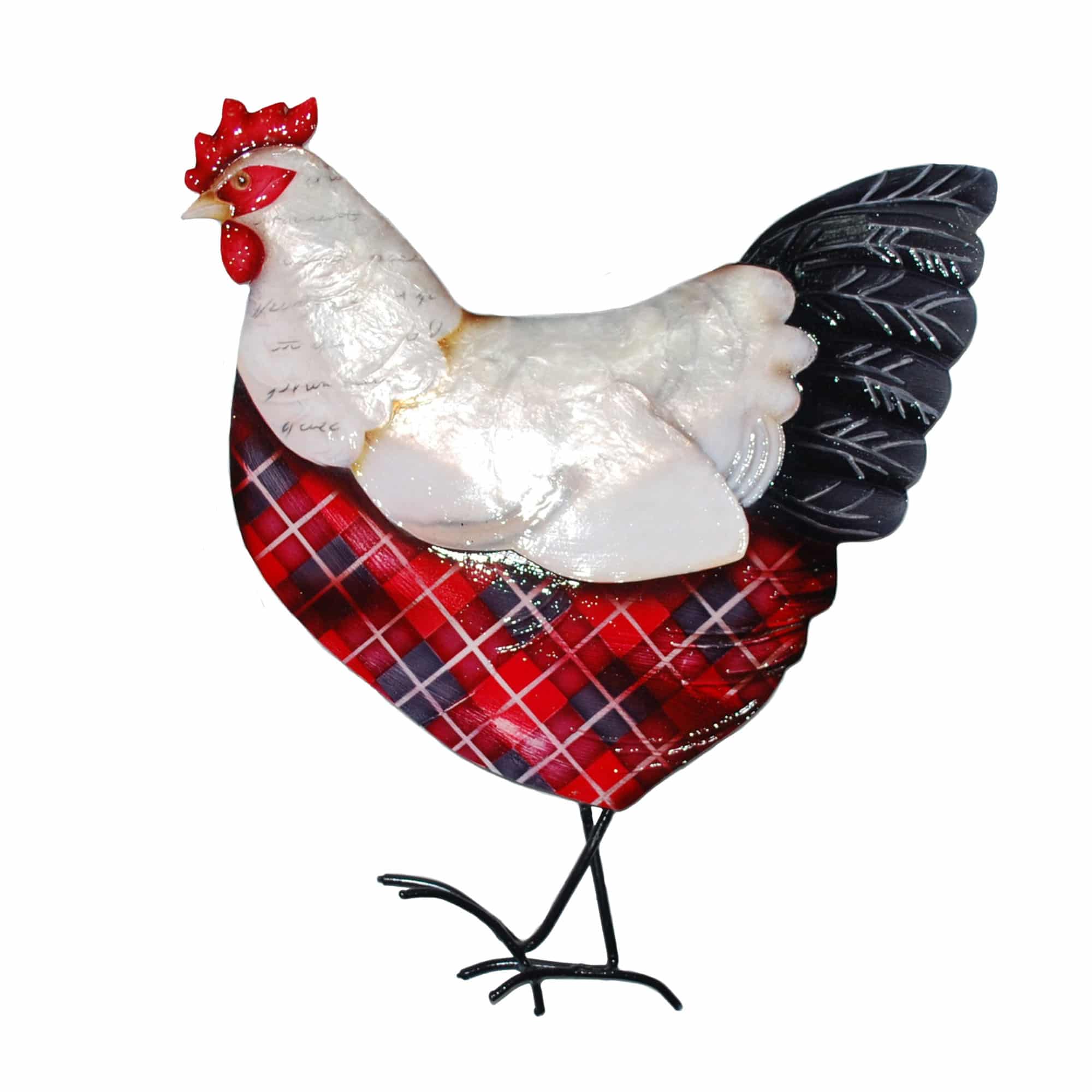 Farm animals are a common theme in the modern farmhouse design with plaid often used as an accent. Featuring modern farmhouse themes, this chicken is both classic and fun in the way the basic colors are portrayed on the familiar design shape. The mother of pearl oyster shell gives the piece an aged patina Modern farmhouse themes also about bringing the old back to new. As an added detail, the neck of the chicken features an excerpt of an old handwritten letter. The basic frame of this piece is created using tin, which is powder coated with a black finish. The frame is reinforced using tin wire along the inner edge. The front of the body is adorned with capiz. Capiz is an oyster shell and the primary purpose of the oyster is as a source of food. However, the by-product, the shell, can be used for decoration. Due to it being a natural material, the natural colors of the capiz may come through as tans and browns underneath the hand-painted surface.
Farm animals are a common theme in the modern farmhouse design with plaid often used as an accent. Featuring modern farmhouse themes, this chicken is both classic and fun in the way the basic colors are portrayed on the familiar design shape. The mother of pearl oyster shell gives the piece an aged patina Modern farmhouse themes also about bringing the old back to new. As an added detail, the neck of the chicken features an excerpt of an old handwritten letter. The basic frame of this piece is created using tin, which is powder coated with a black finish. The frame is reinforced using tin wire along the inner edge. The front of the body is adorned with capiz. Capiz is an oyster shell and the primary purpose of the oyster is as a source of food. However, the by-product, the shell, can be used for decoration. Due to it being a natural material, the natural colors of the capiz may come through as tans and browns underneath the hand-painted surface. -
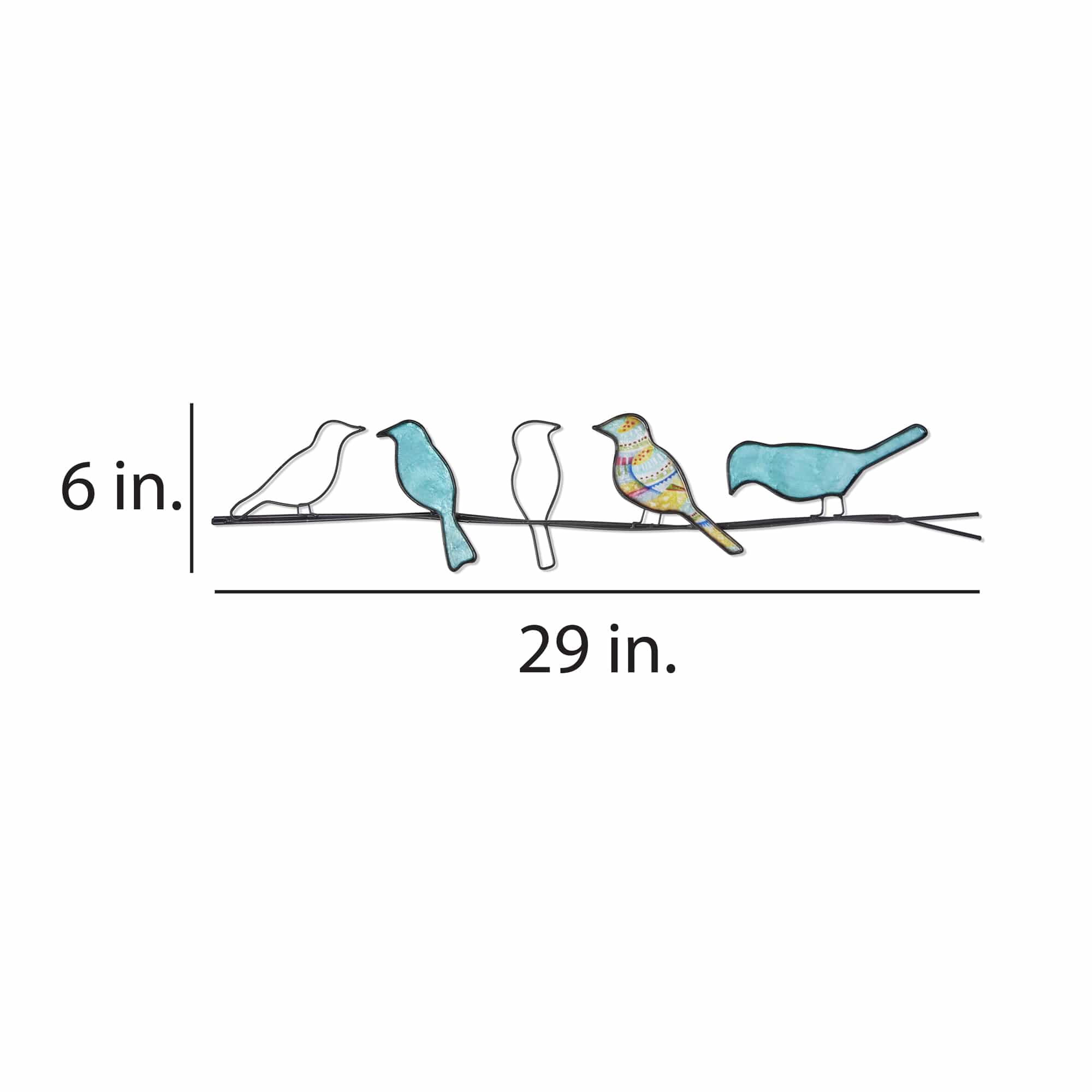
 An old parable states that five birds were resting on a wire. Two decided to fly south. How many were birds are left? One's initial answer may be three, however, the answer is still five. The moral of the fable is actions are more important than intention; a kind reminder that a truer picture of one's character is drawn by actions. The artisan captures this parable by lining up five birds socializing on a wire. The basic frame of this piece is created using tin, which is powder coated with a black finish. The frame is reinforced using tin wire along the inner edge. The front of the body is adorned with capiz. Capiz is an oyster shell and the primary purpose of the oyster is as a source of food. However, the by-product, the shell, can be used for decoration. Due to it being a natural material, the natural colors of the capiz may come through as tans and browns underneath the hand-painted surface.
An old parable states that five birds were resting on a wire. Two decided to fly south. How many were birds are left? One's initial answer may be three, however, the answer is still five. The moral of the fable is actions are more important than intention; a kind reminder that a truer picture of one's character is drawn by actions. The artisan captures this parable by lining up five birds socializing on a wire. The basic frame of this piece is created using tin, which is powder coated with a black finish. The frame is reinforced using tin wire along the inner edge. The front of the body is adorned with capiz. Capiz is an oyster shell and the primary purpose of the oyster is as a source of food. However, the by-product, the shell, can be used for decoration. Due to it being a natural material, the natural colors of the capiz may come through as tans and browns underneath the hand-painted surface. -
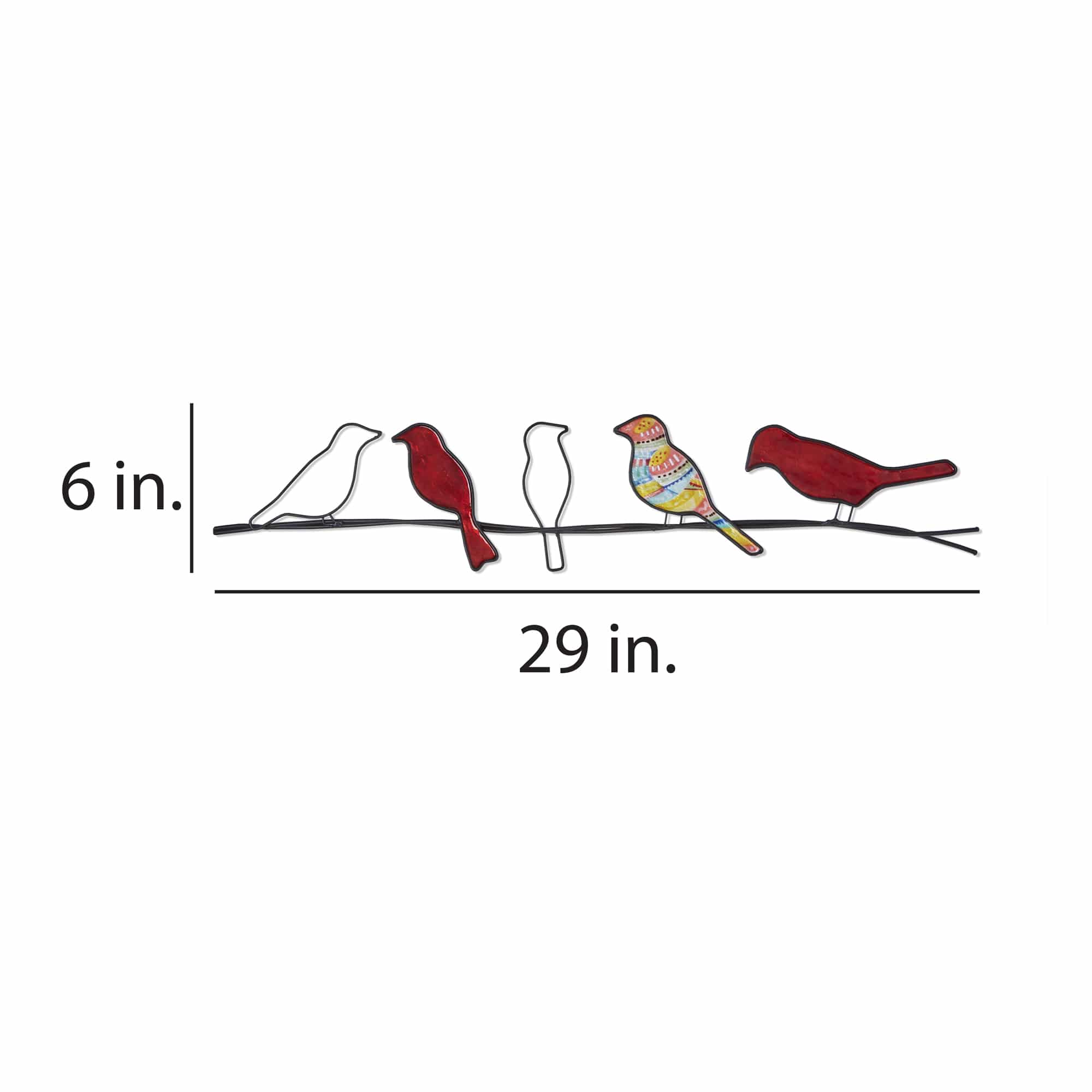
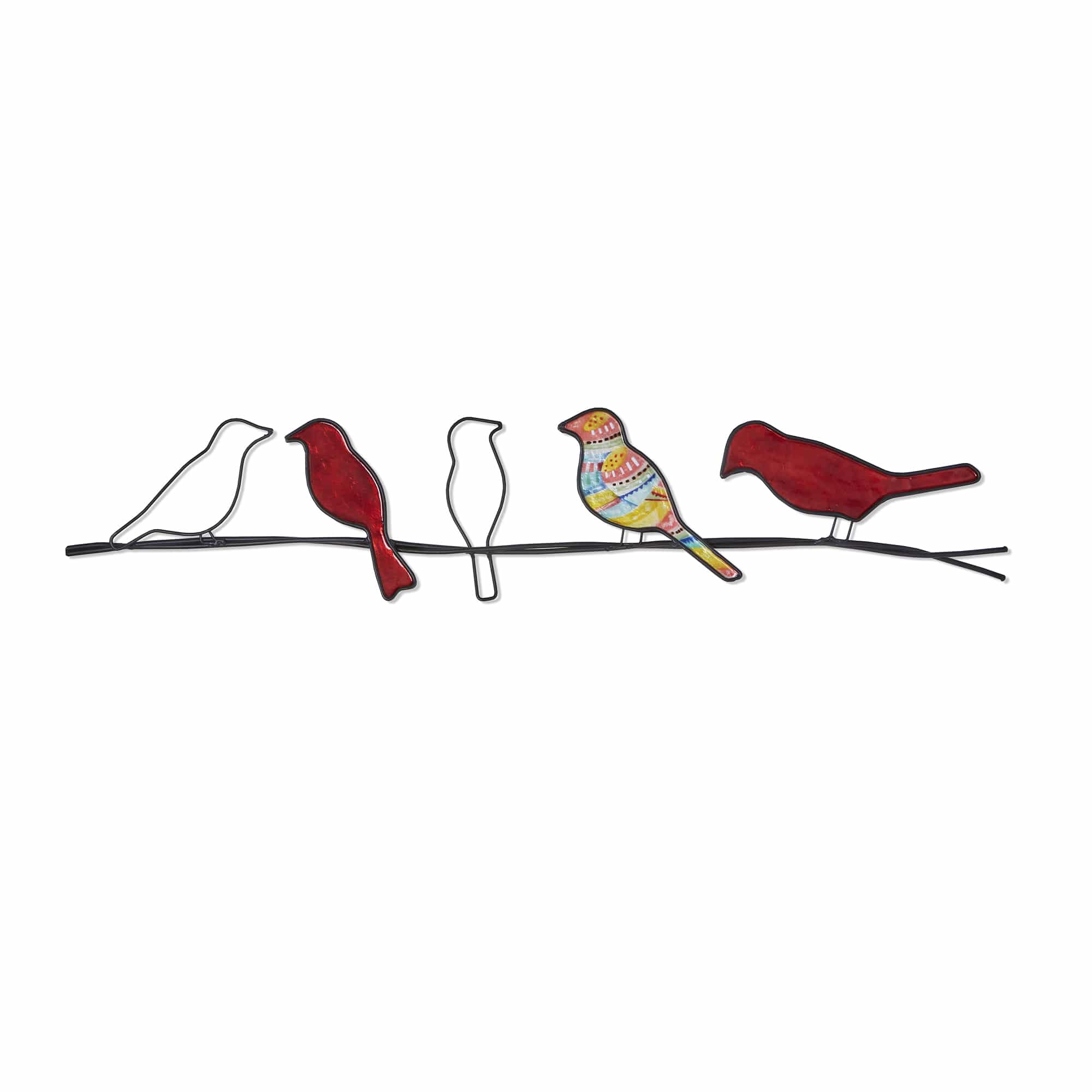 An old parable states that five birds were resting on a wire. Two decided to fly south. How many were birds are left? One's initial answer may be three, however, the answer is still five. The moral of the fable is actions are more important than intention; a kind reminder that a truer picture of one's character is drawn by actions. The artisan captures this parable by lining up five birds socializing on a wire. The basic frame of this piece is created using tin, which is powder coated with a black finish. The frame is reinforced using tin wire along the inner edge. The front of the body is adorned with capiz. Capiz is an oyster shell and the primary purpose of the oyster is as a source of food. However, the by-product, the shell, can be used for decoration. Due to it being a natural material, the natural colors of the capiz may come through as tans and browns underneath the hand-painted surface.
An old parable states that five birds were resting on a wire. Two decided to fly south. How many were birds are left? One's initial answer may be three, however, the answer is still five. The moral of the fable is actions are more important than intention; a kind reminder that a truer picture of one's character is drawn by actions. The artisan captures this parable by lining up five birds socializing on a wire. The basic frame of this piece is created using tin, which is powder coated with a black finish. The frame is reinforced using tin wire along the inner edge. The front of the body is adorned with capiz. Capiz is an oyster shell and the primary purpose of the oyster is as a source of food. However, the by-product, the shell, can be used for decoration. Due to it being a natural material, the natural colors of the capiz may come through as tans and browns underneath the hand-painted surface. -
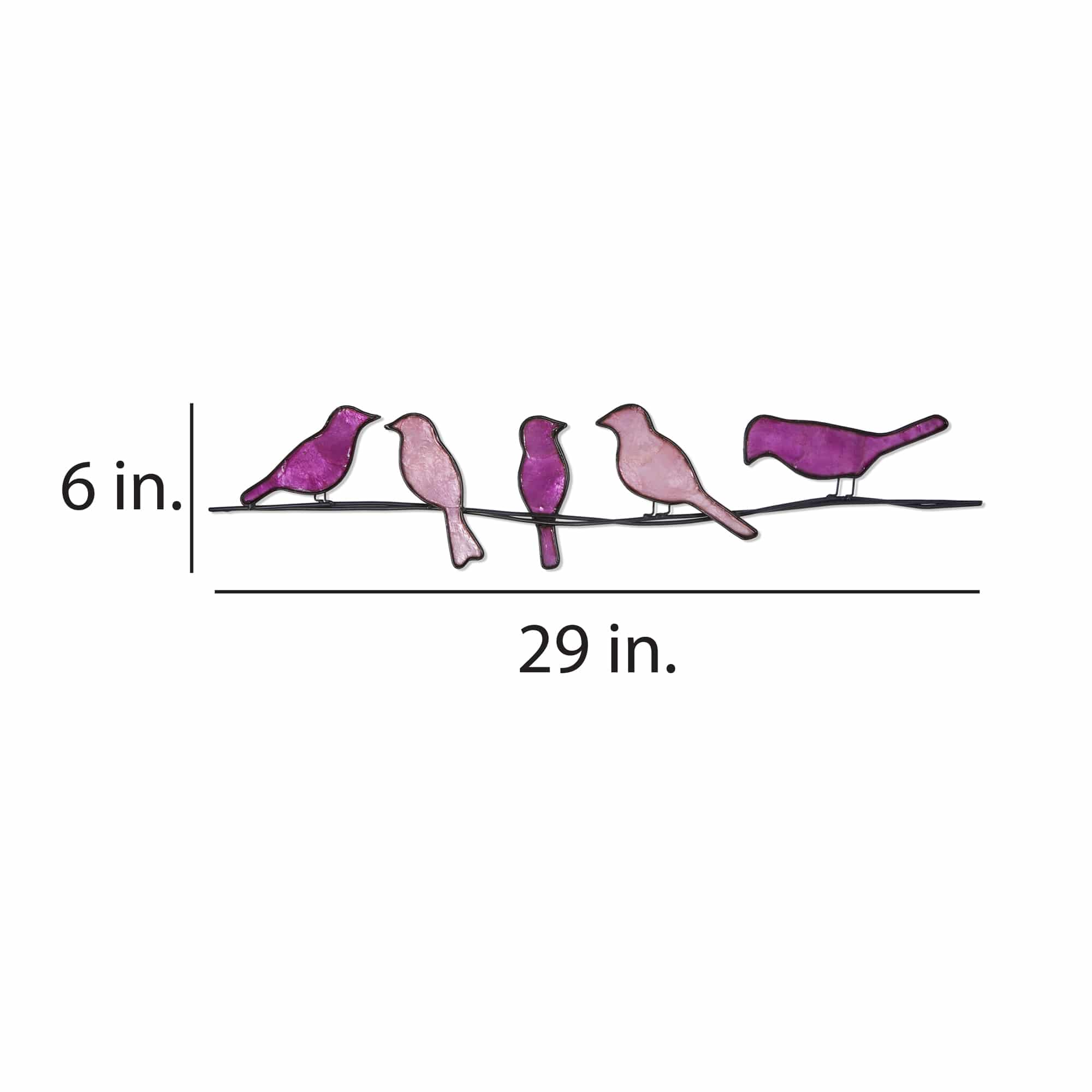
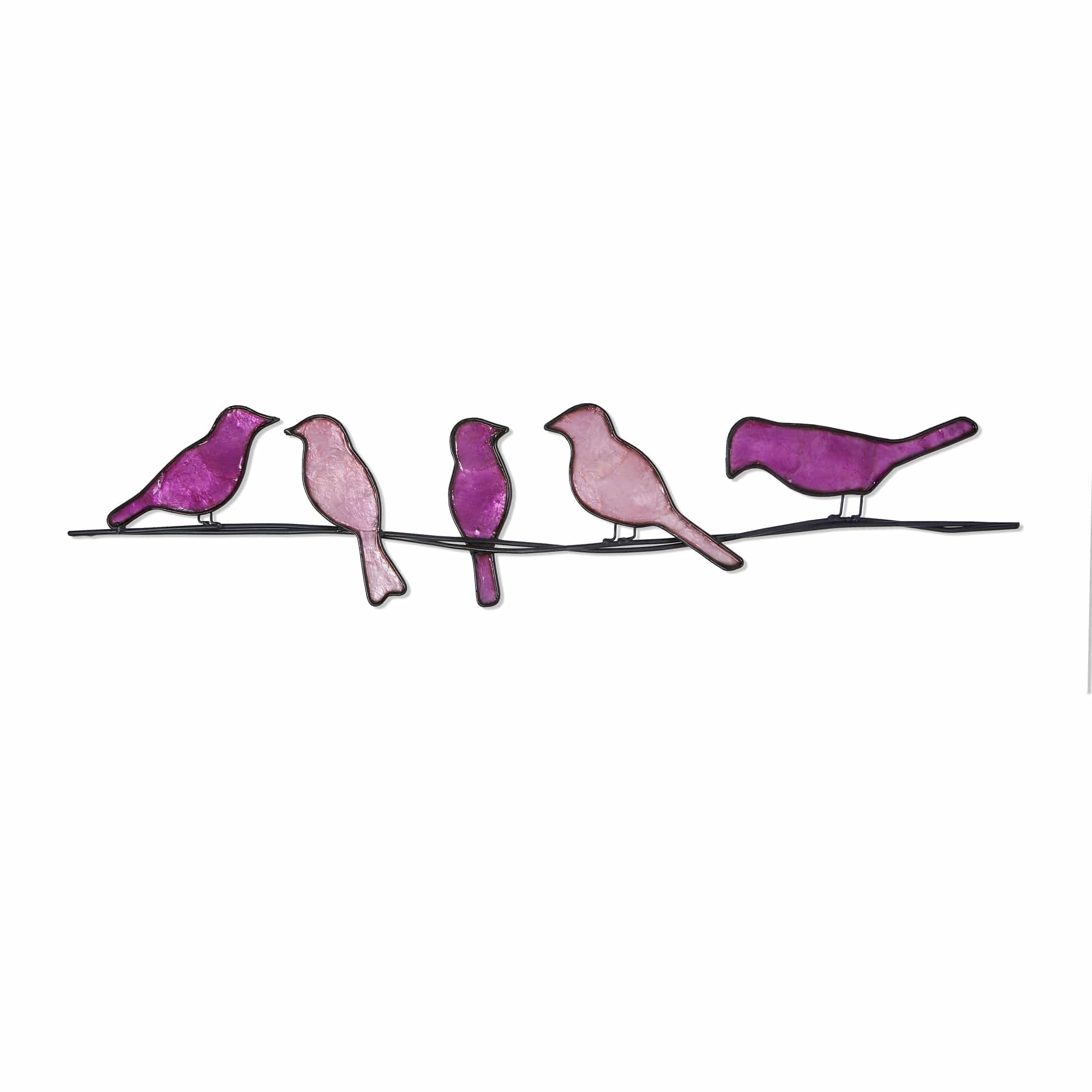 An old parable states that five birds were resting on a wire. Two decided to fly south. How many were birds are left? One's initial answer may be three, however, the answer is still five. The moral of the fable is actions are more important than intention; a kind reminder that a truer picture of one's character is drawn by actions. The artisan captures this parable by lining up five birds socializing on a wire. The basic frame of this piece is created using tin, which is powder coated with a black finish. The frame is reinforced using tin wire along the inner edge. The front of the body is adorned with capiz. Capiz is an oyster shell and the primary purpose of the oyster is as a source of food. However, the by-product, the shell, can be used for decoration. Due to it being a natural material, the natural colors of the capiz may come through as tans and browns underneath the hand-painted surface.
An old parable states that five birds were resting on a wire. Two decided to fly south. How many were birds are left? One's initial answer may be three, however, the answer is still five. The moral of the fable is actions are more important than intention; a kind reminder that a truer picture of one's character is drawn by actions. The artisan captures this parable by lining up five birds socializing on a wire. The basic frame of this piece is created using tin, which is powder coated with a black finish. The frame is reinforced using tin wire along the inner edge. The front of the body is adorned with capiz. Capiz is an oyster shell and the primary purpose of the oyster is as a source of food. However, the by-product, the shell, can be used for decoration. Due to it being a natural material, the natural colors of the capiz may come through as tans and browns underneath the hand-painted surface. -
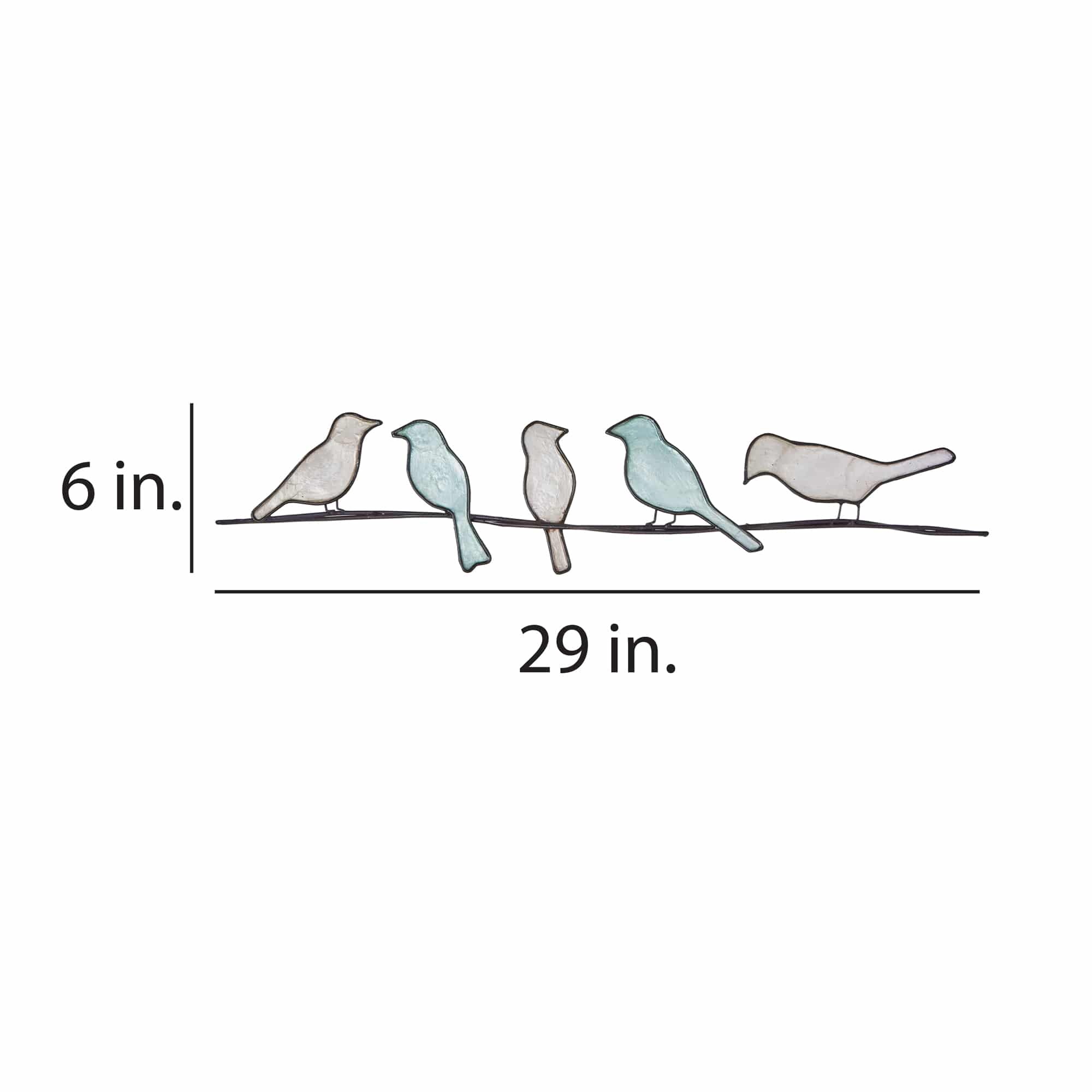
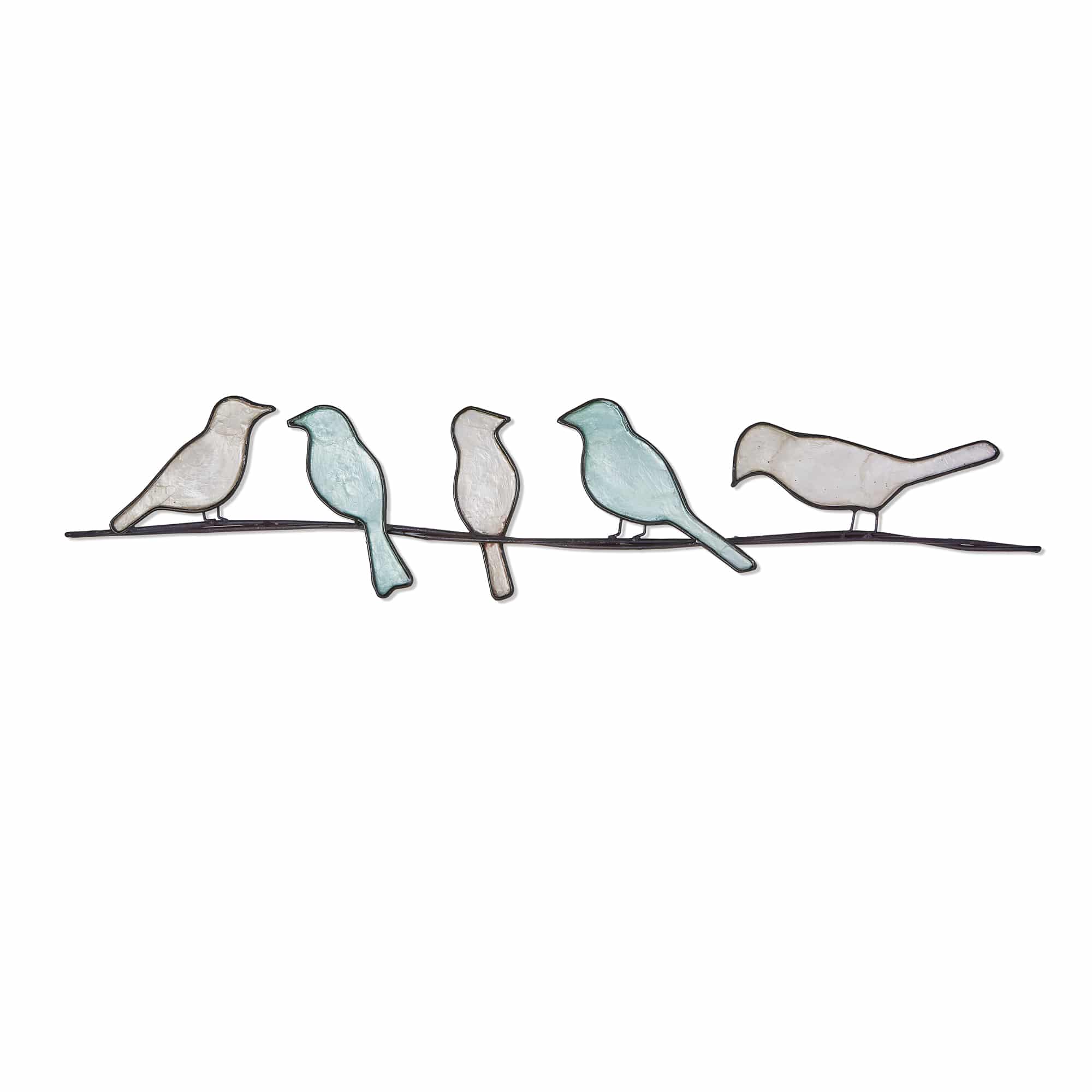 An old parable states that five birds were resting on a wire. Two decided to fly south. How many were birds are left? One's initial answer may be three, however, the answer is still five. The moral of the fable is actions are more important than intention; a kind reminder that a truer picture of one's character is drawn by actions. The artisan captures this parable by lining up five birds socializing on a wire. The basic frame of this piece is created using tin, which is powder coated with a black finish. The frame is reinforced using tin wire along the inner edge. The front of the body is adorned with capiz. Capiz is an oyster shell and the primary purpose of the oyster is as a source of food. However, the by-product, the shell, can be used for decoration. Due to it being a natural material, the natural colors of the capiz may come through as tans and browns underneath the hand-painted surface.
An old parable states that five birds were resting on a wire. Two decided to fly south. How many were birds are left? One's initial answer may be three, however, the answer is still five. The moral of the fable is actions are more important than intention; a kind reminder that a truer picture of one's character is drawn by actions. The artisan captures this parable by lining up five birds socializing on a wire. The basic frame of this piece is created using tin, which is powder coated with a black finish. The frame is reinforced using tin wire along the inner edge. The front of the body is adorned with capiz. Capiz is an oyster shell and the primary purpose of the oyster is as a source of food. However, the by-product, the shell, can be used for decoration. Due to it being a natural material, the natural colors of the capiz may come through as tans and browns underneath the hand-painted surface. -
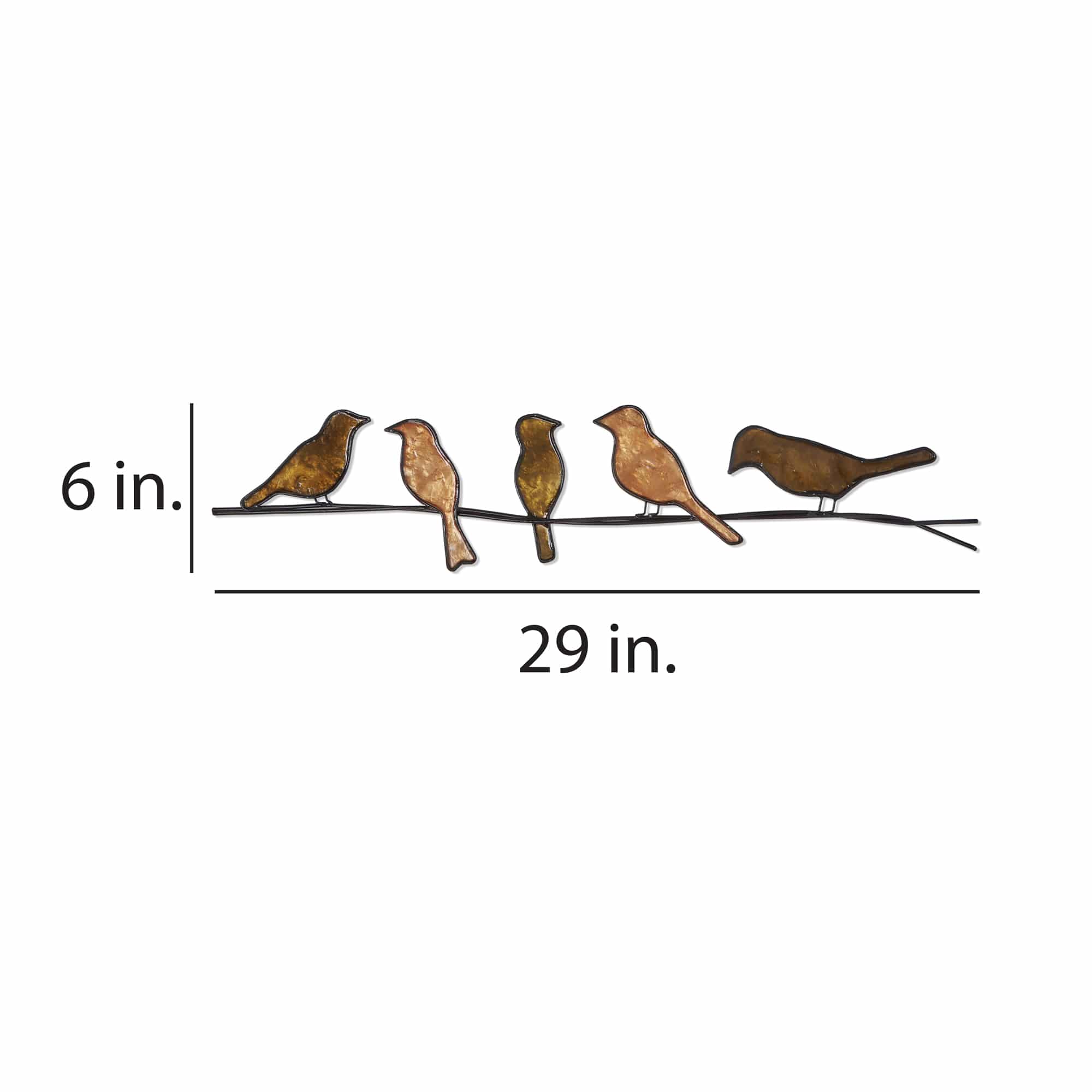
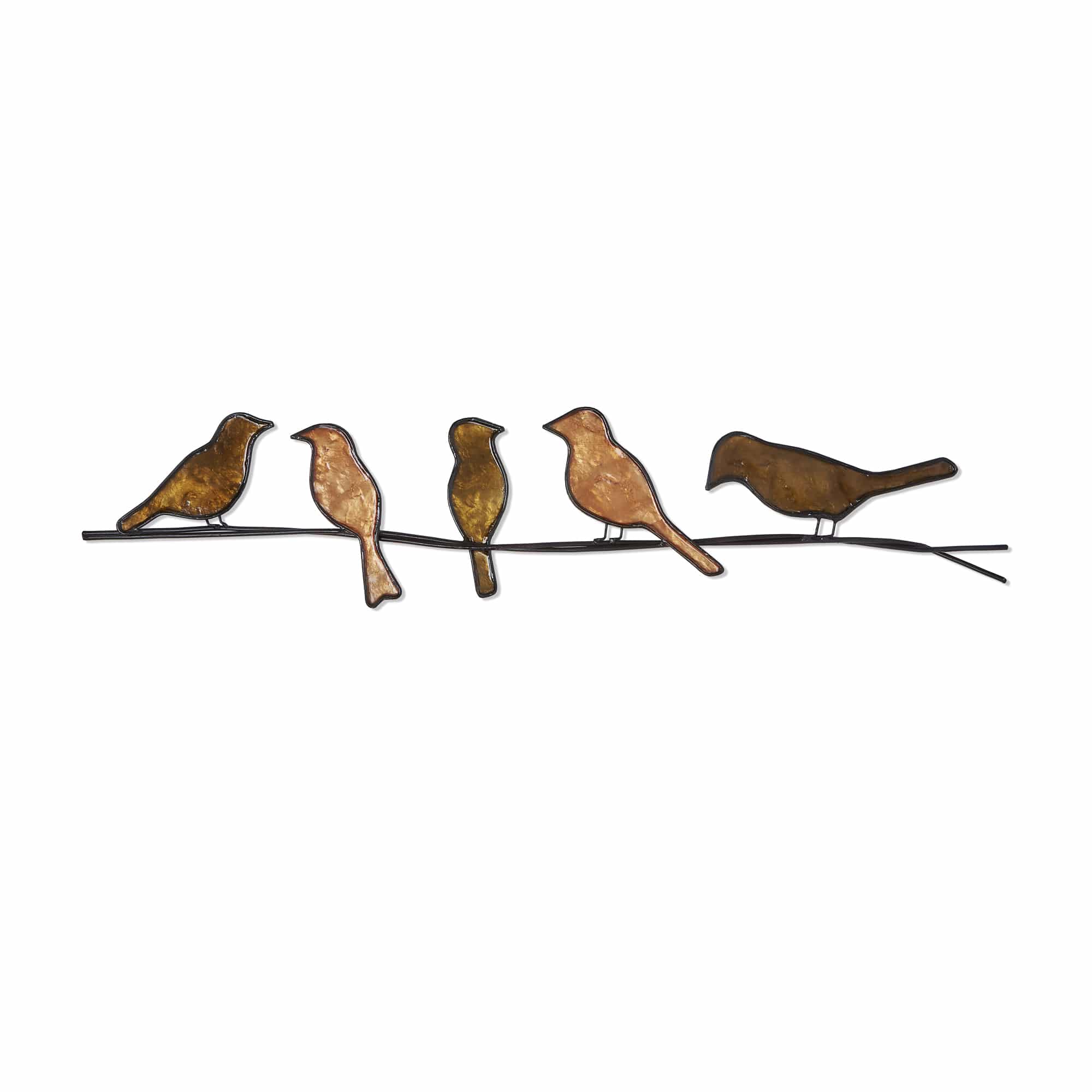 An old parable states that five birds were resting on a wire. Two decided to fly south. How many were birds are left? One's initial answer may be three, however, the answer is still five. The moral of the fable is actions are more important than intention; a kind reminder that a truer picture of one's character is drawn by actions. The artisan captures this parable by lining up five birds socializing on a wire. The basic frame of this piece is created using tin, which is powder coated with a black finish. The frame is reinforced using tin wire along the inner edge. The front of the body is adorned with capiz. Capiz is an oyster shell and the primary purpose of the oyster is as a source of food. However, the by-product, the shell, can be used for decoration. Due to it being a natural material, the natural colors of the capiz may come through as tans and browns underneath the hand-painted surface.
An old parable states that five birds were resting on a wire. Two decided to fly south. How many were birds are left? One's initial answer may be three, however, the answer is still five. The moral of the fable is actions are more important than intention; a kind reminder that a truer picture of one's character is drawn by actions. The artisan captures this parable by lining up five birds socializing on a wire. The basic frame of this piece is created using tin, which is powder coated with a black finish. The frame is reinforced using tin wire along the inner edge. The front of the body is adorned with capiz. Capiz is an oyster shell and the primary purpose of the oyster is as a source of food. However, the by-product, the shell, can be used for decoration. Due to it being a natural material, the natural colors of the capiz may come through as tans and browns underneath the hand-painted surface. -
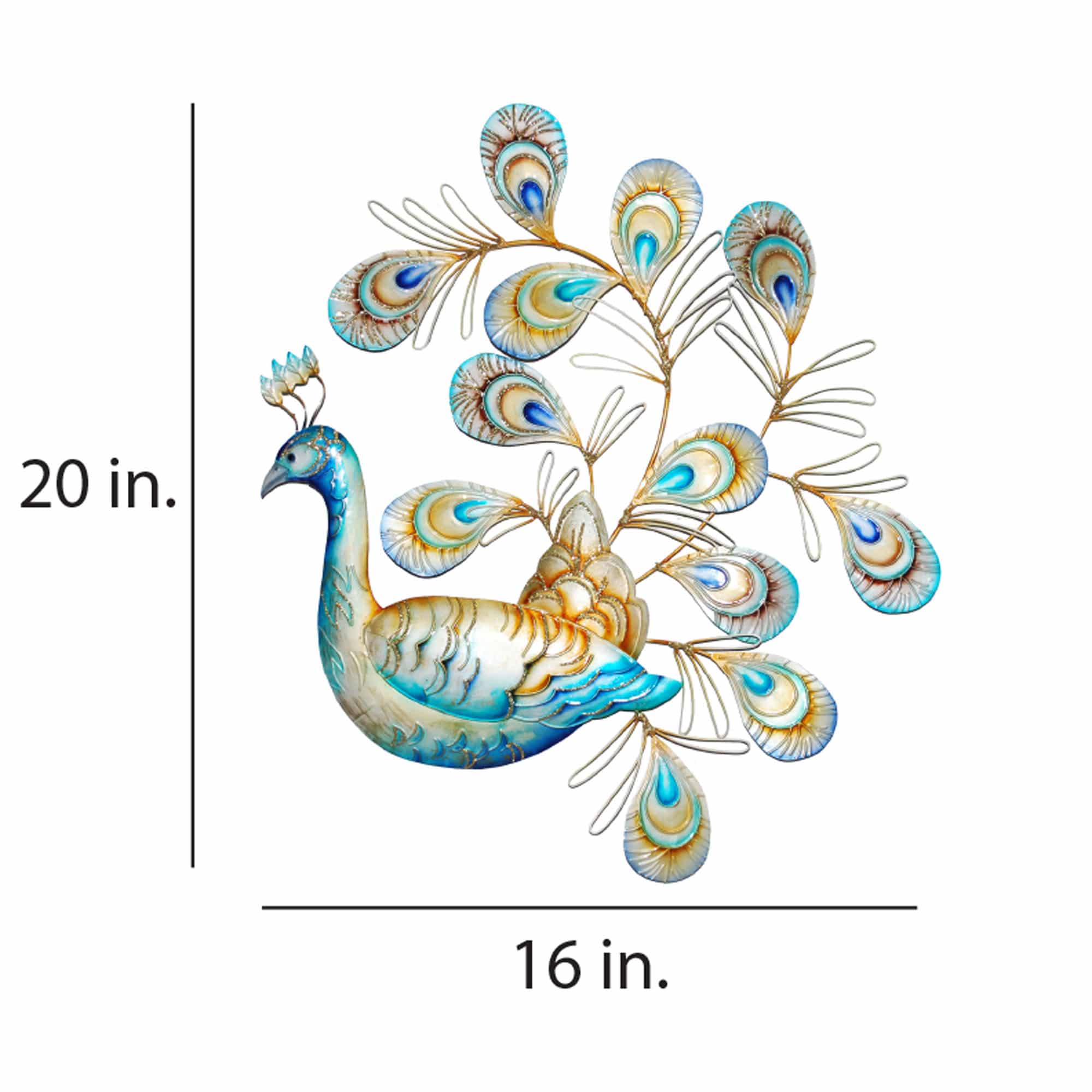
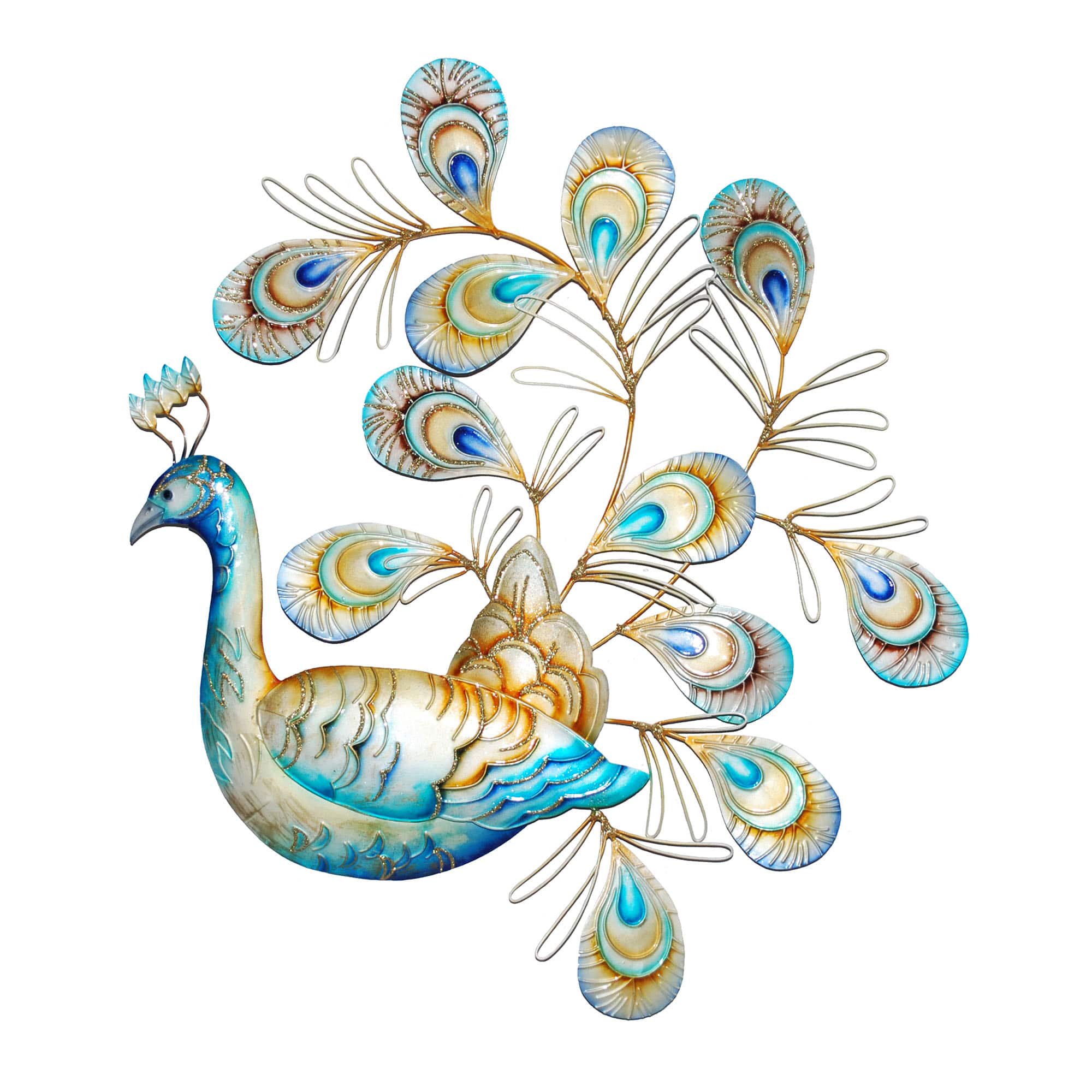 Tailfeathers raised, this Indian peacock is strutting his stuff. On display is its iridescent blue and green, metallic-colored, plumage. Throughout its tailfeathers, the artists drew in the peacock's distinctive eyespots, with the eye itself in different colors. The chest of the bird is crafted from capiz shell, carefully painted in the blues and greens this bird is known for. It fits perfectly within any decor style and will add the finishing touch to its surroundings. The basic frame of this piece is created using tin, which is powder coated with a black finish. The frame is reinforced using tin wire along the inner edge. The front of the body is adorned with capiz. Capiz is an oyster shell and the primary purpose of the oyster is as a source of food. However, the by-product, the shell, can be used for decoration. Due to it being a natural material, the natural colors of the capiz may come through as tans and browns underneath the hand-painted surface.
Tailfeathers raised, this Indian peacock is strutting his stuff. On display is its iridescent blue and green, metallic-colored, plumage. Throughout its tailfeathers, the artists drew in the peacock's distinctive eyespots, with the eye itself in different colors. The chest of the bird is crafted from capiz shell, carefully painted in the blues and greens this bird is known for. It fits perfectly within any decor style and will add the finishing touch to its surroundings. The basic frame of this piece is created using tin, which is powder coated with a black finish. The frame is reinforced using tin wire along the inner edge. The front of the body is adorned with capiz. Capiz is an oyster shell and the primary purpose of the oyster is as a source of food. However, the by-product, the shell, can be used for decoration. Due to it being a natural material, the natural colors of the capiz may come through as tans and browns underneath the hand-painted surface. -
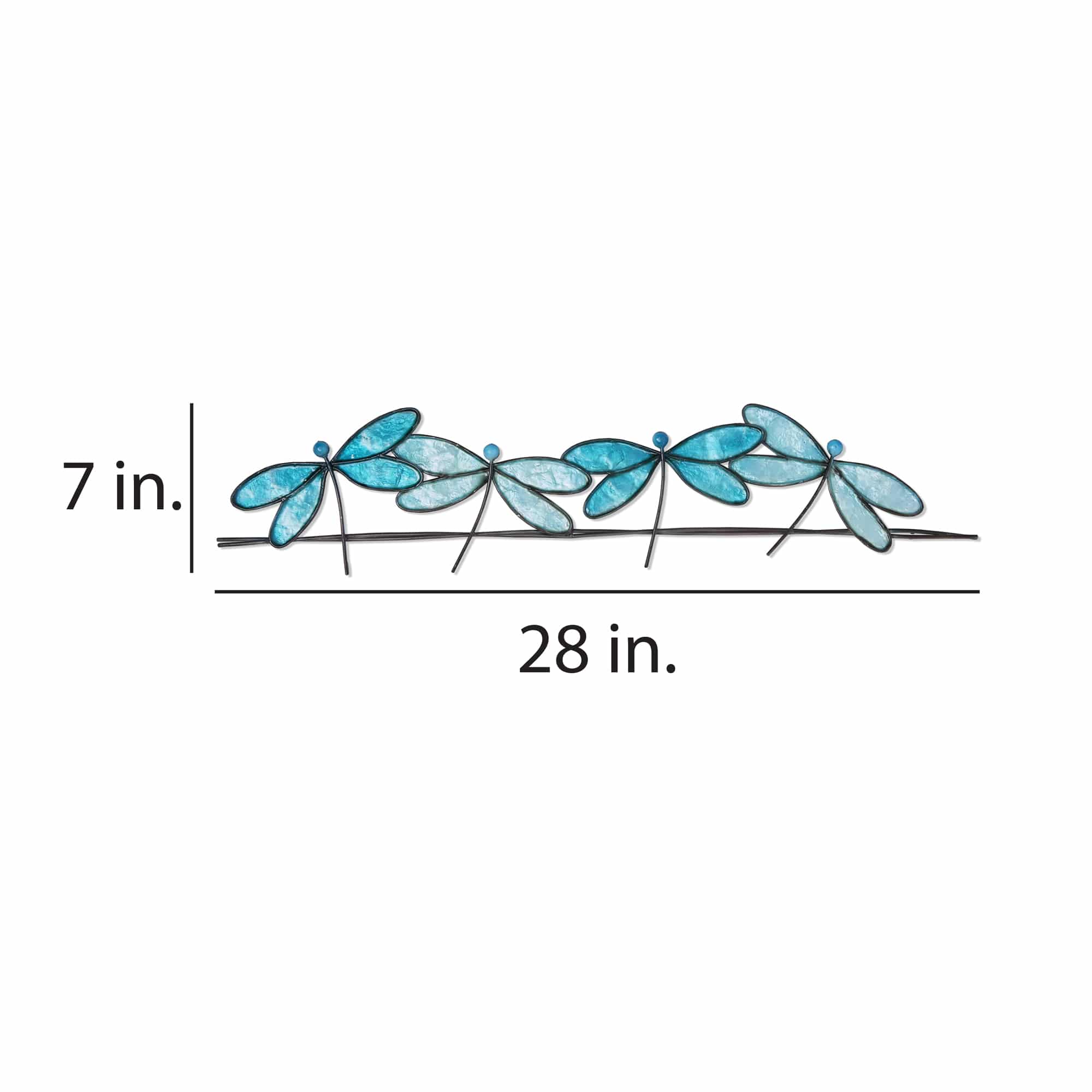

Four dragonflies are taking a mid-day break from fluttering and their characteristically unpredictable flight patterns around the lake. The slender, metal body of each dragonfly connects to colorful, capiz-shell wings, which catches light and adds shine. Each wing is framed using sturdy wrought iron and reinforced with a metal backing.
The basic frame of the dragonfly is created using tin, which is powder-coated with a black finish and makes this piece safe to use outdoors. The edges of the frame are reinforced using thicker tin wire. The front of this piece is adorned in areas with capiz shell, an oyster native to the Philippines, before being hand-painted and sealed with a water-based sealant. The primary purpose of this oyster to provide a source of food, however, the shell is a sustainable by-product that can be used for decoration. The capiz shell subtly replicates the reflective qualities of dragonflies in nature. The entire piece is lightweight and has an eyelet in the back allowing it to be hung using a finishing nail, command strip, or a push pin. Due to it being a natural material, the organic colors of capiz come through as tans and browns underneath the paint.
-
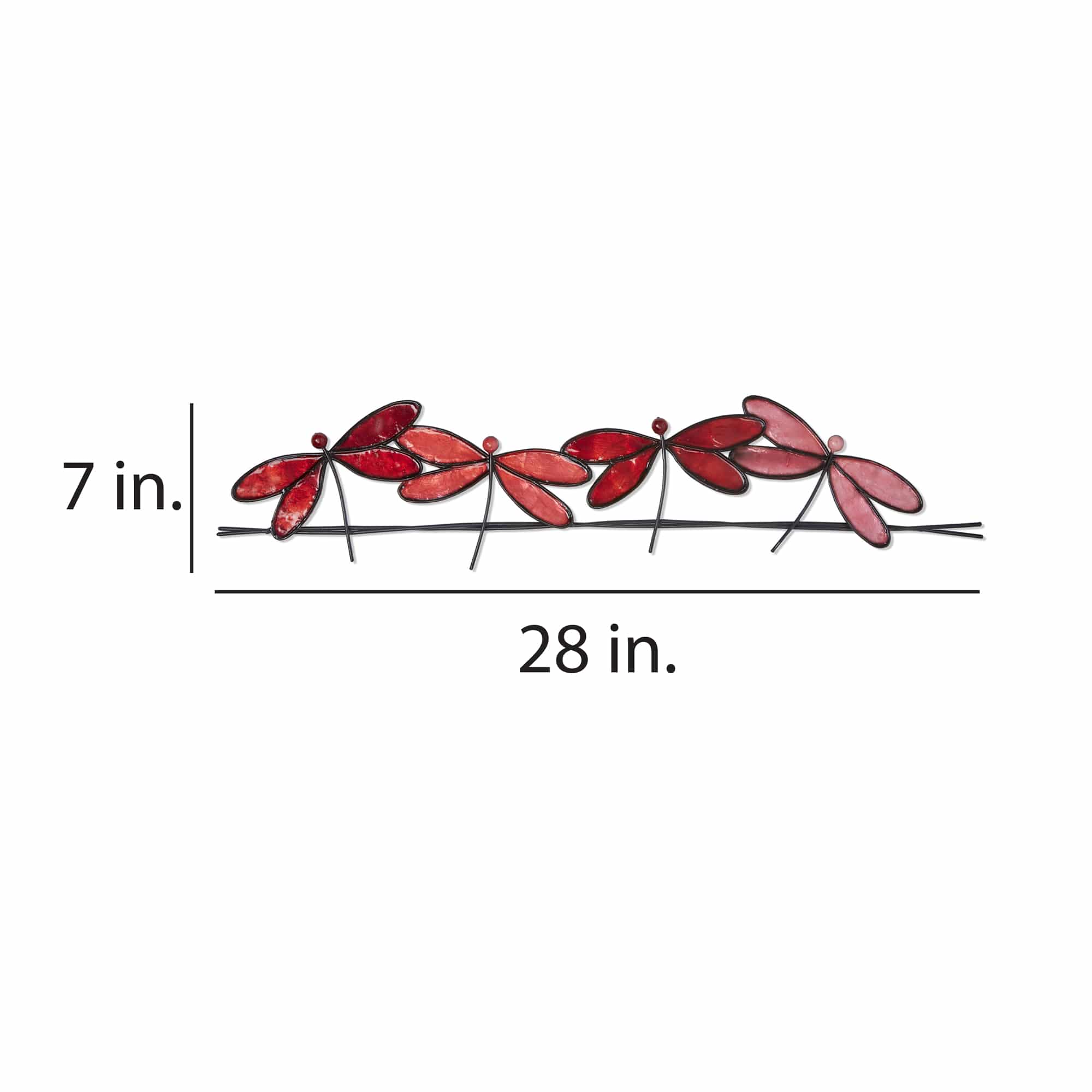
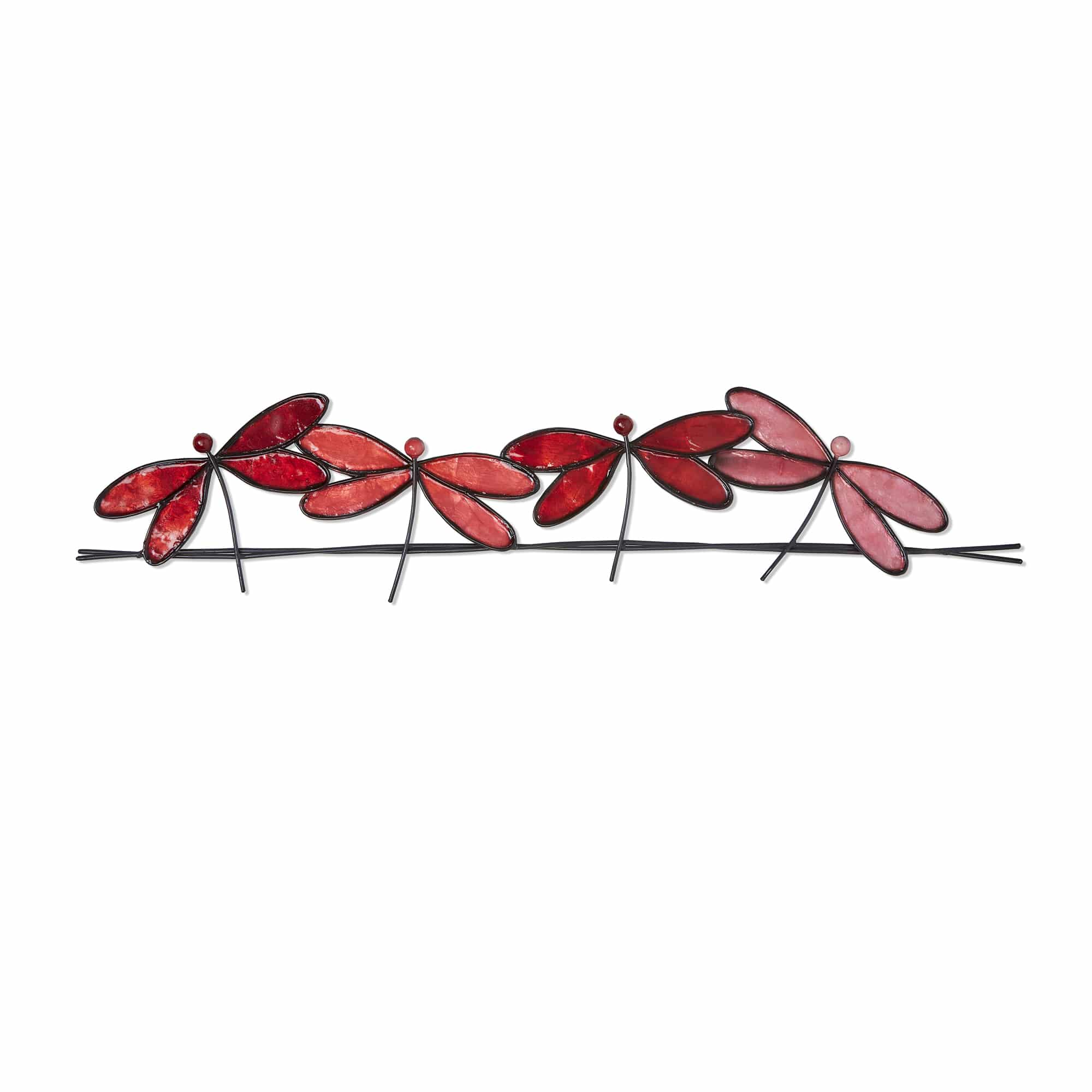 Four dragonflies are taking a mid-day break from fluttering and their characteristically unpredictable flight patterns around the lake. The slender, metal body of each dragonfly connects to colorful, capiz-shell wings, which catches light and adds shine. Each wing is framed using sturdy wrought iron and reinforced with a metal backing. The basic frame of the dragonfly is created using tin, which is powder-coated with a black finish and makes this piece safe to use outdoors. The edges of the frame are reinforced using thicker tin wire. The front of this piece is adorned in areas with capiz shell, an oyster native to the Philippines, before being hand-painted and sealed with a water-based sealant. The primary purpose of this oyster to provide a source of food, however, the shell is a sustainable by-product that can be used for decoration. The capiz shell subtly replicates the reflective qualities of dragonflies in nature. The entire piece is lightweight and has an eyelet in the back allowing it to be hung using a finishing nail, command strip, or a push pin. Due to it being a natural material, the organic colors of capiz come through as tans and browns underneath the paint.
Four dragonflies are taking a mid-day break from fluttering and their characteristically unpredictable flight patterns around the lake. The slender, metal body of each dragonfly connects to colorful, capiz-shell wings, which catches light and adds shine. Each wing is framed using sturdy wrought iron and reinforced with a metal backing. The basic frame of the dragonfly is created using tin, which is powder-coated with a black finish and makes this piece safe to use outdoors. The edges of the frame are reinforced using thicker tin wire. The front of this piece is adorned in areas with capiz shell, an oyster native to the Philippines, before being hand-painted and sealed with a water-based sealant. The primary purpose of this oyster to provide a source of food, however, the shell is a sustainable by-product that can be used for decoration. The capiz shell subtly replicates the reflective qualities of dragonflies in nature. The entire piece is lightweight and has an eyelet in the back allowing it to be hung using a finishing nail, command strip, or a push pin. Due to it being a natural material, the organic colors of capiz come through as tans and browns underneath the paint. -
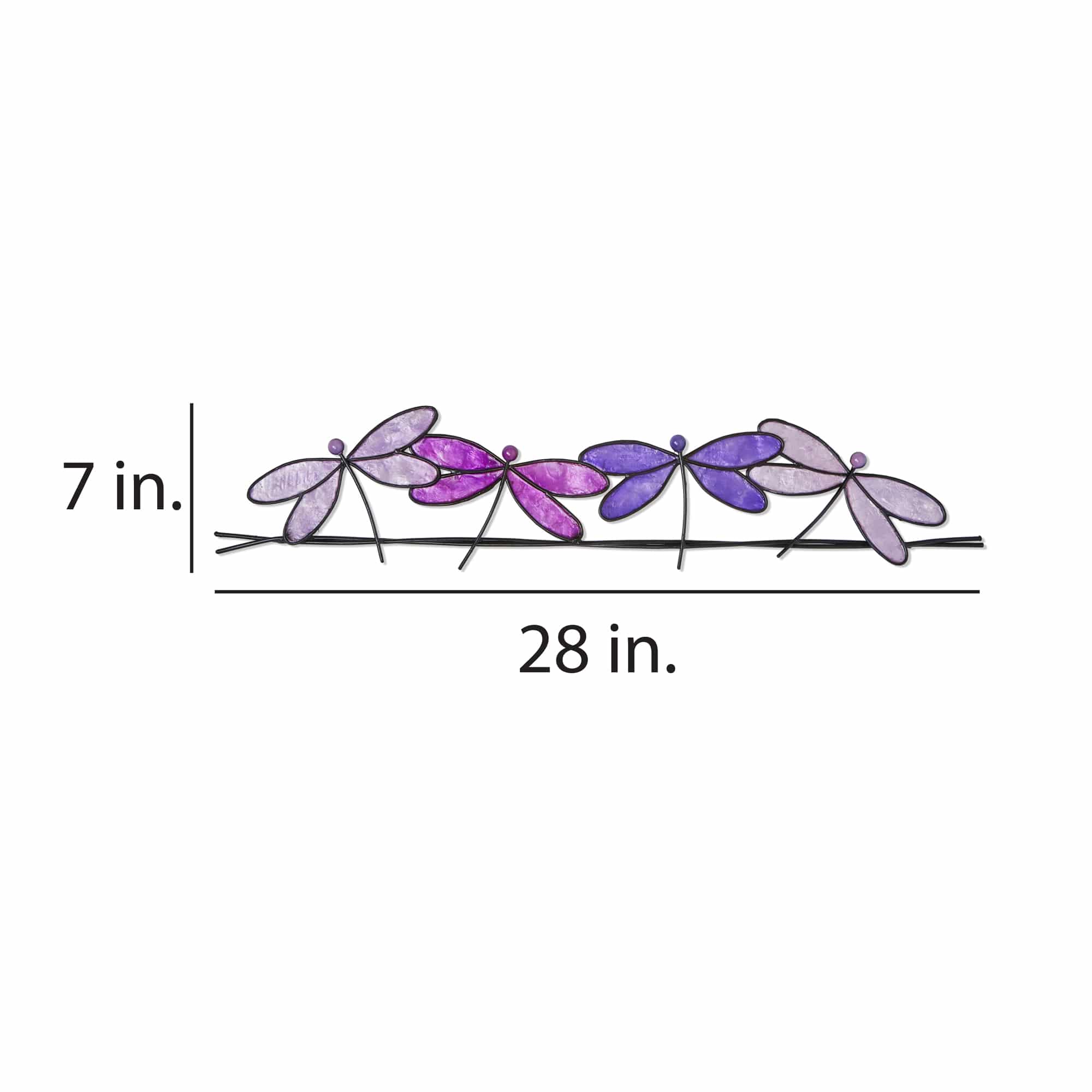
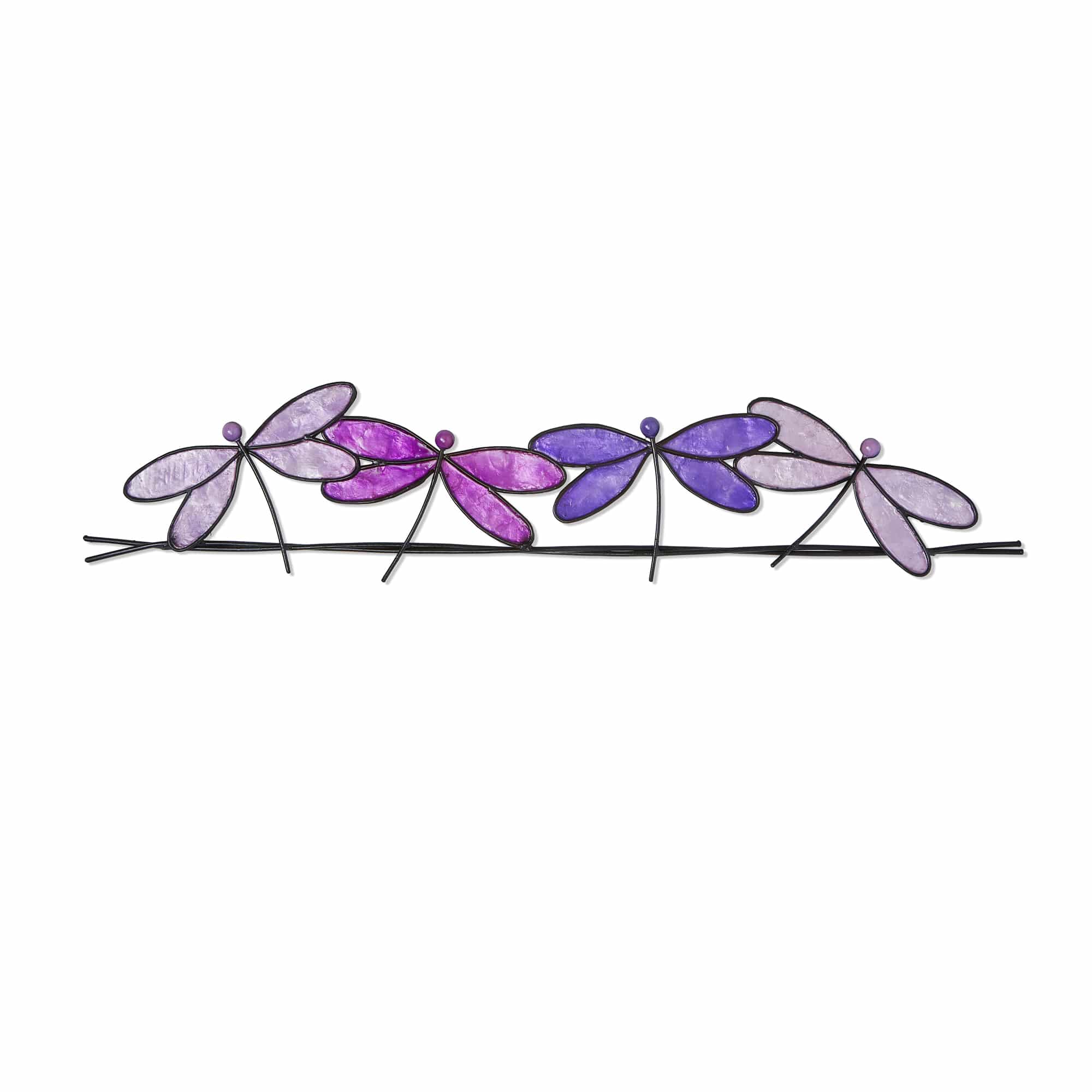
Four dragonflies are taking a mid-day break from fluttering and their characteristically unpredictable flight patterns around the lake. The slender, metal body of each dragonfly connects to colorful, capiz-shell wings, which catches light and adds shine. Each wing is framed using sturdy wrought iron and reinforced with a metal backing.
The basic frame of the dragonfly is created using tin, which is powder-coated with a black finish and makes this piece safe to use outdoors. The edges of the frame are reinforced using thicker tin wire. The front of this piece is adorned in areas with capiz shell, an oyster native to the Philippines, before being hand-painted and sealed with a water-based sealant. The primary purpose of this oyster to provide a source of food, however, the shell is a sustainable by-product that can be used for decoration. The capiz shell subtly replicates the reflective qualities of dragonflies in nature. The entire piece is lightweight and has an eyelet in the back allowing it to be hung using a finishing nail, command strip, or a push pin. Due to it being a natural material, the organic colors of capiz come through as tans and browns underneath the paint.
-
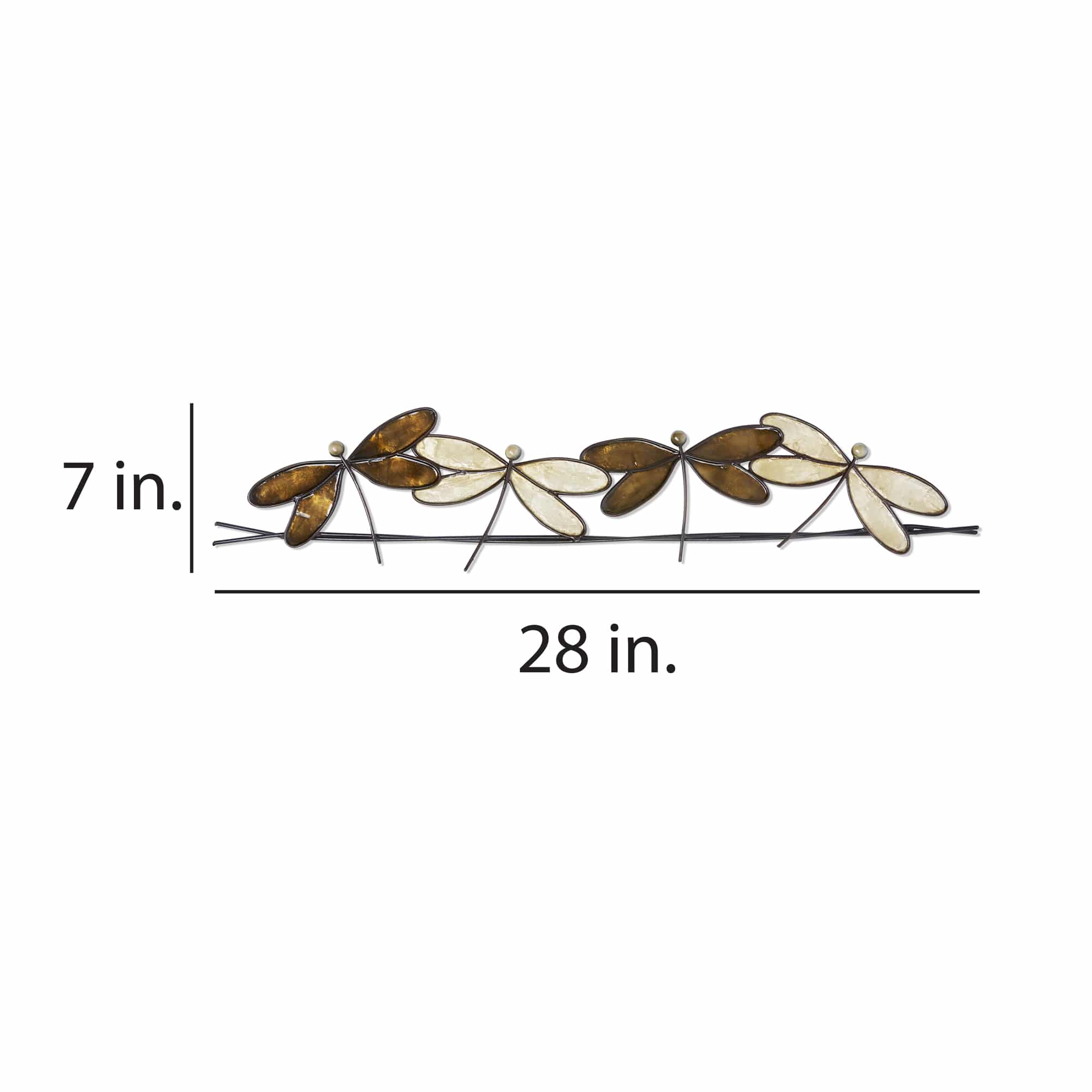
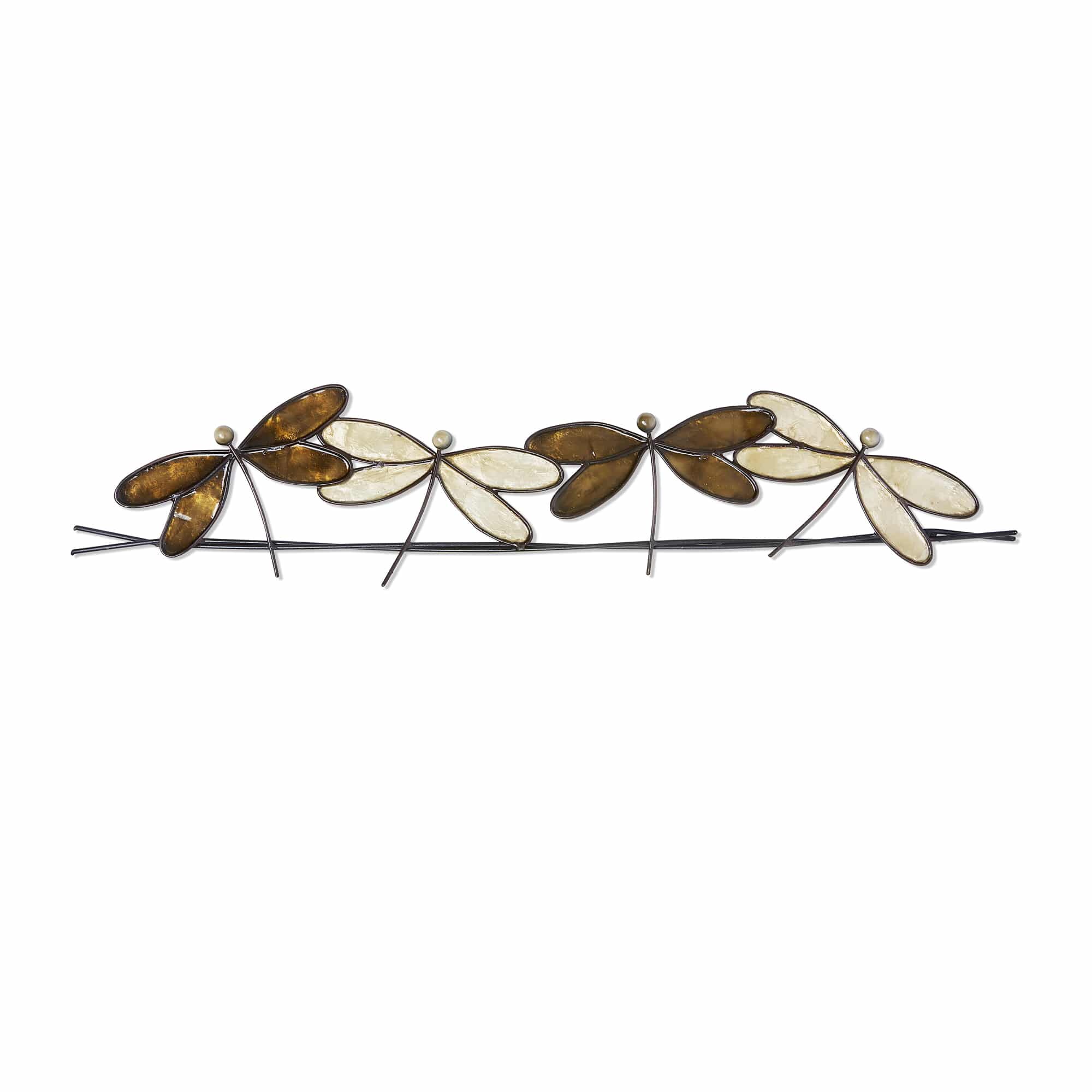
Four dragonflies are taking a mid-day break from fluttering and their characteristically unpredictable flight patterns around the lake. The slender, metal body of each dragonfly connects to colorful, capiz-shell wings, which catches light and adds shine. Each wing is framed using sturdy wrought iron and reinforced with a metal backing.
The basic frame of the dragonfly is created using tin, which is powder-coated with a black finish and makes this piece safe to use outdoors. The edges of the frame are reinforced using thicker tin wire. The front of this piece is adorned in areas with capiz shell, an oyster native to the Philippines, before being hand-painted and sealed with a water-based sealant. The primary purpose of this oyster to provide a source of food, however, the shell is a sustainable by-product that can be used for decoration. The capiz shell subtly replicates the reflective qualities of dragonflies in nature. The entire piece is lightweight and has an eyelet in the back allowing it to be hung using a finishing nail, command strip, or a push pin. Due to it being a natural material, the organic colors of capiz come through as tans and browns underneath the paint.
-

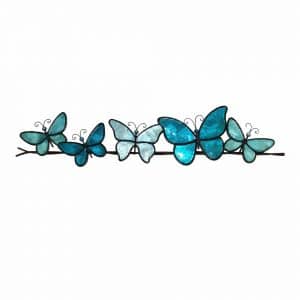
Five, fluttering butterflies are ready to complete their journey after taking a break from a long migration. The slender, metal body of each butterfly connects to colorful capiz-shell wings which catches light and adds shine. Each wing is framed using sturdy wrought iron and reinforced with a metal backing.
The basic frame of the butterfly is created using tin, which is powder-coated with a black finish and makes this piece safe to use outdoors. The edges of the frame are reinforced using thicker tin wire. The front of this piece is adorned in areas with capiz shell, an oyster native to the Philippines, before being hand-painted and sealed with a water-based sealant. The primary purpose of this oyster to provide a source of food, however, the shell is a sustainable by-product that can be used for decoration. The capiz shell subtly replicates the reflective qualities of butterflies in nature. The entire piece is lightweight and has an eyelet in the back allowing it to be hung using a finishing nail, command strip, or a push pin. Due to it being a natural material, the organic colors of capiz come through as tans and browns underneath the paint.
-

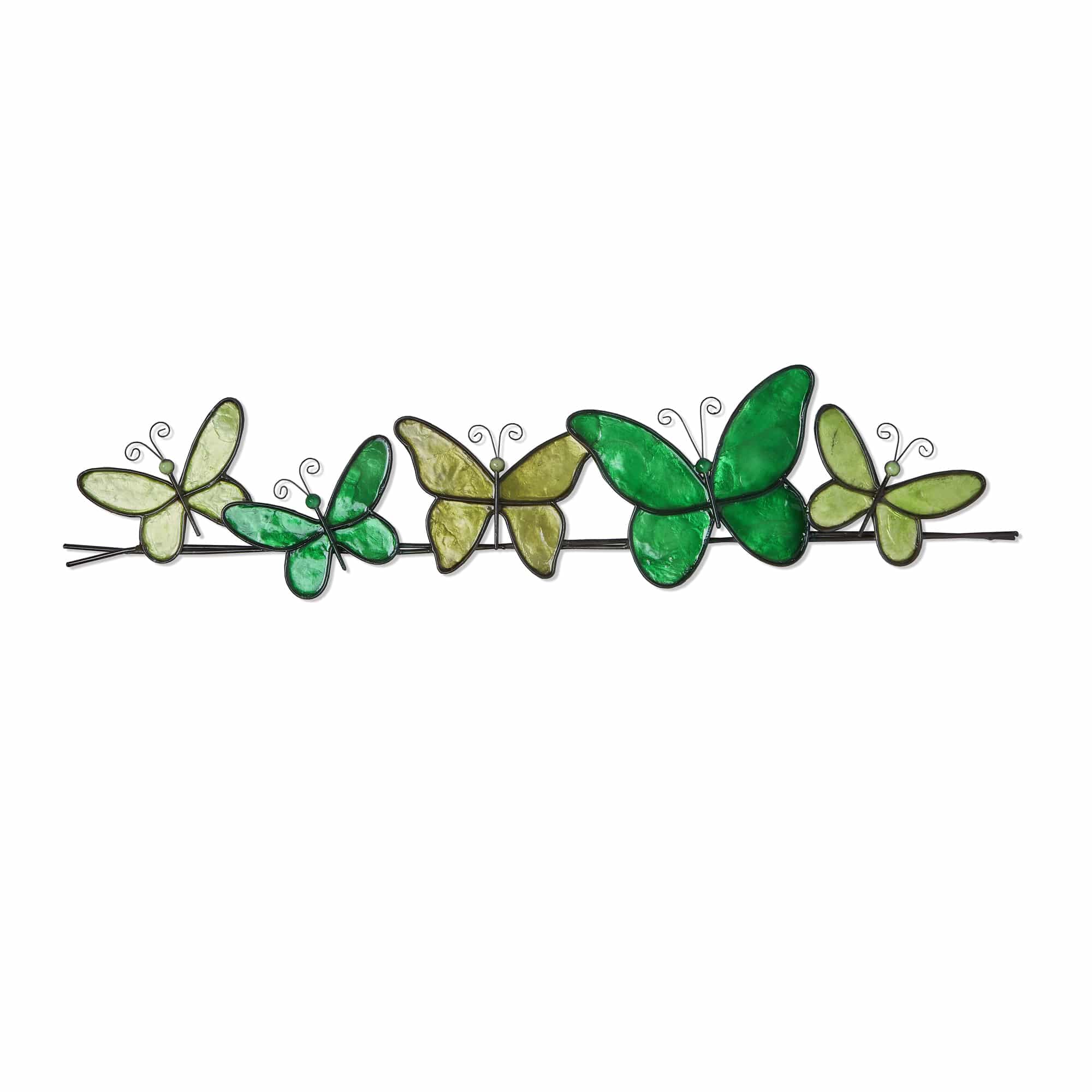 Five, fluttering butterflies are ready to complete their journey after taking a break from a long migration. The slender, metal body of each butterfly connects to colorful capiz-shell wings which catches light and adds shine. Each wing is framed using sturdy wrought iron and reinforced with a metal backing. The basic frame of the butterfly is created using tin, which is powder-coated with a black finish and makes this piece safe to use outdoors. The edges of the frame are reinforced using thicker tin wire. The front of this piece is adorned in areas with capiz shell, an oyster native to the Philippines, before being hand-painted and sealed with a water-based sealant. The primary purpose of this oyster to provide a source of food, however, the shell is a sustainable by-product that can be used for decoration. The capiz shell subtly replicates the reflective qualities of butterflies in nature. The entire piece is lightweight and has an eyelet in the back allowing it to be hung using a finishing nail, command strip, or a push pin. Due to it being a natural material, the organic colors of capiz come through as tans and browns underneath the paint.
Five, fluttering butterflies are ready to complete their journey after taking a break from a long migration. The slender, metal body of each butterfly connects to colorful capiz-shell wings which catches light and adds shine. Each wing is framed using sturdy wrought iron and reinforced with a metal backing. The basic frame of the butterfly is created using tin, which is powder-coated with a black finish and makes this piece safe to use outdoors. The edges of the frame are reinforced using thicker tin wire. The front of this piece is adorned in areas with capiz shell, an oyster native to the Philippines, before being hand-painted and sealed with a water-based sealant. The primary purpose of this oyster to provide a source of food, however, the shell is a sustainable by-product that can be used for decoration. The capiz shell subtly replicates the reflective qualities of butterflies in nature. The entire piece is lightweight and has an eyelet in the back allowing it to be hung using a finishing nail, command strip, or a push pin. Due to it being a natural material, the organic colors of capiz come through as tans and browns underneath the paint. -
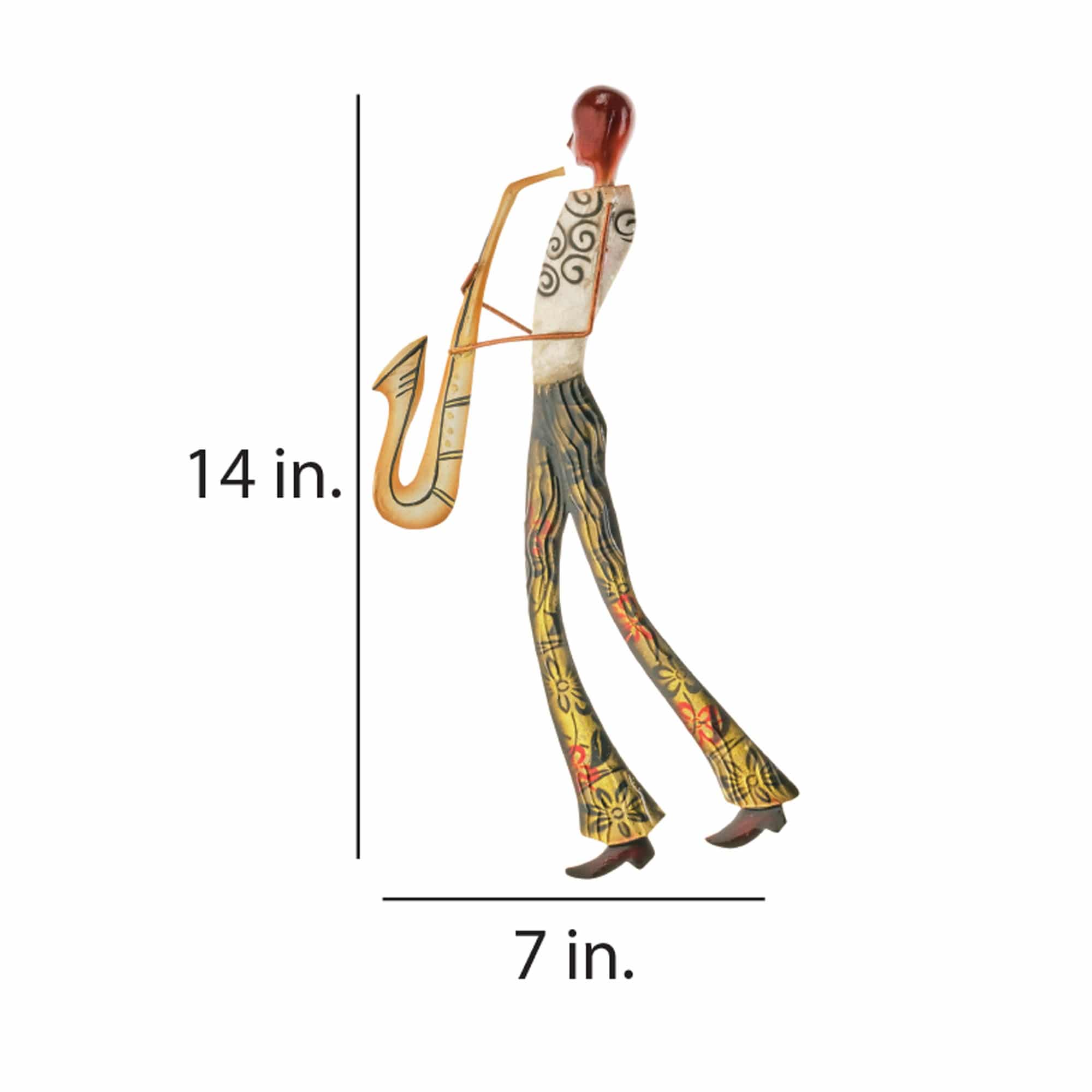
 Jazz inspires the artisan's interpretation of the sax player. Jazz is considered music of the soul due to the deep emotion that runs to the roots of this important American movement. It can be used as a journey to happy times or a reflection of struggles. This particular guitarist, with the colorful finishes, the influence is definitely in a mood of celebration. The festive shirt of the player is adorned with capiz shell, giving it a shimmer as it reflects light. The frame of the Sax Player Wall Decor is created using tin, which is powder coated as a black finish. The frame is reinforced using wrought iron wire inner and outer edges. Capiz is an oyster shell and the primary purpose of the oyster is as a source of food. However, the by-product, the shell, can be used for decoration. Due to it being a natural material, the natural colors of the capiz can come through as tans and browns underneath the paint.
Jazz inspires the artisan's interpretation of the sax player. Jazz is considered music of the soul due to the deep emotion that runs to the roots of this important American movement. It can be used as a journey to happy times or a reflection of struggles. This particular guitarist, with the colorful finishes, the influence is definitely in a mood of celebration. The festive shirt of the player is adorned with capiz shell, giving it a shimmer as it reflects light. The frame of the Sax Player Wall Decor is created using tin, which is powder coated as a black finish. The frame is reinforced using wrought iron wire inner and outer edges. Capiz is an oyster shell and the primary purpose of the oyster is as a source of food. However, the by-product, the shell, can be used for decoration. Due to it being a natural material, the natural colors of the capiz can come through as tans and browns underneath the paint. -
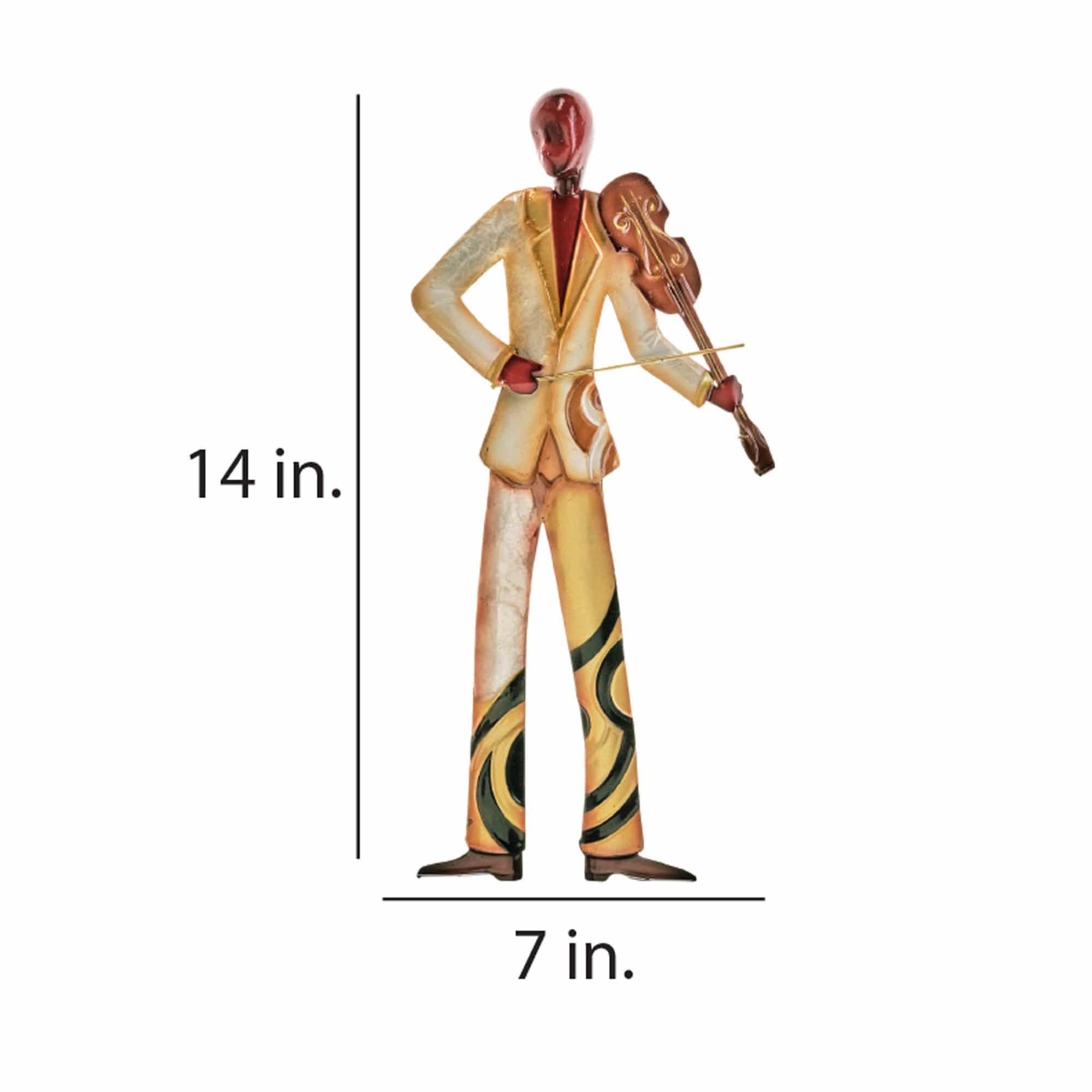
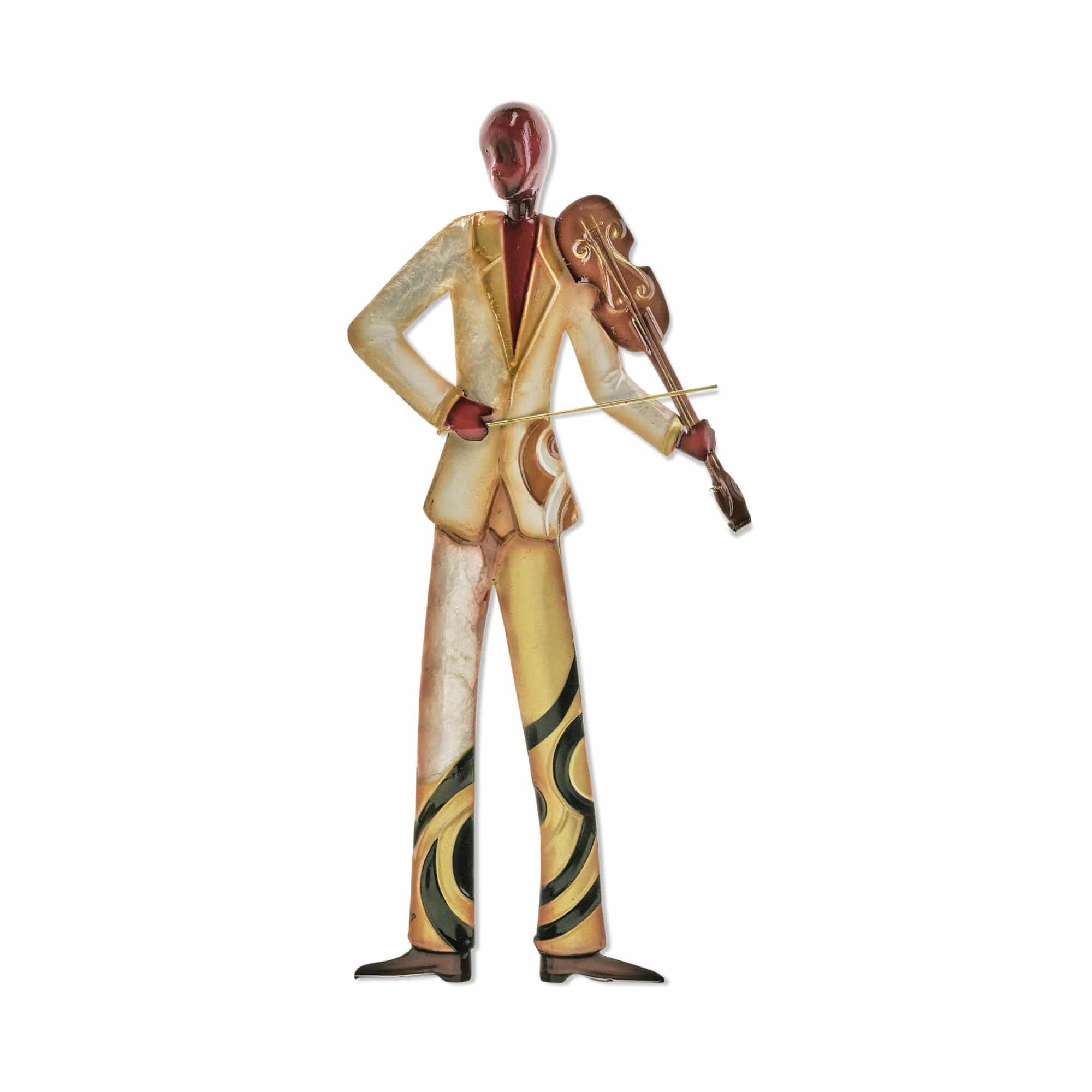
The violin transcends time. Used in both formal and festive settings, this instrument is used to convey a journey or to simply get people up to dance. The artisans bring both into one piece of art. The formal wear of the violinist invokes the classics while the color and shading of the clothing represents the festive. The well-dressed violin player is partially adorned with capiz giving it a shimmer as it reflects light, again bringing out the festive side of the instrument.
The frame of the Violin Player Wall Decor is created using tin, which is powder coated in a black finish. The frame is reinforced using wrought iron wire inner edge or outer edge. Capiz is an oyster shell and the primary purpose of the oyster is as a source of food. However, the by-product, the shell, can be used for decoration. Due to it being a natural material, the natural colors of the capiz can come through as tans and browns underneath the paint.
-
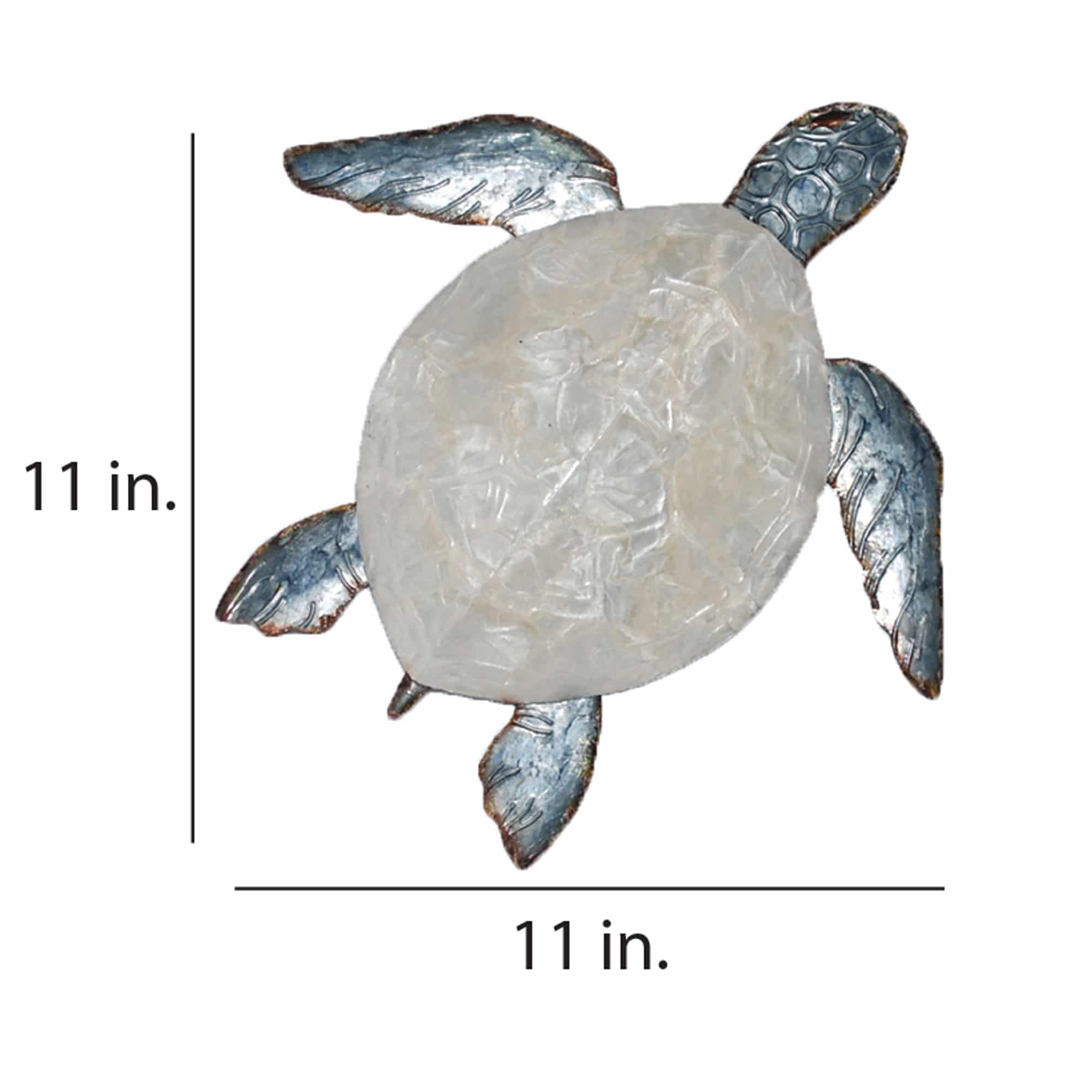
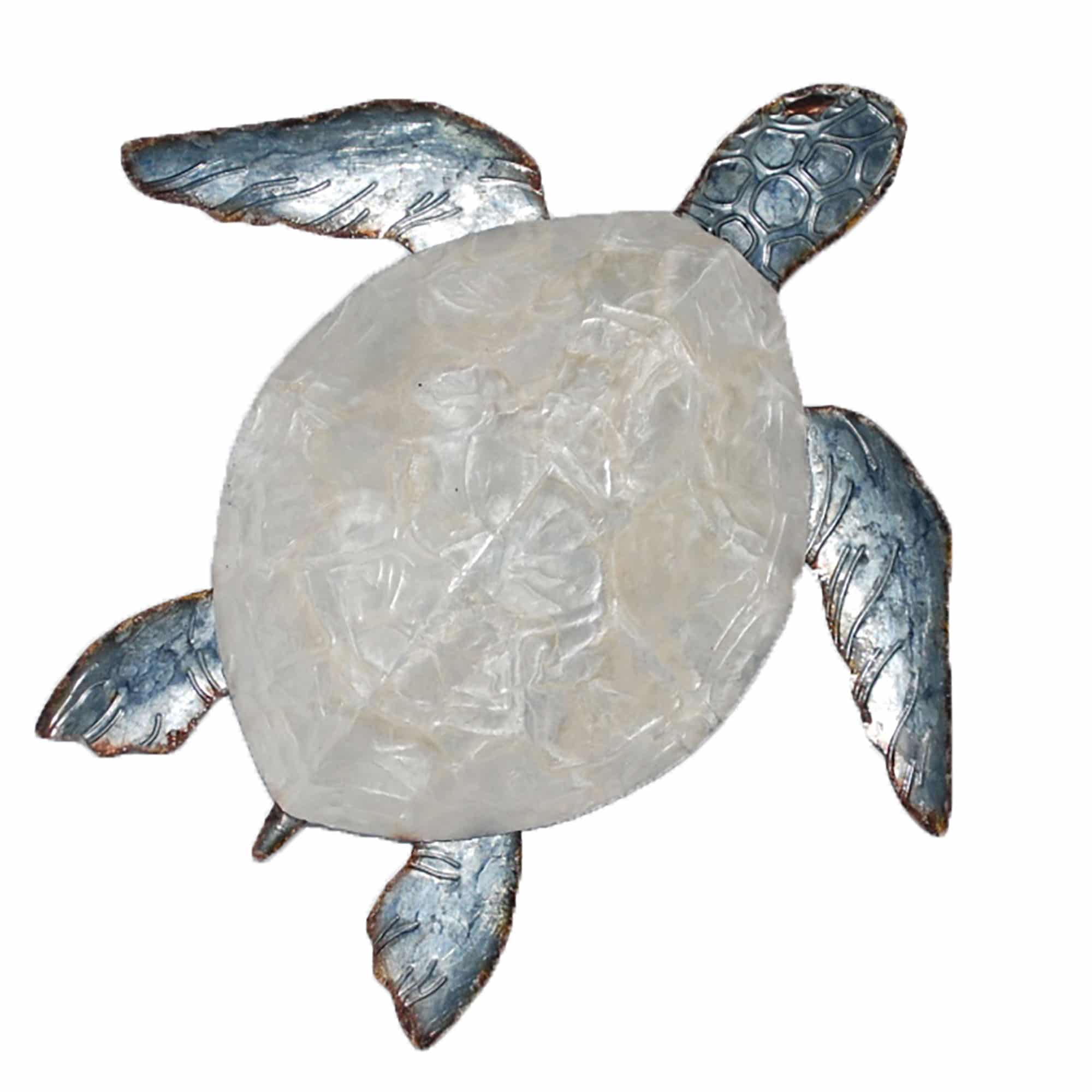 Sea turtles are among the most ancient species on this planet. Today there are seven species of sea turtle remaining that date back 110 million years, back to the age of the dinosaurs. This piece features the Loggerhead turtle, one of the most recognizable of all the sea. This creature is known for its scaled skin, which the artist carefully etches into the metal of the turtle's head and throughout the tips and edges of its body. The shell of the turtle glistens which the artist recreates using capiz shell. The focus of this awe-inspiring piece is the texture and size of sea turtles and the artist uses contrasting colors to underscore this fact. The basic frame of the turtle is created using tin, which is powder coated with a black finish. The frame is reinforced using tin wire along the inner edge. Capiz is an oyster shell and the primary purpose of the oyster is as a source of food. However, the by-product, the shell, can be used for decoration. Due to it being a natural material, the natural colors of the capiz come through as tans and browns underneath the paint. The shell is then painted the bold colors you see. The entire front facing piece is carefully hand-painted keeping in mind the reflective qualities in the color of turtles.
Sea turtles are among the most ancient species on this planet. Today there are seven species of sea turtle remaining that date back 110 million years, back to the age of the dinosaurs. This piece features the Loggerhead turtle, one of the most recognizable of all the sea. This creature is known for its scaled skin, which the artist carefully etches into the metal of the turtle's head and throughout the tips and edges of its body. The shell of the turtle glistens which the artist recreates using capiz shell. The focus of this awe-inspiring piece is the texture and size of sea turtles and the artist uses contrasting colors to underscore this fact. The basic frame of the turtle is created using tin, which is powder coated with a black finish. The frame is reinforced using tin wire along the inner edge. Capiz is an oyster shell and the primary purpose of the oyster is as a source of food. However, the by-product, the shell, can be used for decoration. Due to it being a natural material, the natural colors of the capiz come through as tans and browns underneath the paint. The shell is then painted the bold colors you see. The entire front facing piece is carefully hand-painted keeping in mind the reflective qualities in the color of turtles. -
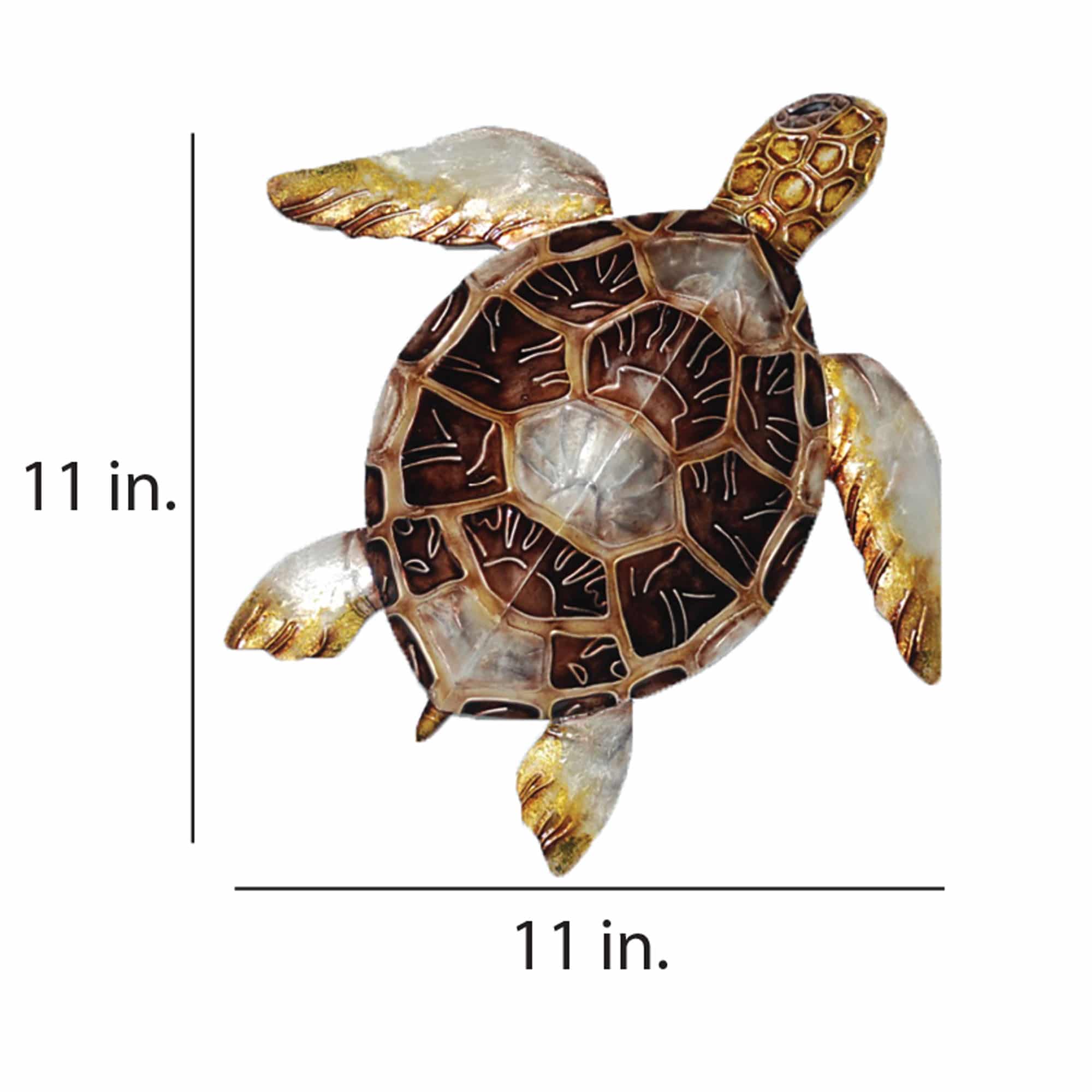
 Sea turtles are among the most ancient species on this planet. Today there are seven species of sea turtle remaining that date back 110 million years, back to the age of the dinosaurs. This piece features the Loggerhead turtle, one of the most recognizable of all the sea. This creature is known for its scaled skin, which the artist carefully etches into the metal of the turtle's head and throughout the tips and edges of its body. The shell of the turtle glistens which the artist recreates using capiz shell. The focus of this awe-inspiring piece is the texture and size of sea turtles and the artist uses contrasting colors to underscore this fact. The basic frame of the turtle is created using tin, which is powder coated with a black finish. The frame is reinforced using tin wire along the inner edge. Capiz is an oyster shell and the primary purpose of the oyster is as a source of food. However, the by-product, the shell, can be used for decoration. Due to it being a natural material, the natural colors of the capiz come through as tans and browns underneath the paint. The shell is then painted the bold colors you see. The entire front facing piece is carefully hand-painted keeping in mind the reflective qualities in the color of turtles.
Sea turtles are among the most ancient species on this planet. Today there are seven species of sea turtle remaining that date back 110 million years, back to the age of the dinosaurs. This piece features the Loggerhead turtle, one of the most recognizable of all the sea. This creature is known for its scaled skin, which the artist carefully etches into the metal of the turtle's head and throughout the tips and edges of its body. The shell of the turtle glistens which the artist recreates using capiz shell. The focus of this awe-inspiring piece is the texture and size of sea turtles and the artist uses contrasting colors to underscore this fact. The basic frame of the turtle is created using tin, which is powder coated with a black finish. The frame is reinforced using tin wire along the inner edge. Capiz is an oyster shell and the primary purpose of the oyster is as a source of food. However, the by-product, the shell, can be used for decoration. Due to it being a natural material, the natural colors of the capiz come through as tans and browns underneath the paint. The shell is then painted the bold colors you see. The entire front facing piece is carefully hand-painted keeping in mind the reflective qualities in the color of turtles. -
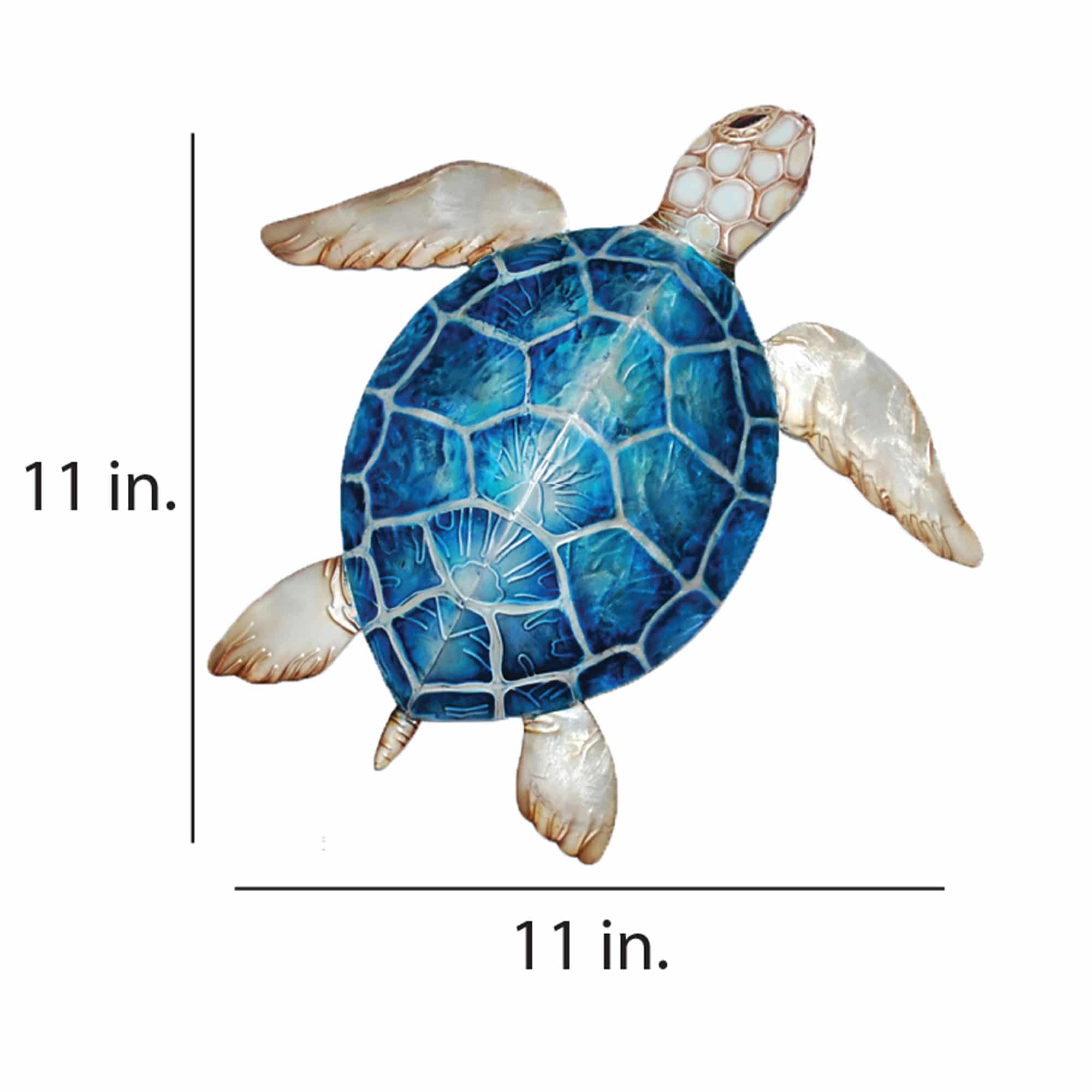
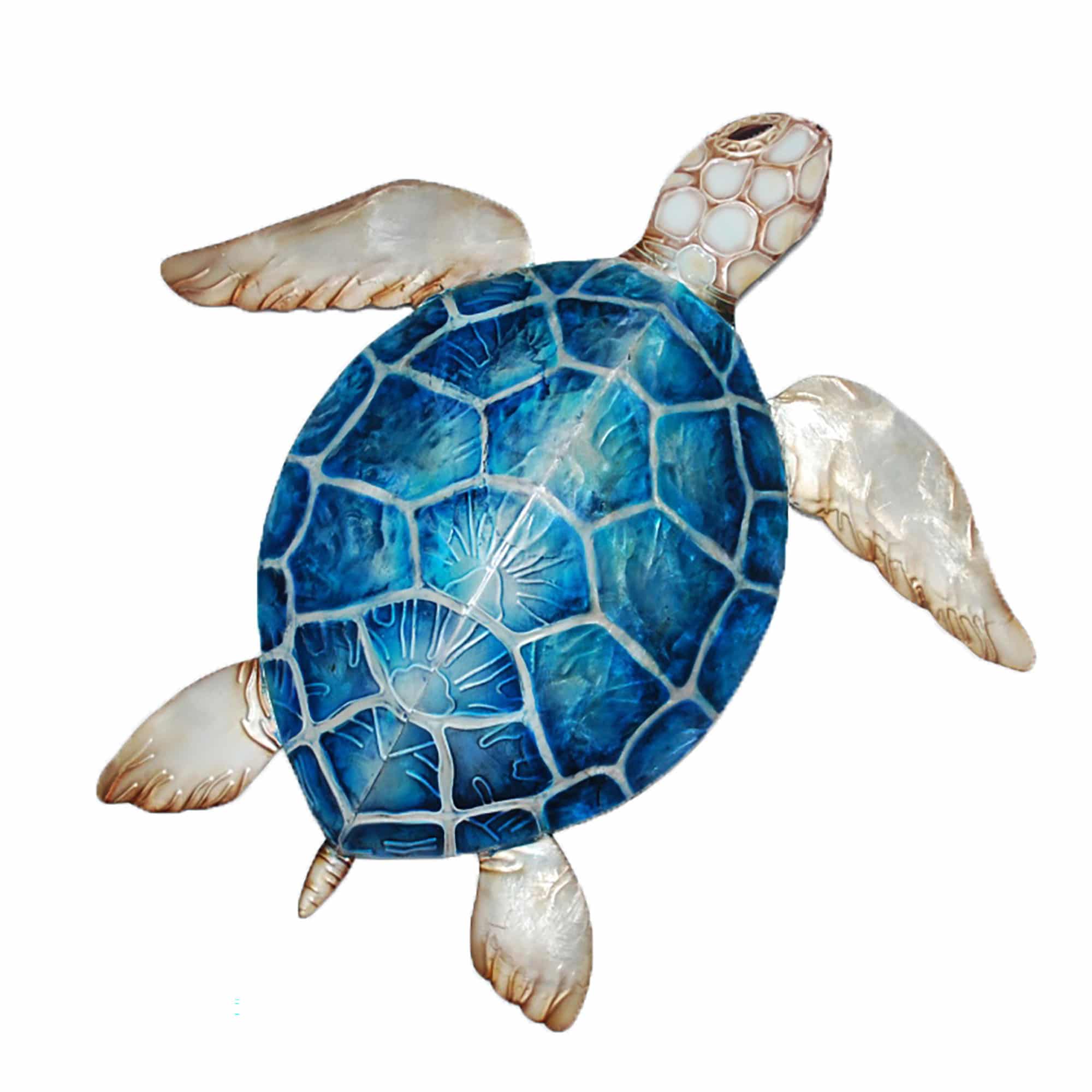 Sea turtles are among the most ancient species on this planet. Today there are seven species of sea turtle remaining that date back 110 million years, back to the age of the dinosaurs. This piece features the Loggerhead turtle, one of the most recognizable of all the sea. This creature is known for its scaled skin, which the artist carefully etches into the metal of the turtle's head and throughout the tips and edges of its body. The shell of the turtle glistens which the artist recreates using capiz shell. The focus of this awe-inspiring piece is the texture and size of sea turtles and the artist uses contrasting colors to underscore this fact. The basic frame of the turtle is created using tin, which is powder coated with a black finish. The frame is reinforced using tin wire along the inner edge. Capiz is an oyster shell and the primary purpose of the oyster is as a source of food. However, the by-product, the shell, can be used for decoration. Due to it being a natural material, the natural colors of the capiz come through as tans and browns underneath the paint. The shell is then painted the bold colors you see. The entire front facing piece is carefully hand-painted keeping in mind the reflective qualities in the color of turtles.
Sea turtles are among the most ancient species on this planet. Today there are seven species of sea turtle remaining that date back 110 million years, back to the age of the dinosaurs. This piece features the Loggerhead turtle, one of the most recognizable of all the sea. This creature is known for its scaled skin, which the artist carefully etches into the metal of the turtle's head and throughout the tips and edges of its body. The shell of the turtle glistens which the artist recreates using capiz shell. The focus of this awe-inspiring piece is the texture and size of sea turtles and the artist uses contrasting colors to underscore this fact. The basic frame of the turtle is created using tin, which is powder coated with a black finish. The frame is reinforced using tin wire along the inner edge. Capiz is an oyster shell and the primary purpose of the oyster is as a source of food. However, the by-product, the shell, can be used for decoration. Due to it being a natural material, the natural colors of the capiz come through as tans and browns underneath the paint. The shell is then painted the bold colors you see. The entire front facing piece is carefully hand-painted keeping in mind the reflective qualities in the color of turtles. -
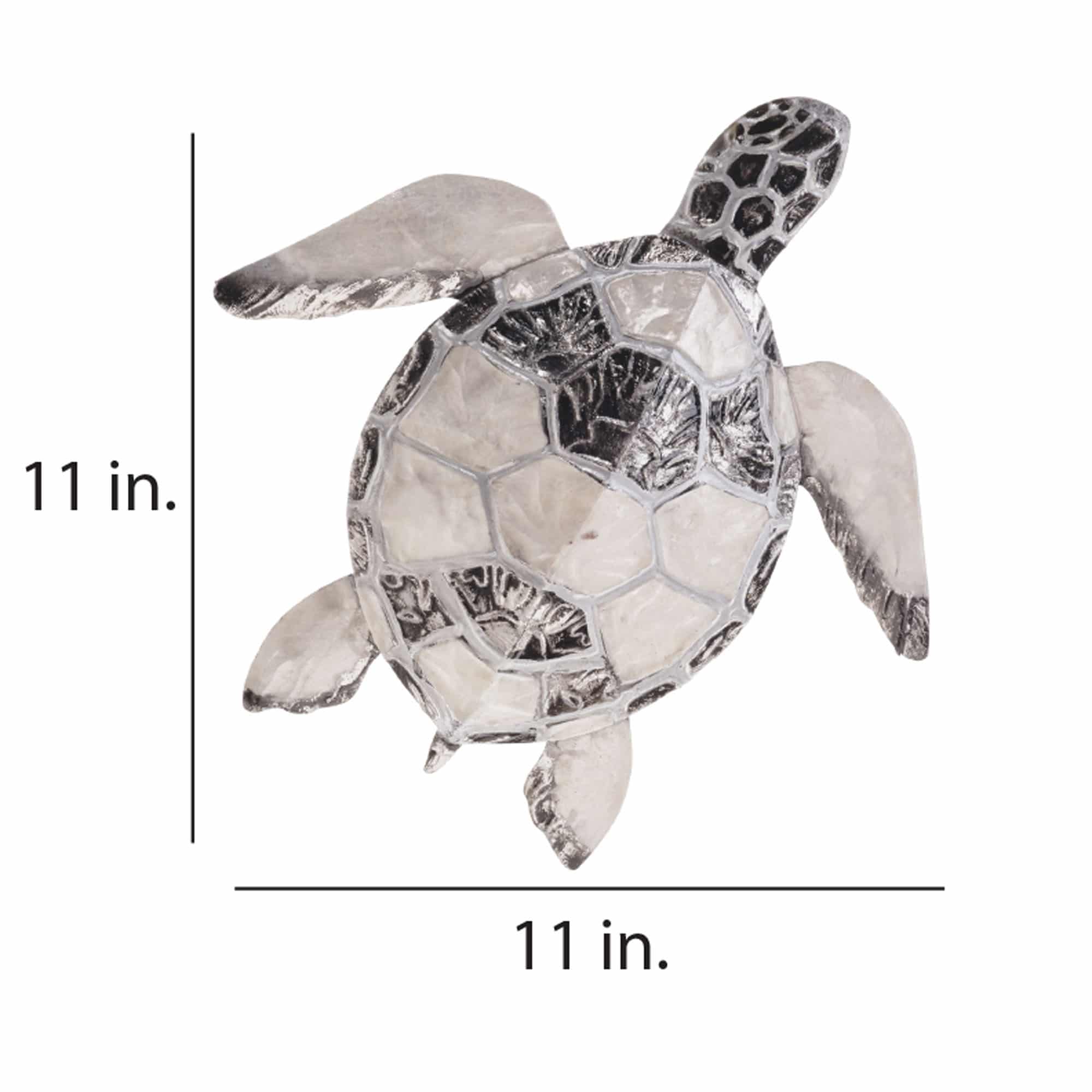
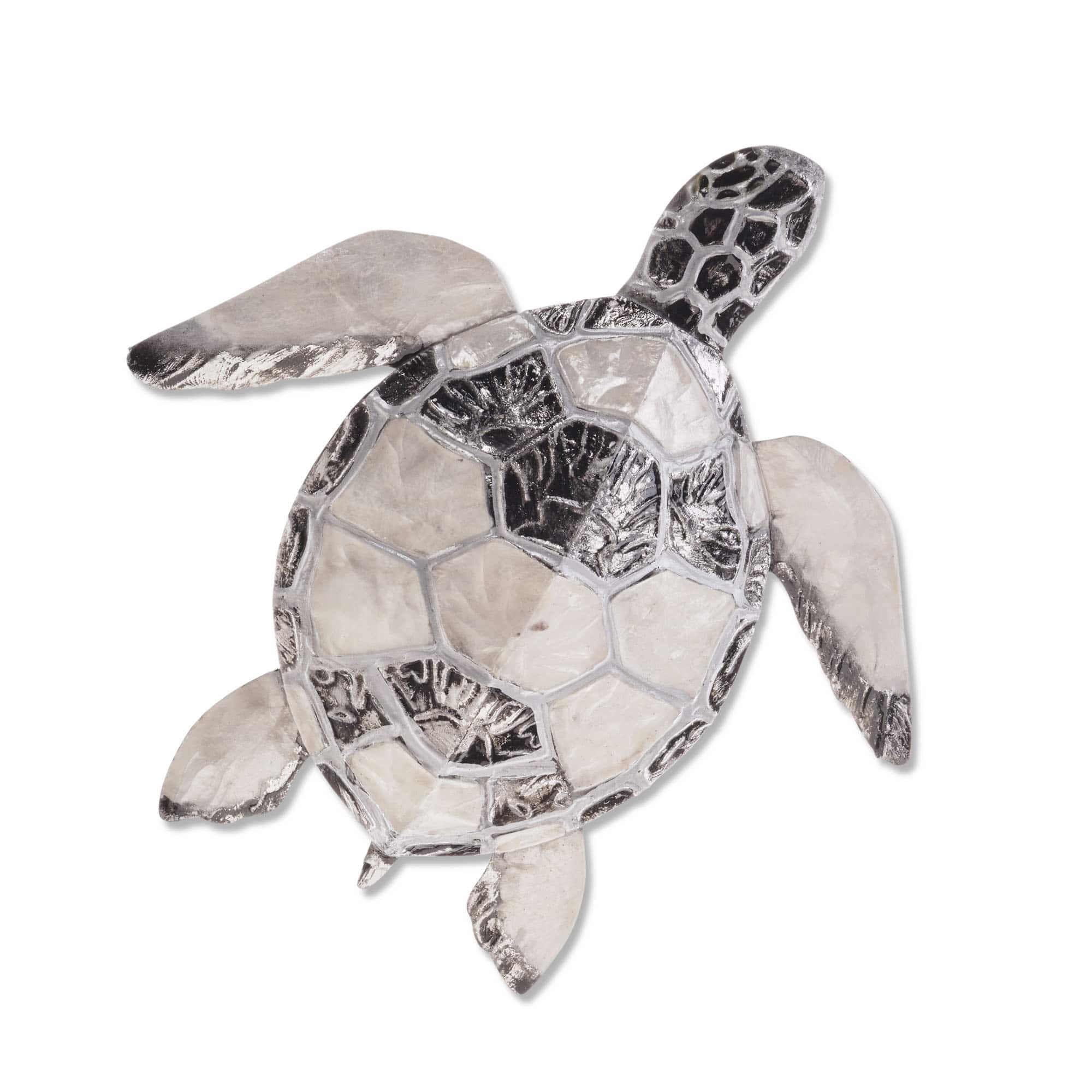 Sea turtles are among the most ancient species on this planet. Today there are seven species of sea turtle remaining that date back 110 million years, back to the age of the dinosaurs. This piece features the Loggerhead turtle, one of the most recognizable of all the sea. This creature is known for its scaled skin, which the artist carefully etches into the metal of the turtle's head and throughout the tips and edges of its body. The shell of the turtle glistens which the artist recreates using capiz shell. The focus of this awe-inspiring piece is the texture and size of sea turtles and the artist uses contrasting colors to underscore this fact. The basic frame of the turtle is created using tin, which is powder coated with a black finish. The frame is reinforced using tin wire along the inner edge. Capiz is an oyster shell and the primary purpose of the oyster is as a source of food. However, the by-product, the shell, can be used for decoration. Due to it being a natural material, the natural colors of the capiz come through as tans and browns underneath the paint. The shell is then painted the bold colors you see. The entire front facing piece is carefully hand-painted keeping in mind the reflective qualities in the color of turtles.
Sea turtles are among the most ancient species on this planet. Today there are seven species of sea turtle remaining that date back 110 million years, back to the age of the dinosaurs. This piece features the Loggerhead turtle, one of the most recognizable of all the sea. This creature is known for its scaled skin, which the artist carefully etches into the metal of the turtle's head and throughout the tips and edges of its body. The shell of the turtle glistens which the artist recreates using capiz shell. The focus of this awe-inspiring piece is the texture and size of sea turtles and the artist uses contrasting colors to underscore this fact. The basic frame of the turtle is created using tin, which is powder coated with a black finish. The frame is reinforced using tin wire along the inner edge. Capiz is an oyster shell and the primary purpose of the oyster is as a source of food. However, the by-product, the shell, can be used for decoration. Due to it being a natural material, the natural colors of the capiz come through as tans and browns underneath the paint. The shell is then painted the bold colors you see. The entire front facing piece is carefully hand-painted keeping in mind the reflective qualities in the color of turtles. -
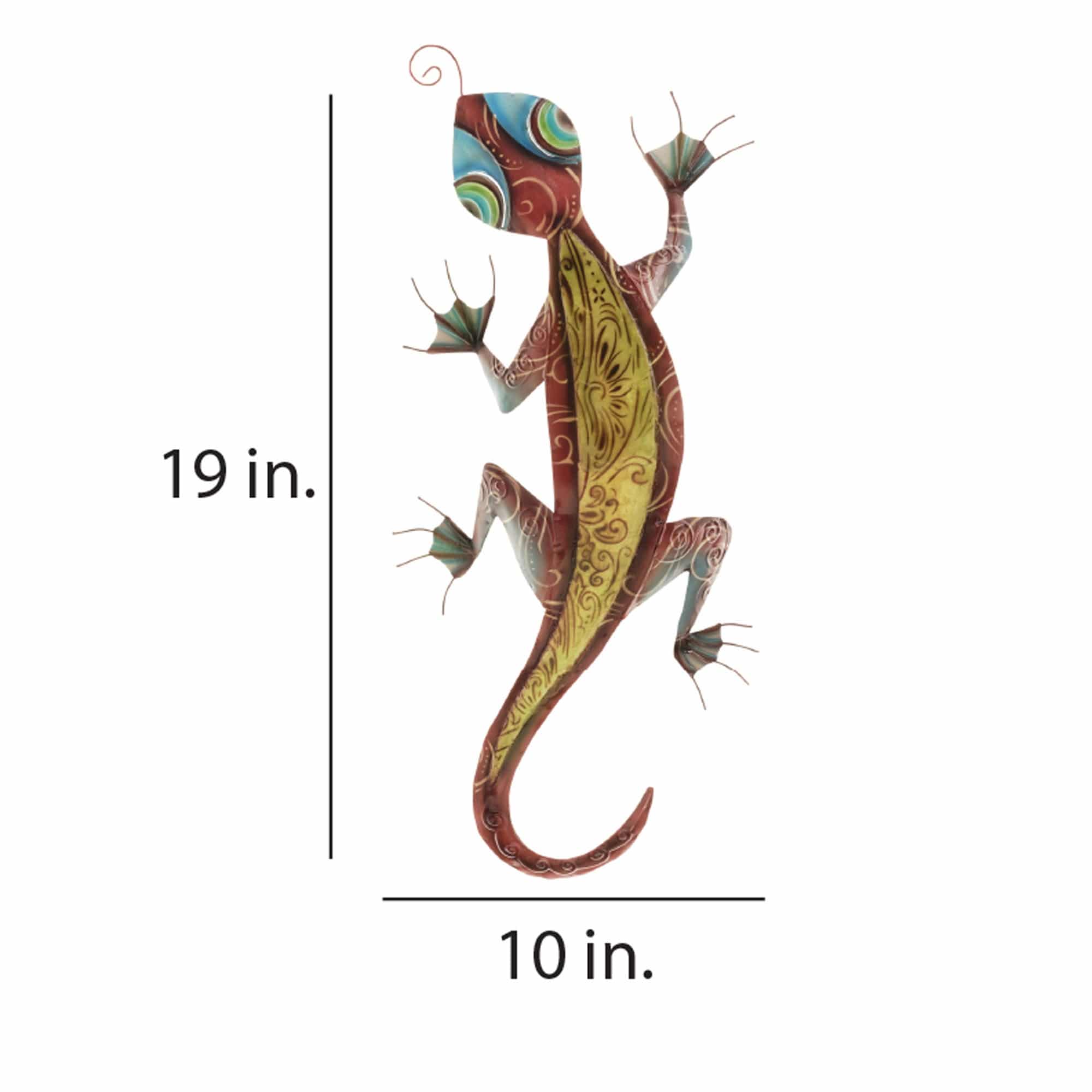
 Bright and colorful, this playful gecko will add a spark of life to any space. With its tightly curled tongue and wide-open eyes, this gecko is on the move. Down the center of the gecko the artist uses capiz shell which is then hand-painted yellow to reflect the iridescent nature of the gecko. This cheerful gecko is great by itself, but it looks even better in pairs. The basic frame of the gecko is created using tin, which is powder coated with a black finish. The frame is reinforced using tin wire along the inner edge. Capiz is an oyster shell and the primary purpose of the oyster is as a source of food. However, the by-product, the shell, can be used for decoration. Due to it being a natural material, the natural colors of the capiz come through as tans and browns underneath the paint. The shell is then painted the bold colors you see. The entire front facing piece is carefully hand-painted keeping in mind the reflective qualities in the color of geckos.
Bright and colorful, this playful gecko will add a spark of life to any space. With its tightly curled tongue and wide-open eyes, this gecko is on the move. Down the center of the gecko the artist uses capiz shell which is then hand-painted yellow to reflect the iridescent nature of the gecko. This cheerful gecko is great by itself, but it looks even better in pairs. The basic frame of the gecko is created using tin, which is powder coated with a black finish. The frame is reinforced using tin wire along the inner edge. Capiz is an oyster shell and the primary purpose of the oyster is as a source of food. However, the by-product, the shell, can be used for decoration. Due to it being a natural material, the natural colors of the capiz come through as tans and browns underneath the paint. The shell is then painted the bold colors you see. The entire front facing piece is carefully hand-painted keeping in mind the reflective qualities in the color of geckos.
